
The following is an entry in Tales of Praxis, a weekly series studying the storytelling and philosophy of Bandai Namco’s Tales series through written analyses and streamed playthroughs of a wide range of the Tales games on With a Terrible Fate’s Twitch channel and YouTube channel.
Elementally-separated aer transitions into matter in stages, and eventually becomes stable. I’m going to stop its transition between the two states and develop a converter formula.
[…] It’s a state that’s closer to matter than to aer, but it’s still not quite matter. We call it “mana.”
—Rita Mordio, Tales of Vesperia
I want to say one final word to you. I lied to you. You were not chosen. In the beginning, people were blessed with the power to truly understand one another. However, this power was lost by the time of the Aeth’er Wars. But you found that quality within yourself even before you met me. It was very unusual to find someone like you, but your abilities are not extraordinary. This is because this power, this ability, lies dormant within everyone.
[…] I think I can leave the world in your care. We’ll protect the world for the present. But you must decide the future of the world by yourselves.
—Dymlos, Tales of Destiny
Tales of Vesperia teaches us how to forge a sword, and Tales of Destiny teaches us how to return a sword to its forge.[1] Together, they show us what it means to act freely and shape the world as individuals through our communal relationships, rather than being subsumed or estranged by them.
(Spoilers for Tales of Destiny (PlayStation, 1998) and Tales of Vesperia: Definitive Edition (PlayStation 4, 2019).)
In isolation, these JRPGs tell stories of heroes embedded in a world whose broader dynamics threaten to nullify any autonomous value in their individual actions: Tales of Destiny presents a party enacting a destined course of events that history demands be reenacted; Tales of Vesperia illustrates an irreducibly diverse group of characters whose choices and journeys constitute 9 more threads in a universe ruled by chaos rather than a singular, coherent narrative. Once we place these games in conversation with one another, however, those very same narrative elements that threaten to disenfranchise our heroes’ autonomy present themselves as two sides of a dialectic analyzing what it takes to distinguish one’s autonomy from the influences of history and entropy, the past and present forces which relocate our decision-making outside of ourselves. Experienced jointly, the quests of Stahn, Yuri, their friends, and our paths as players define a praxis of radical individualism: the principle of will that allows people to determine not only their own actions, but also the future course of events in their world, without undue interference from factors beyond themselves.
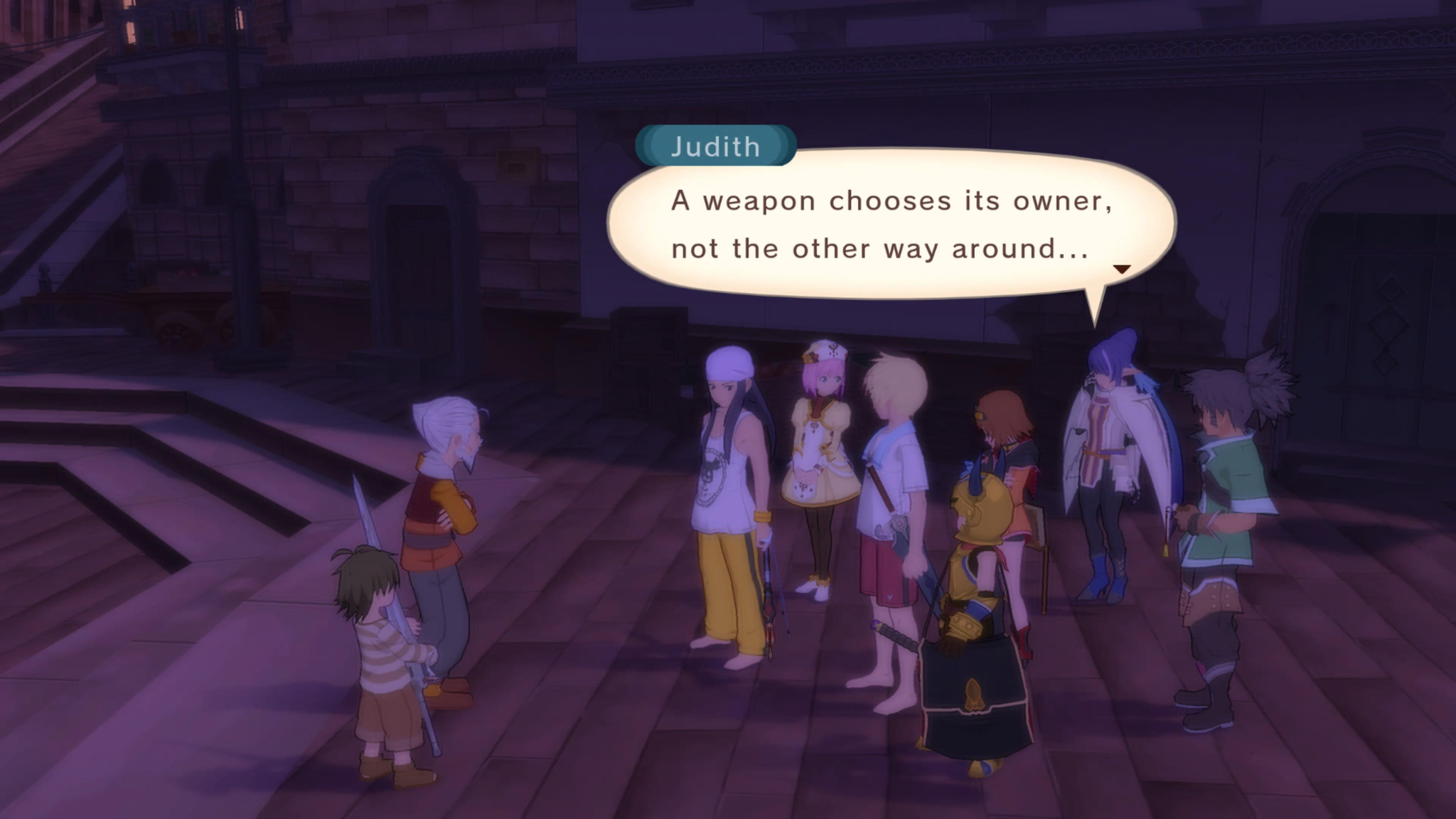
Judith opines on the relationship between weapon and user as Yuri inherits Claiomh Solais from the lower quarter.
I want to convince you that these two Tales games thread the needle of individual agency between the two existential poles that threaten to render our personal choices inert: the threat of the world’s past entirely determining its future, and the threat of world events being too purely stochastic to respond to any principled, guidance influence from an actor within that world. By analyzing the personal growth of each game’s party in parallel, we unlock a model for how individuals can change the world by (1) releasing the grip of history on the present and (2) supporting others in their personal journey to decide what they care about independently of any historical context. In so doing, we discover not only a principle of action we can apply in our lives beyond these games, but also a lens through which to understand and share the unique value of our playthroughs without erasing the narrative value common to all playthroughs of video games.
This study is forged in 3 parts:
- I first motivate and analyze “the symbology of the swords,” the nature and thematic content of the Swordians and Dein Nomos in Tales of Destiny and Tales of Vesperia. I argue that the Swordians represent a method of agency that allows the wielder to be motivated by the past without reducing herself to the past, whereas Dein Nomos represents a method of coordinating collective action by empowering the personal narratives of diverse individuals on their own terms.
- I then trace the development of the swords’ symbology across the plots and conflicts of each game, each broken down into 3 “acts” according to the antagonists around which each successive conflict is organized. I argue that both Tales of Destiny and Tales of Vesperia illustrate characters that develop their own principles of action—and, ultimately, the ability to shape their world’s future. In both games, this is achieved through a progression from (1) overcoming personal inertia by undertaking an instrumental quest through which one uncovers one’s desires, to (2) experiencing betrayal as a means of clarifying how one’s desires relates to those of other agents, to (3) empowering and situating the stories of everyone other than oneself within their proper contexts.
- I finally step outside of the games’ plot and argue that their structure and avenues for player choice empower us, the real players of Tales of Destiny and Tales of Vesperia, to learn and enact the games’ praxis as we play them, using their optional characters and optional storylines to define our own relationship with the overall narrative according to our specific playthroughs, without thereby invalidating the principles of action motivating specific characters or other players.
When all is said and done, we arrive at a perspective on the Tales armory that rejects all flavors of fatalism in favor of clear, practical methods for reshaping the world by witnessing and catalyzing the mosaic of every willful agent who inhabits it.
(Note: this study specifically treats the English releases of Tales of Destiny for the PlayStation (1998) and Tales of Vesperia: Definitive Edition for the PlayStation 4 (2019).[2])
Swordians and Dein Nomos as Principles of Volition in Tales of Destiny and Tales of Vesperia
To wield a sword is to take up an instrument forged by a community, for the sake of your individual maxims.

Swordian Dymlos (left) and Dein Nomos (right), official artwork.
While magical, plot-centric swords are common across stories and Tales games alike,[3] the Swordians and Dein Nomos have an intimate connection: they are both artifacts of the energies that have animated their worlds, and they are the tools with the power to liberate their worlds from dependence on that energy. In the hands of the enlightened wielder, they replace the animus whence they came with a more personal and transparent motive force: human will. By analyzing the ontology of each type of sword—what it is, what it does, and how it came to be—we can interpret them as symbols for particular systems of agency within each story, enabling their wielders to achieve particular ends in the same way that a sword literally functions as a tool for advancing and defending one’s agenda. When we then turn to the plot of each story, we’ll see that these symbols can function as ciphers for interpreting how our heroes empower themselves, each other, and the world to determine their own future based on nothing other than clear-minded, individual volition.
Swordians Bridging Past and Present in Tales of Destiny

The Aethersphere reasserting itself over the planet as Hugo’s plan comes to fruition in Tales of Destiny.
The world of Tales of Destiny is one in which the course of society, economics, and world events are shaped by a foreign energy: Lens, derived from the comet that hit the planet over 1000 years before the events of the game—making magitechnology possible, but also devastating the planet’s ecosystem, seeding the disparity that would color the future trajectory of the world onward from the point at which those who left to live in an elevated Aethersphere, the Aetherians, enslaved those Er’thers left behind on the surface. The Lens fuel everything from monsters, to monster barriers, to weapons of mass destruction like Belcrant—to the Swordians, sentient swords developed by repentant Aetherians who defected back to the planet in an effort to overthrow the fascist regime of Kronos’ Aethersphere.
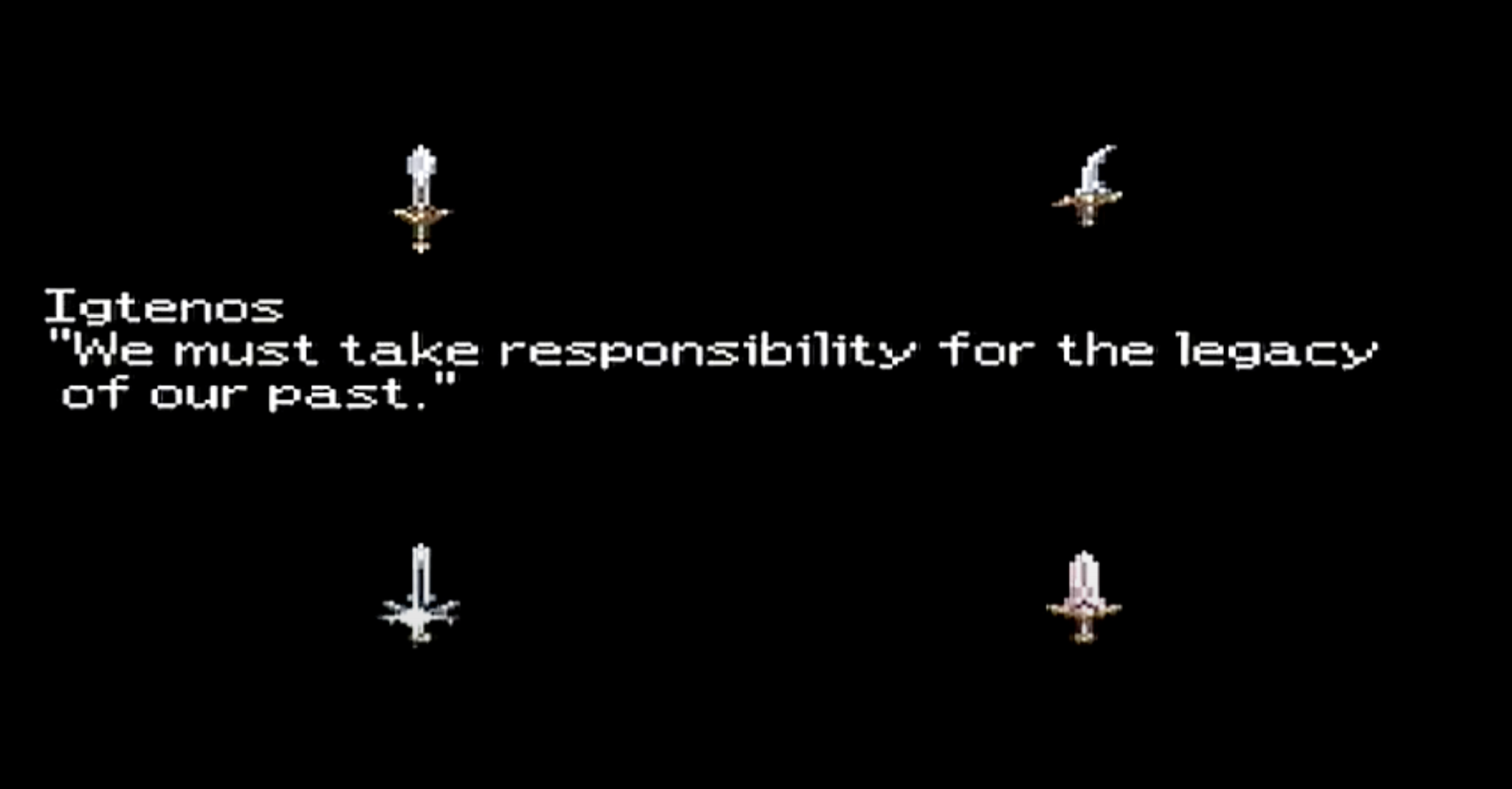
Igtenos reflects with fellow Swordians Dymlos, Atwight, and Clemente as they prepare to resolve their history from the Aeth’er Wars.
The Swordians, like the Lens from which they are derived, reach backward to a foreign world in order to serve as tools in their present-tense context. Their Core Crystals store imprints of human personalities, turning heroes from the 1000-year-old Aeth’er Wars into tools to empower those who can hear their voices and use their abilities in the present. In only the second entry in the Tales series, Namco created a format for bringing 8 party members into battle at once: 4 humans, Swordian masters, equipped 4 with Swordians—weapons, but weapons with a point of view, the ability to use equipment (Aura Discs), and gaining experience to unlock new spells and parameter increases. These living swords await those who are apt to relate to them, and they empower those “masters” to pursue and succeed in their own missions—all despite the fact that these swords were forged and defined by a mission from an entirely different era than the masters.
Symbolically, these Swordians represent conflicts from the past empowering new principles of action in the present. The obstacle to overcome in successfully availing oneself of this tool, we’ll see, is in understanding how to relate one’s activity to the past without collapsing into the history that preceded one.
Dein Nomos Bridging Individuals with Community
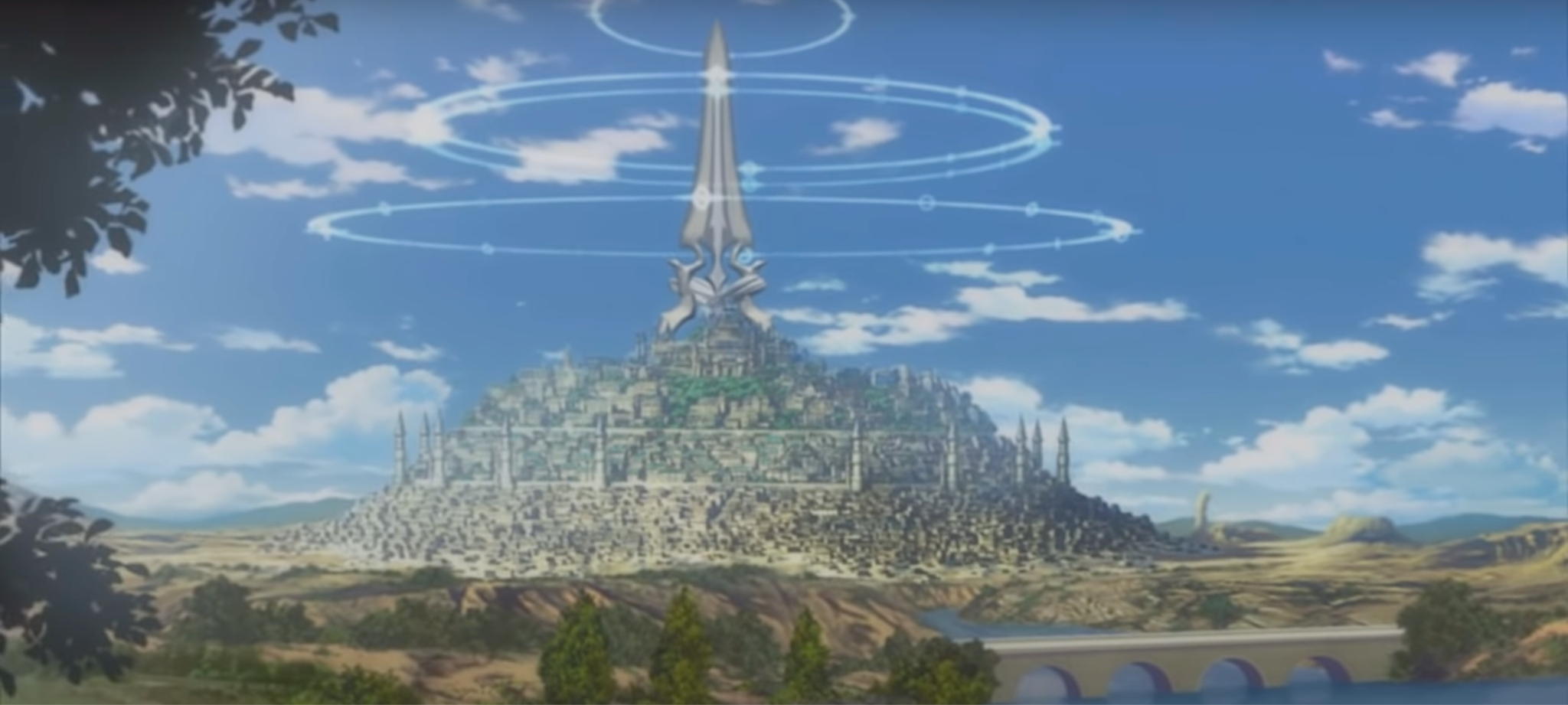
The Imperial Capital of Zaphias shielded by its barrier blastia, as seen during our introduction to Terca Lumireis at the start of Tales of Vesperia.
Tales of Vesperia introduces us to Terca Lumireis, a world animated by chaos. Humans have protected themselves from monsters, waged war against each other, and advanced society by manipulating aer, a substance defined more so by its functions and consequences than by its origin or essential attributes. Aer is introduced to us as a source of “primeval power” which emanates from Terca Lumireis through the natural springs of aer krene, and we eventually come to know it as “the lifeblood of this world”: the “sublimation, reduction, formation, and dispersion” of aer’s distinct and diffuse elemental forces undergirds all of existence and the very possibility of the material world.
Humans manipulate aer by interjecting themselves and their desires into Terca Lumireis’ natural ecosystem, repurposing apatheia—the ensouled masses of aer coagulated within Entelexeia, the species that monitors and regulates fluctuations in the flow from aer krene—to craft blastia, gems that yield certain effects by expending aer according to specific, engraved formulae. The rise of a blastia-dependent human civilization disrupts the natural balance of aer in the world, causing aer krene to overproduce aer to the point of toxicity, metamorphosing the Entelexeia into constituents of the Adephagos, a world-enveloping cataclysm that consumes the technology and society that begets the surplus.
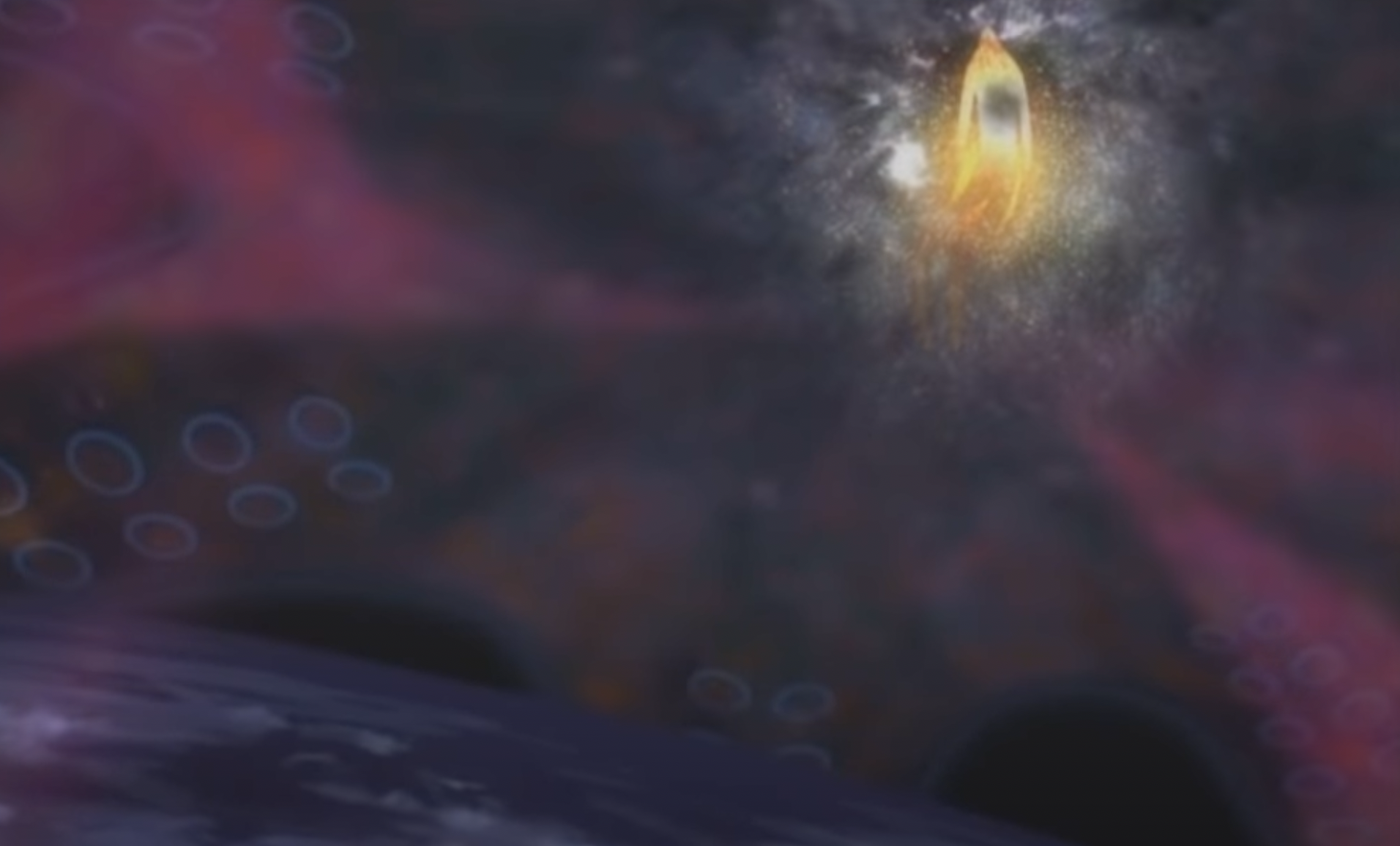
The Adephagos, as witnessed in Duke and the party’s final confrontation with it at the climax of Tales of Vesperia.
Already, it’s evident that the nature of Tales of Vesperia’s world is more complex than that of Tales of Destiny‘s, and that difference is crucial in their representation of different kinds of inertia which the protagonists must overcome in order to claim their individual volition. Where Tales of Destiny’s players and characters are primarily kept in the dark as to the question of who stands in what relationship to which segments of the world’s relatively simple history, Tales of Vesperia’s players and characters are constantly trying to locate themselves within chaos. The history of Terca Lumireis is itself one of humans struggling to find a foothold from which to establish a sense of stability in a world with primeval, undirected elemental energy, and monsters with which rational communication is impossible. In the midst of such entropic origins, even our ability to access and understand history is limited: the Great War that transpired only a decade before the events of the story is a veiled conflict that doesn’t receive a full explanation by the end of the game;[4] where Tales of Destiny features a literal Tower of Knowledge and journeys to meet the characters and explore the central set-pieces of the world’s history, Tales of Vesperia leaves us and its heroes to uncover anecdotes about world history and ecology from second-hand sources like fairy tales, esoteric murals, and Entelexeia, distrustful guardians of the world order who act as much by evolutionary instinct as by rational deliberation.
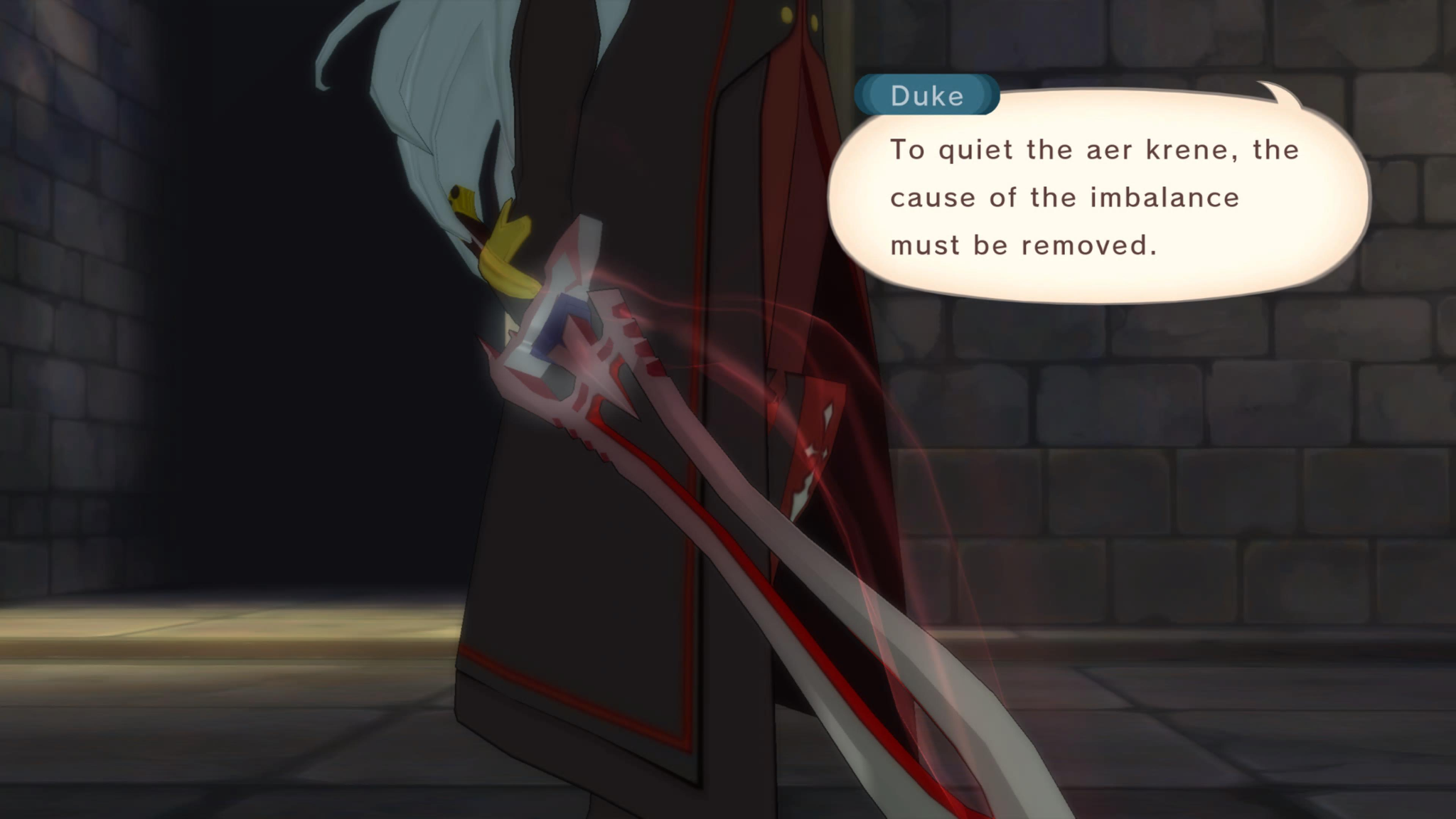
Duke expresses the praxis of Dein Nomos as he sees it, as he and the party approach Alexei and a kidnapped Estelle in the Shrine of Baction.
Individuals make sense of this chaos through the same approach embodied by the nageeg, the Krityan exegetical practice of using an incantation to unlock stories contained within objects. When the party needs to know how to guide their actions to help Estelle and cope with excess aer, Judith is able to draw a practical meaning out of the lore contained in Myorzo’s mural with the nageeg. Dein Nomos is an embodiment of this principle: it cuts through the chaos of the world by coordinating various, otherwise chaotic elements of the world in accordance with a single principle of action. Most literally, the bonafide Dein Nomos mitigates chaos by quieting overtaxed fonts of aer, and serves as the “key” to the tack humanity took in escaping their pure dissolution into entropy after the first appearance of the Adephagos in ages past: the key to Zaude, the enormous defensive blastia that suppressed the Adephagos, and proof of the lineage of surviving Children of the Full Moon, those people with the ability to directly manipulate aer who fueled Zaude and begot the bloodline that would birth the Imperial Royal Family thereafter.
But the irony of Dein Nomos is that at the very same time as it is a unique sword with a central role in human history, the universe of Tales of Vesperia is riddled with individuals working to create and/or wield their own “Dein Nomos”: either an overt copy of the royal sword, a functionally equivalent sword, or a different unique sword with similar symbolism (e.g., Claiomh Solais, Rag Querion). In all of these cases, from Alexei’s False Dein Nomos to Brave Vesperia’s Vesperia No. 2, the wielder seeks to enact a certain activity, a certain worldview, through the support of a wide range of other individuals—though whether those individuals are willing or unwilling, present or past, are factors that vary widely, illuminating the path by which one can arrive at radical individualism by interrogating the missteps one can take along the way.
Symbolically, Dein Nomos, in all its forms, represents the collective will of a community to enact a specific principle of will in the world—to legislate oneself according to a collectively defined law, or ‘nomos’ in Greek. This sword is forged by many individuals with their own reasons for supporting its use, yet it is the kind of thing that can only be wielded by one person at a time—the instrument of one person who motivates and inherits the intentions of many, without erasing the unique desires of community members in service of the collective.
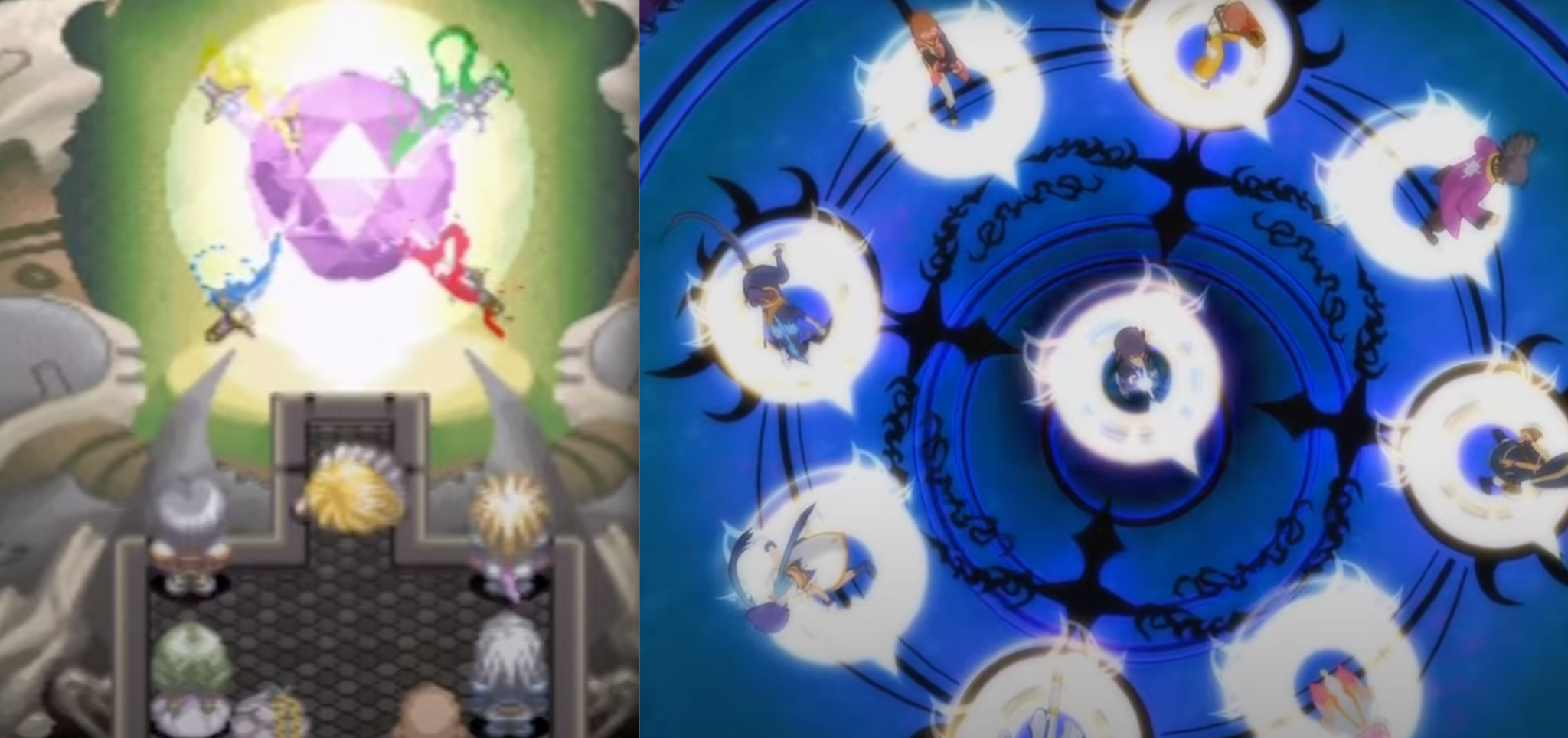
Left: Stahn and the other Swordian masters let their Swordians go for the sake of annihilating the Eye of Atamoni. Right: Brave Vesperia and its affiliates pool their individual life energy to collectively fuel Brave Vesperia No. 2 and transform the Adephagos.
On this reading of the swords, it’s no coincidence that human lifeforce is just as capable as providing and channeling energy as aer; it’s no coincidence that the Swordians’ journey ends with the collective sacrifice of their lives in exchange for the Eye of Atamoni’s destruction. The joint lesson of Tales of Destiny and Tales of Vesperia is that the free, intentional expression of one’s own life requires understanding and supporting the lives and intentionality of others: self-determination is possible, but not in a vacuum.
Learning How to Wield the Sword: Progressing from Inertia to Radical Individualism through the Plots of Tales of Destiny and Tales of Vesperia
Tales of Destiny and Tales of Vesperia are a remarkable duology because they show how to logically progress from a total sense of personal disorientation to a justified, beneficent ethos which one can consistently impose on the world beyond oneself. The journey to radical individualism from a complete lack of self-determinism is one that must occur piecemeal.
For the arrival at this kind of personal autonomy to be meaningful, the agent must begin his journey from a position of fatalism: the complete lack of confidence in one’s choices to influence the course of one’s life and the world’s trajectory. The value of reading Tales of Destiny and Tales of Vesperia in conversation with each other comes from their antithetical yet complementary approaches to this journey. Both jostle their heroes out of inertia, but Tales of Destiny situates its heroes in an idle inertia, whereas Tales of Vesperia presents its heroes in a directionless course of action with no reason to correct their trajectory.

A world of new possibilities bursts forth from its confines within the oppressive, historical influence of the Aethersphere at the end of Tales of Destiny.
The parallelism of the remedy in these cases shows that a single kind of willpower can cure us of the full manifold of existential paralysis we might encounter in our lives: through a measured progression from (1) instrumental activity to (2) betrayal to (3) intrinsic recognition and support of others, we can define and enact our will as something that makes a metaphysical difference to world history, actuating itself in the conceptual space between the two poles of (A) a fully deterministic, “destined” model of events, and (B) a completely chaotic and random evolution of actions which could not be coordinated for any collective purpose.
To reach and understand the content of this praxis, we’ll consider the three “acts” of each game in parallel: the struggle between the heroes and the first villain, the confrontation between the heroes and the puppetmaster of the first villain, and the finale between the heroes and the final obstacle to their fully actualized individualism.
Act 1: Overcoming Inertia through Instrumentalism
How do you discover your agency, your reasons for action, in a world that factors you out of your own life’s trajectory?
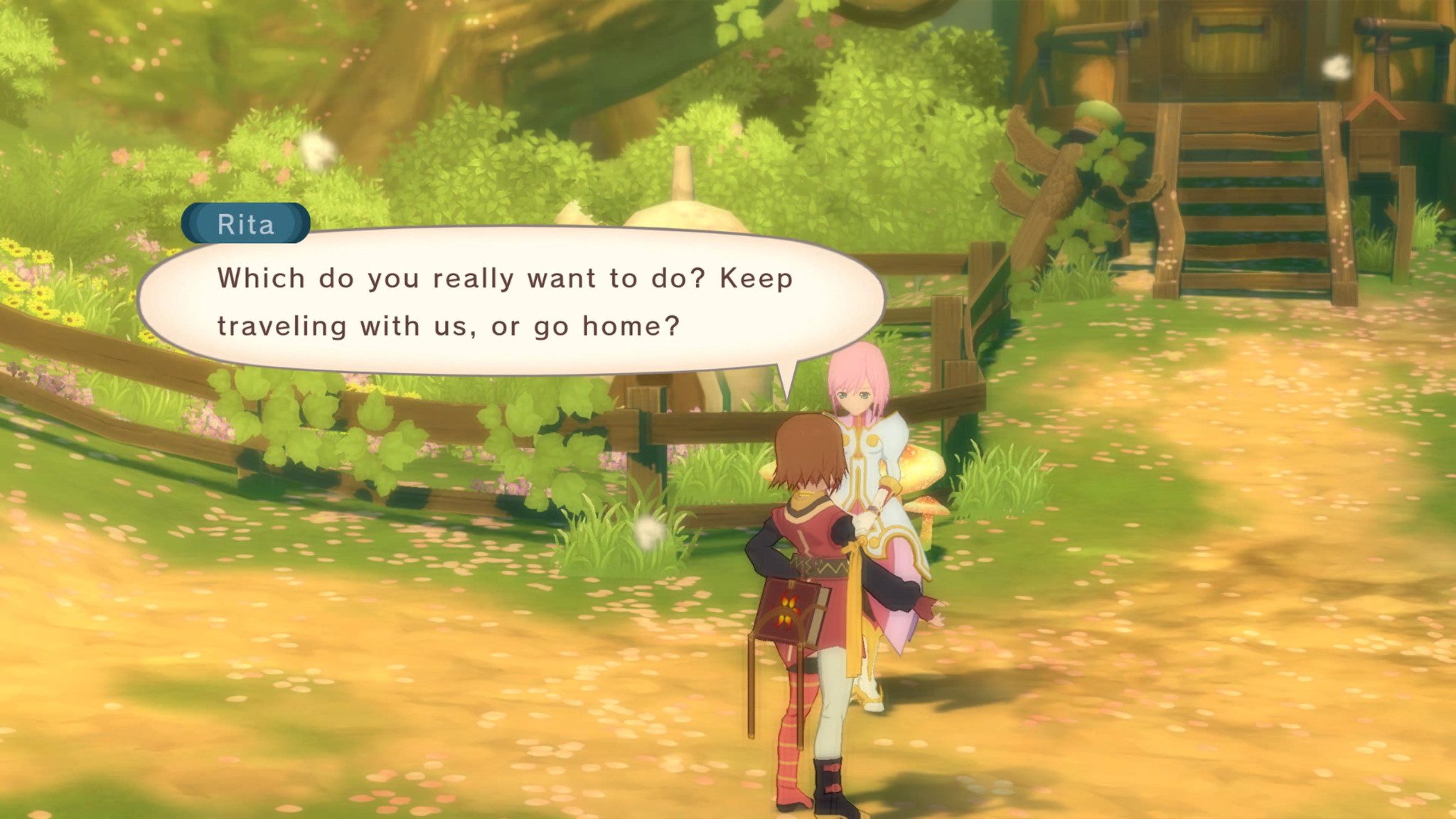
Rita prompts Estelle to self-consciously consider her future course on the party’s way from Halure to Capua Nor in Tales of Vesperia.
Before you can take up a sword, you need clarity on your reason for doing so. Tales of Destiny and Tales of Vesperia illustrate that this initial call to action looks remarkably similar whether one finds oneself subordinate to the past or lost in the noise of the present. In either case, awakening the protagonists’ internal motives requires connecting their conception of their own actions with a finite model for the motivation and impact of those actions on the world. By presenting the heroes to themselves and each other as instruments, the story invites them to evaluate their genuine motivations and how they want their lives to impact the world beyond themselves.
Tales of Destiny: Contextual Dishonesty
The most efficient way of connecting past context with present action is convincing current heroes that their actions are destined.
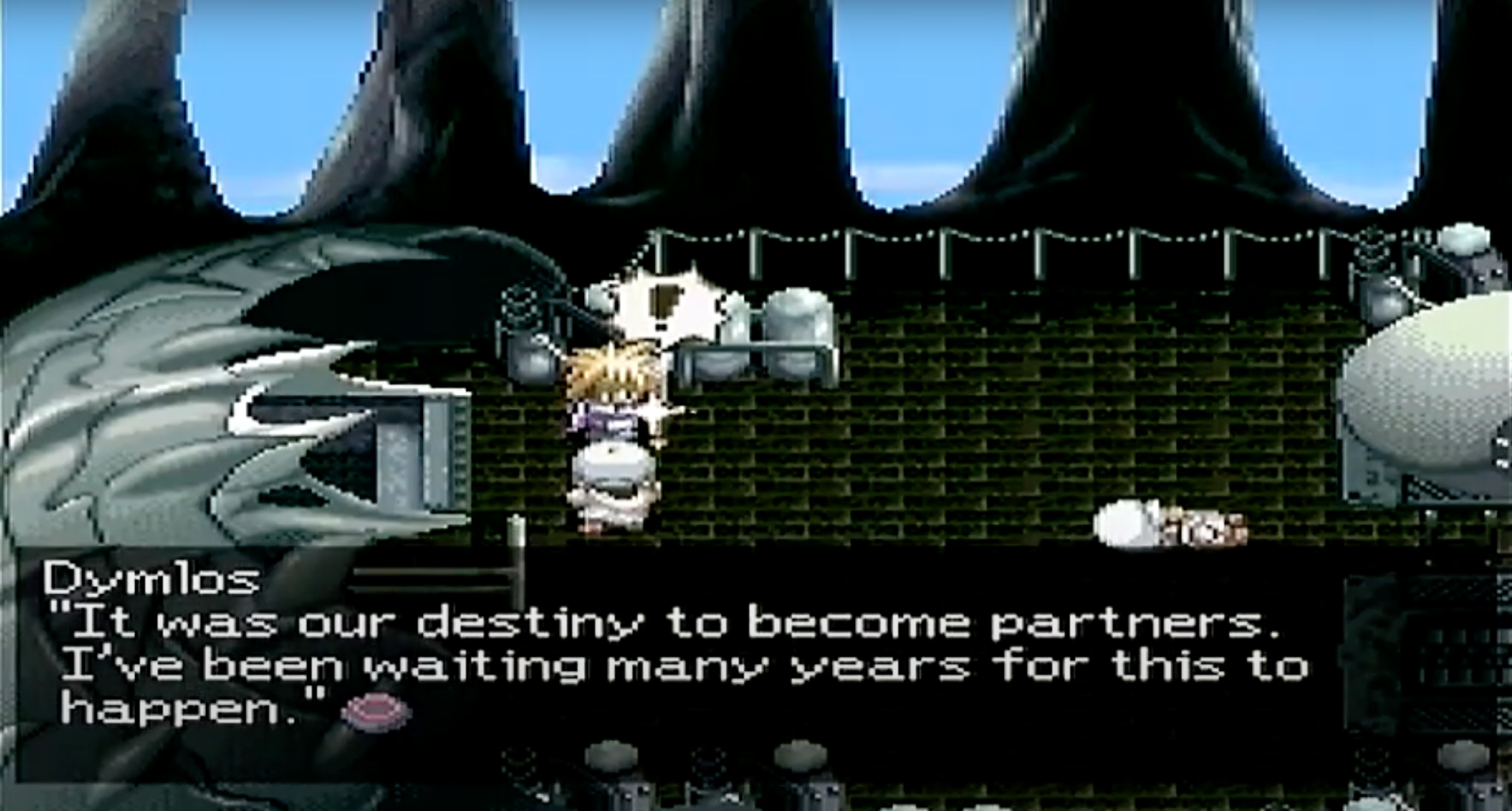
Dymlos motivates Stahn into getting both of them off of the Draconis and onto their mutual story by deceiving him, claiming that Stahn and he were destined to meet and unite.
Tales of Destiny opens on a set of human heroes who all need to be called to action to overcome the inertia of their idle states:
- Stahn, through whom the plot is focalized, identifies his goal in leaving his small-town country origin to be “see[ing] the world and maybe becom[ing] rich and famous along the way.”
- Garr is in a kind of self-imposed exile from his princely duties in Phandaria, instead studying archery in the mountains under Alba.
- Rutee is seeking Lens, treasure, and money in an ad hoc way with an amnesiac, trying to save the Cresta orphanage, in which she was raised, from demolition, with no clear plan for doing so—more of a “money-obsessed maniac,” in Atwight’s words, than a proper savior.
- Philia is literally petrified and figuratively paralyzed, her faith upended by a schism with her spiritual leaders, Lydon and Batista, along with the weaponization of a religious object, the Eye of Atamoni.
Those with no clearly defined principle of action guiding their lives are apt to be manipulated by others who instill them with a “purpose” in the form of a quest with ulterior motives, and Tales of Destiny’s first act is saturated with this kind of manipulation from both heroes and villains. High Priest Lydon Bernhardt, in his efforts to seize the Eye of Atamoni’s power and dominate the kingdoms of the world with a monster army, uses religious followers like Batista and political aspirants like King Tiberius as pawns to conquer territory and effect his relocation with the Eye of Atamoni to Phandaria. The heroes’ journey itself begins as something between a hostage situation and a fetch quest, led by Leon (another character with ulterior motives) by order of the Kingdom of Seinegald, under threat of electric-shock tiaras and the promise of financial reward, to retrieve the Eye of Atamoni from Lydon.
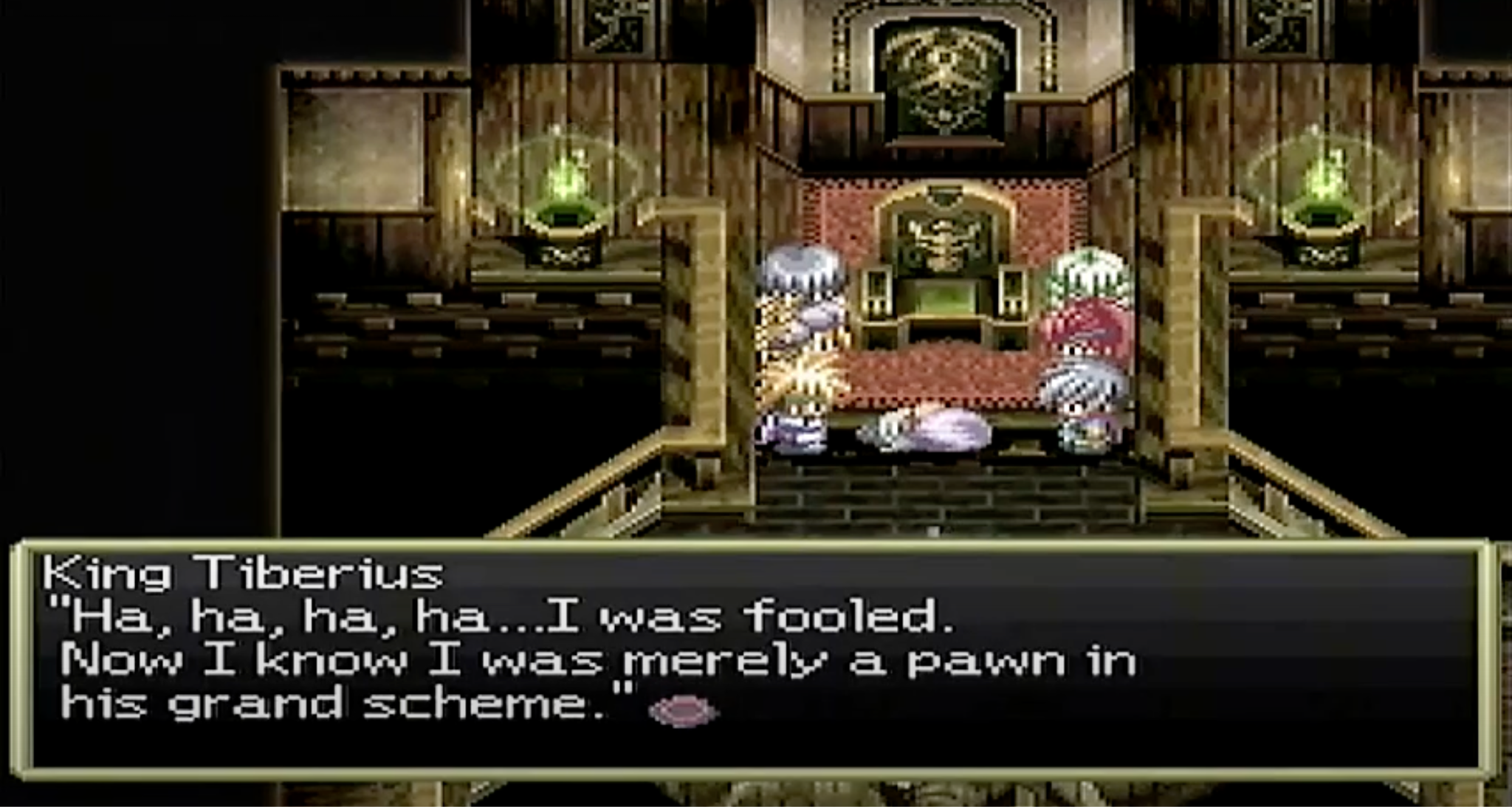
Following his defeat at the hands of the party, Tiberius rues that his ambitions turned him into one of Lydon’s tools.
Most saliently for our purposes, three swords call out to their new masters and empower them to act, all the while hiding their true mission to destroy the Eye of Atamoni. The Swordians Dymlos, Atwight, and Clemente motivate Stahn, Rutee, and Philia to inadvertently advance the Swordians’ agenda by articulating the special roles that these human masters have to play in the world, absent any particular objectives the weapons might have: Clemente tells Philia that he has awoken “a hidden skill within [her]” and that she will conquer “many trials” which lie ahead of her; even Atwight, saddled with the more reserved Rutee who refuses to open her mind to her Swordian, motivates Rutee through her (Atwight’s) instrumental utility to her, casually mentioning that Rutee would be “a defenseless girl” if she didn’t have a Swordian, as well as motivating a collaboration between her master and Dymlos’ by saying that “[i]t would feel safer if Dymlos was with us.”
The Swordians—these unresolved conflicts of the past, lacking the autonomy to see their missions through on their own—are left to tell a kind of half-truth to their masters, inspiring them to overcome their inertia without illuminating the stake they have in their masters’ activity. This is an intuitive place for the masters’ self-actualization to begin: before they can relate their experiences to those of anyone else, they need to clarify their own desires and intentions in the present-tense of their lives. Conceiving of their relationships with the actions of history is a vacuous exercise without a point of reference in their present-day identities. Thus:
- Philia draws strength from Clemente’s paradigm of her hidden skill and promised trials to evolve from (1) a position of inert submission to Atamoni to (2) a personal relationship with Atamoni based on belief in the innate kindness of the world, asserting her newly articulated values in the face of priests and her own mentor, Batista.
- Rutee recognizes that the utility of others, like Atwight to her, is valuable for others’ own purposes and not necessarily something to be co-opted by her, leading her to counsel Mary, her first companion, to stay behind and “treat the wound in Dalis’ soul” after Mary and Dalis, Mary’s husband, recover their memories, as that is “something [Mary] can do that other people can’t”; subsequently, we witness Rutee finally finding the presence of self to confess to Stahn why she’d been seeking money all along.
- Stahn, acknowledged by Dymlos as someone who “seem[s] like a good person” for all his naivete, extends that same recognition and encouragement to virtually everyone else he encounters, quickly reconfiguring his journey from something that inertly gestures at ambition (“and maybe become rich and famous along the way”[5]) to something that finds its purpose in those with whom Stahn surrounds himself: he acknowledges and vocalizes the kindness in Rutee when she stands up for bullied orphans in Neuestadt without a utilitarian agenda, well before she’s ready to admit her origins and motives; when Philia is ready to collapse into her own naivete for having trusted Batista, Stahn recognizes that she’s not naive, but rather kind, paving the way for her personal understanding of Atamoni; he welcomes Karyl into the party in Aquaveil without a second thought despite Karyl’s personal motivation to save his best friend rather than prioritizing the defeat of Lydon, telling his comrades that “it’s better to have more people on our side” and it should “count for something” that he facilitated their escape from guards upon their arrival in Aquaveil; he even asserts his friendship to Leon at the last, upon their return to Seinegald after defeating Lydon, in the face of Leon’s physical nausea from air travel and psychic nausea at being forced, for reasons yet unclear, to callously deceive and manipulate everyone around him.
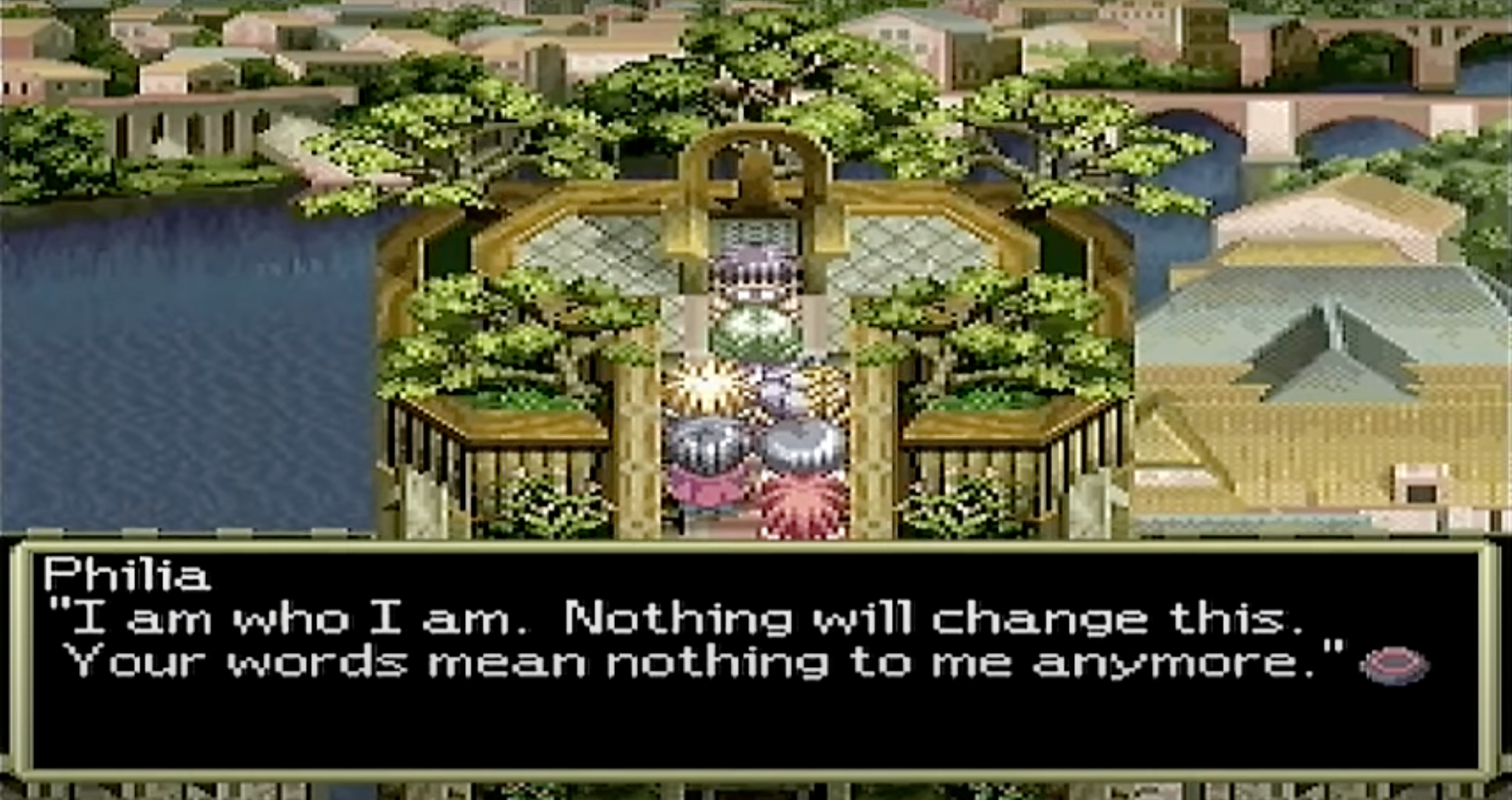
Philia asserts her new understanding of Atamoni as universal kindness to her former religious mentor, now puppet of Lydon, Batista.
We identified the Swordians as symbolizing conflicts from the past empowering new principles of action in the present. At this first stage in the development of these principles of action, these tools turn sheltered individuals into sword-wielders by providing them with a framework to orient themselves in their present world, remaining deceptively silent about the historical influence impressing its gravity upon that world and its people. In this first act, the Swordians are remarkably similar to another sword: the nameless blade borne by an amnesiac Mary, acting as a tool for her to help the party in their current mission against Lydon while binding her to a past which she cannot access alone.
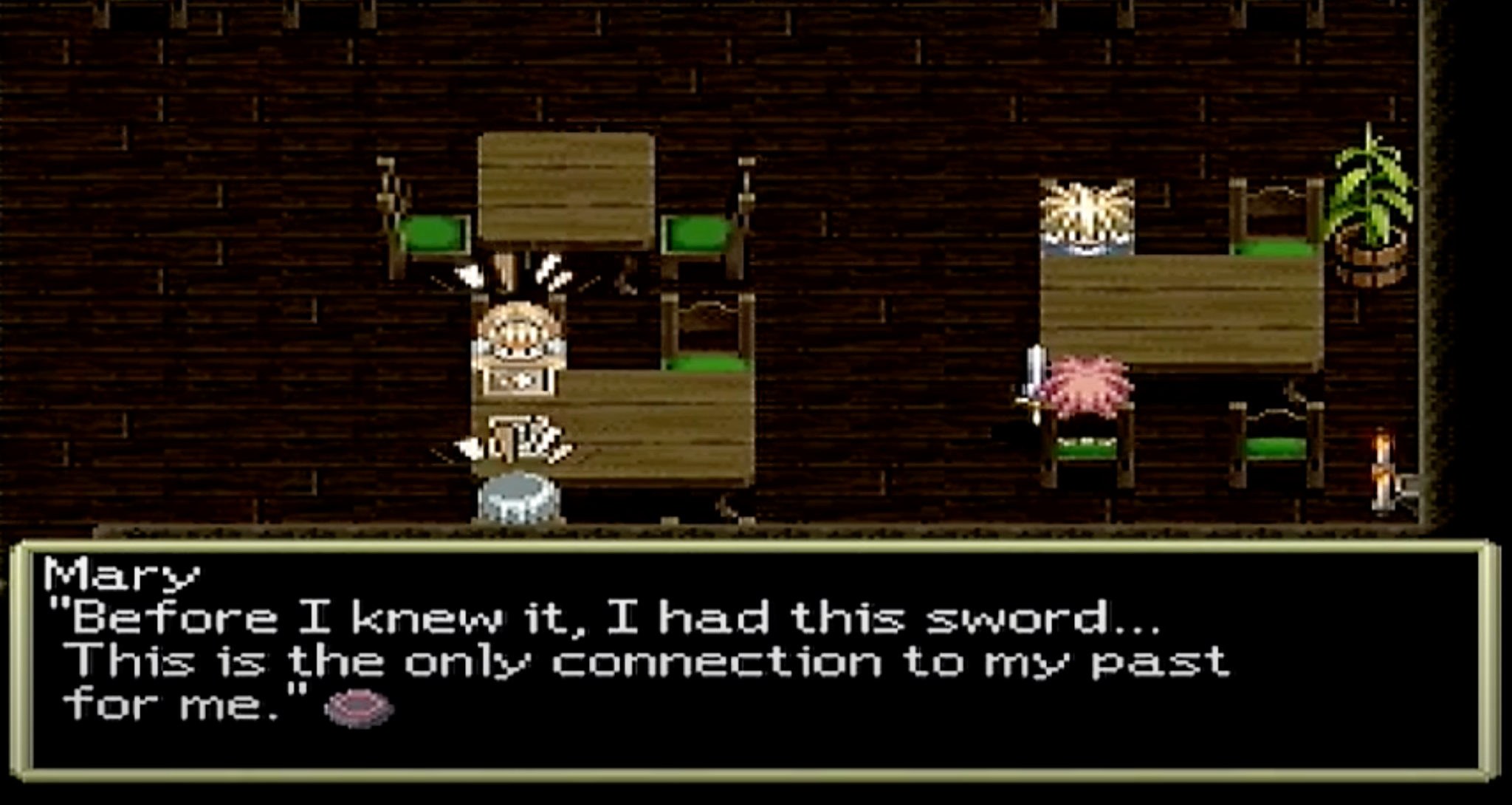
Mary shows Stahn her sword, her one link to an unknowable past.
The antagonist of each act in Tales of Destiny and Tales of Vesperia shows us the limitations of the party’s current agency and what they must overcome in order to reach the next stage of defining and enacting their volition. Tales of Destiny begins this dialectic with the portrait of Lydon: he wields a critically damaged version of the Swordian Igtenos, with no sentience that could begin to articulate the relationship between Lydon’s present plot and the history within which Igtenos was forged. In the absence of a robust understanding of the relationship between one’s actions and the actors of the past, one’s goals in life assume a kind of toxic timelessness: like a corrupted priest obsessed with an esoteric religious artifact, the agent’s perspective on her actions transcends any particular historical context, leaving her vulnerable to being consumed by the historical relevance she fails to see in her own tools—as Lydon is when he is unceremoniously swallowed up by the Eye of Atamoni, that historical relic which he took to be proof of his divine right to supreme power (a denouement that occurs, fittingly, in the middle of an enormous clock face, the irony of which Lydon could never grasp).
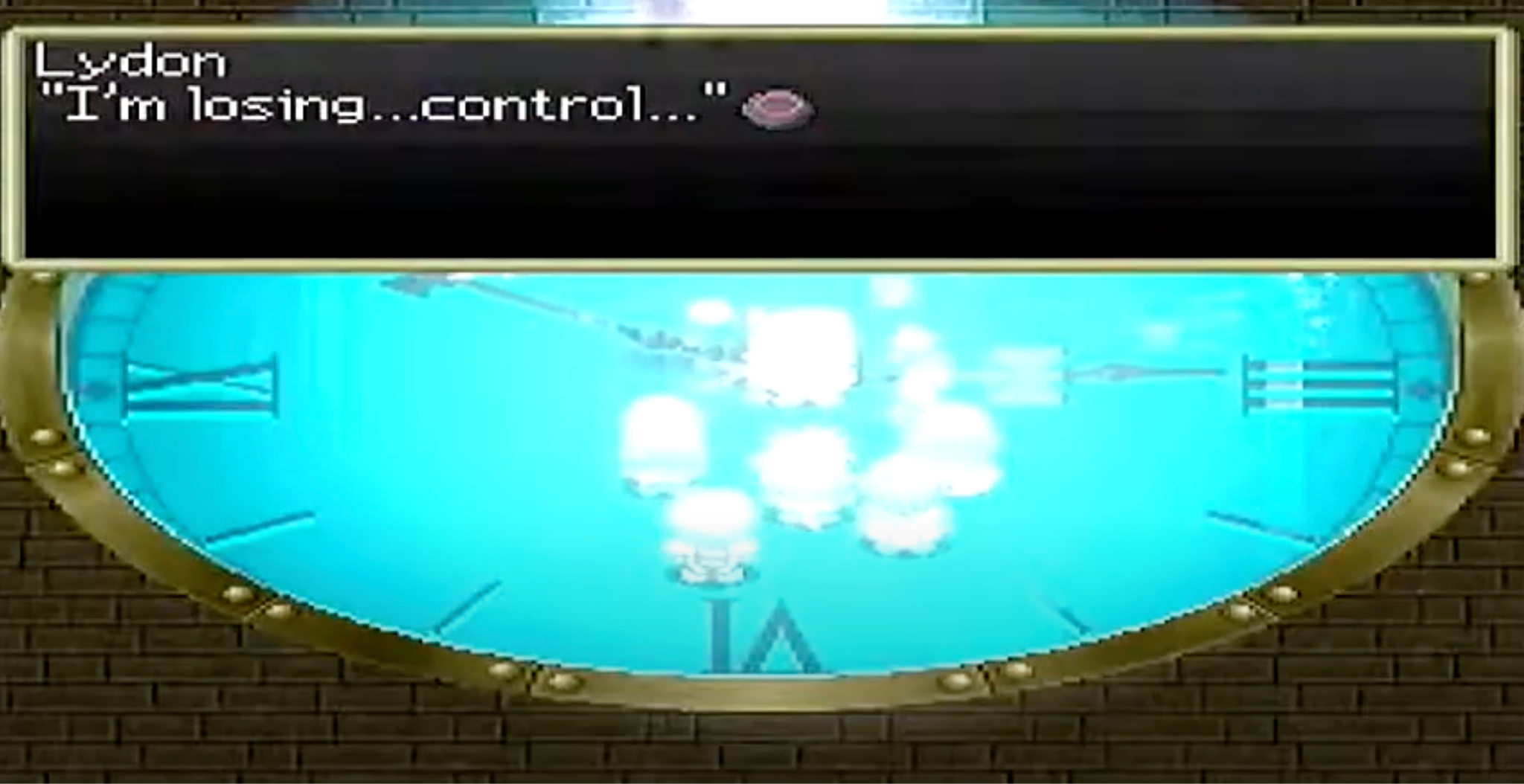
Lydon is overtaken by the power of the Eye of Atamoni, a historical tool he does not understand, at Heidelberg Castle before the party’s eyes.
It’s no wonder, then, that this first step in the heroes’ journey, which must begin with their finding a sense of self in an ahistorical present, is also rife with those who take advantage of that ahistoricism for reasons more malicious than the Swordians. Hugo Gilchrist’s vision for the world’s future shapes the Oberon Corporation into a global institution using Lens, objects of the past, to manipulate the course of international events; Leon’s attachment to his own past shapes him into a broken traitor in the party’s midst; in the background, Kronos looms over them all, even the Swordians, invoking the past most unambiguously through means entirely opaque to our temporally muddled party. The Swordians had to begin their relationships with their masters from a position of contextual dishonesty, but it’s also this lack of honest communication that makes possible Leon’s final con, putting the Swordians into stasis with clandestine Aura Discs and lying that they fell silent because their innate purpose had been fulfilled.
To shape the future through their individual principles of will, Stahn and his friends must learn how to become more honest about the different contexts in which their wills and their tools are embedded.
Tales of Vesperia: Chaotic Self-Discovery
When your world is too chaotic to locate yourself within it, sometimes the best you can do is to choose a “flow” in the streams of chaos within which to cast your lot.
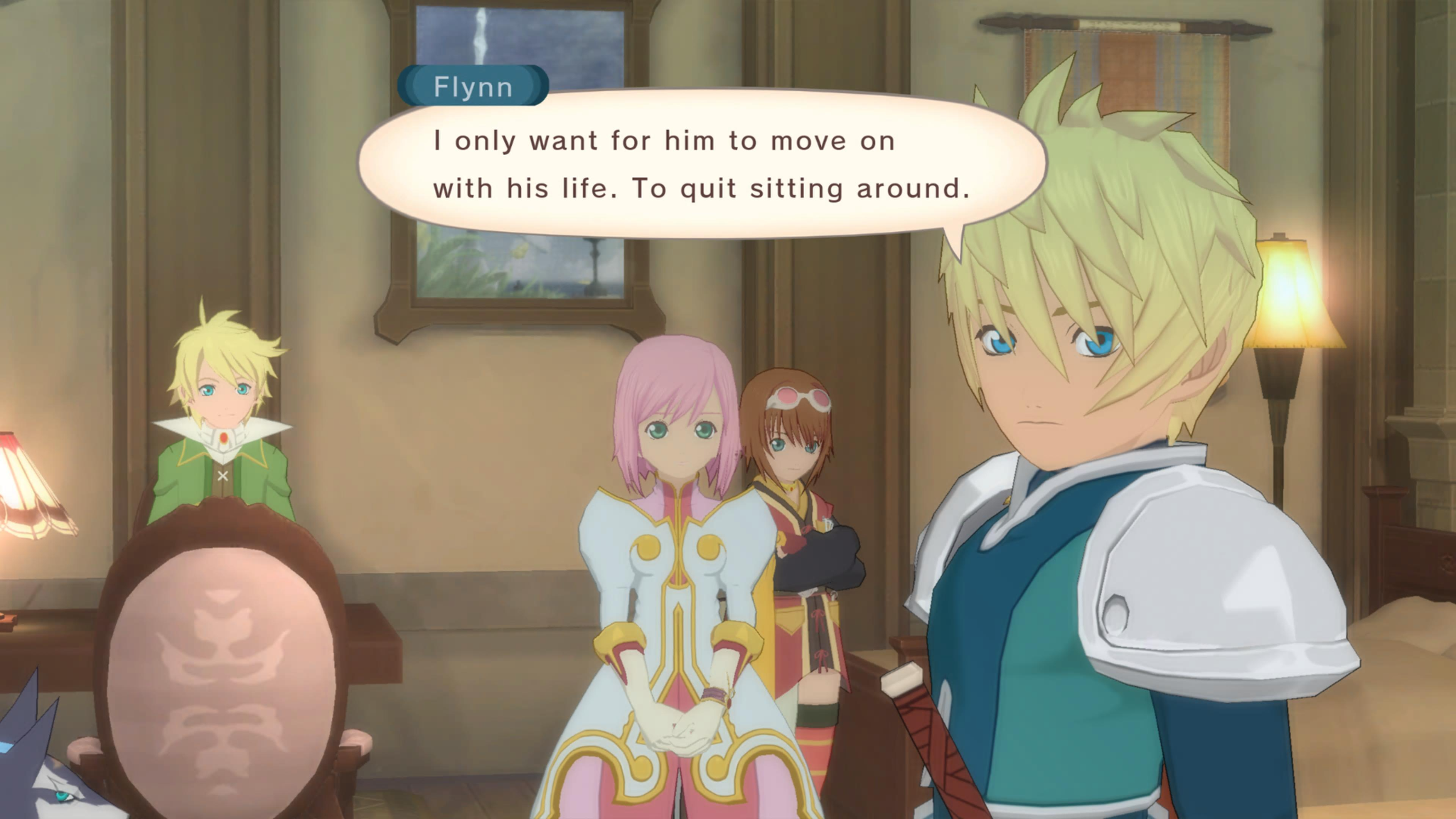
In Capua Torim, Flynn bemoans Yuri’s inertia in the time since he rejected the path of a Knight without undertaking an alternative positive course of action.
Where Tales of Destiny opened on characters that were inert in the sense of not moving in any clearly defined direction, Tales of Vesperia opens on a cast that is inert in the sense of carrying on with a course of action which they didn’t positively choose to undertake based on their desires. Each member of the party is guiding their actions based on what they don’t want to do in the world rather than something they want to do:
- Yuri has rejected the path of the Imperial Knights, living in Zaphias’ lower quarter in the absence of the direction the Knights provide their members.
- According to Yuri, Repede “doesn’t think of himself as a dog,” which is “why he uses weapons and items.”
- Karol is constantly running away from, or rejected by, the guilds that take him in, seeking a home only to find places and worldviews in which he does not fit.
- Estelle jumps at the prospect of a journey that will justify leaving her seclusion in the castle.
- Rita withdraws herself from the uncertainty and potential for abandonment and betrayal that come with human relationships.
- Judith is “cleaning up the mess” of her father’s Hermes blastia “before anyone [can notice],” erasing the legacy of her family.
This might seem like a more decisive set of activities than Stahn and his friends’ at the beginning of Tales of Destiny, but it doesn’t go any further distance toward defining these characters’ individual principles of will: to define oneself solely through the rejection of one principle of action, particularly in a world with a diverse range of obscurely interrelated factions and possible modes of engagement, is to lose oneself in the deluge of all other possibilities, with no promise of a coherent path that will yield personal insight or impact. But this kind of inertia does provide a different developmental path than Stahn and the Swordians have available to them: rather than being manipulated by others into acting from unclear contexts, they can send themselves on instrumental quests with no clear promise of a broader mission or intrinsic fulfillment, and set themselves up to clarify their personal motivations and desires through the pursuit of that quest’s finite objective.
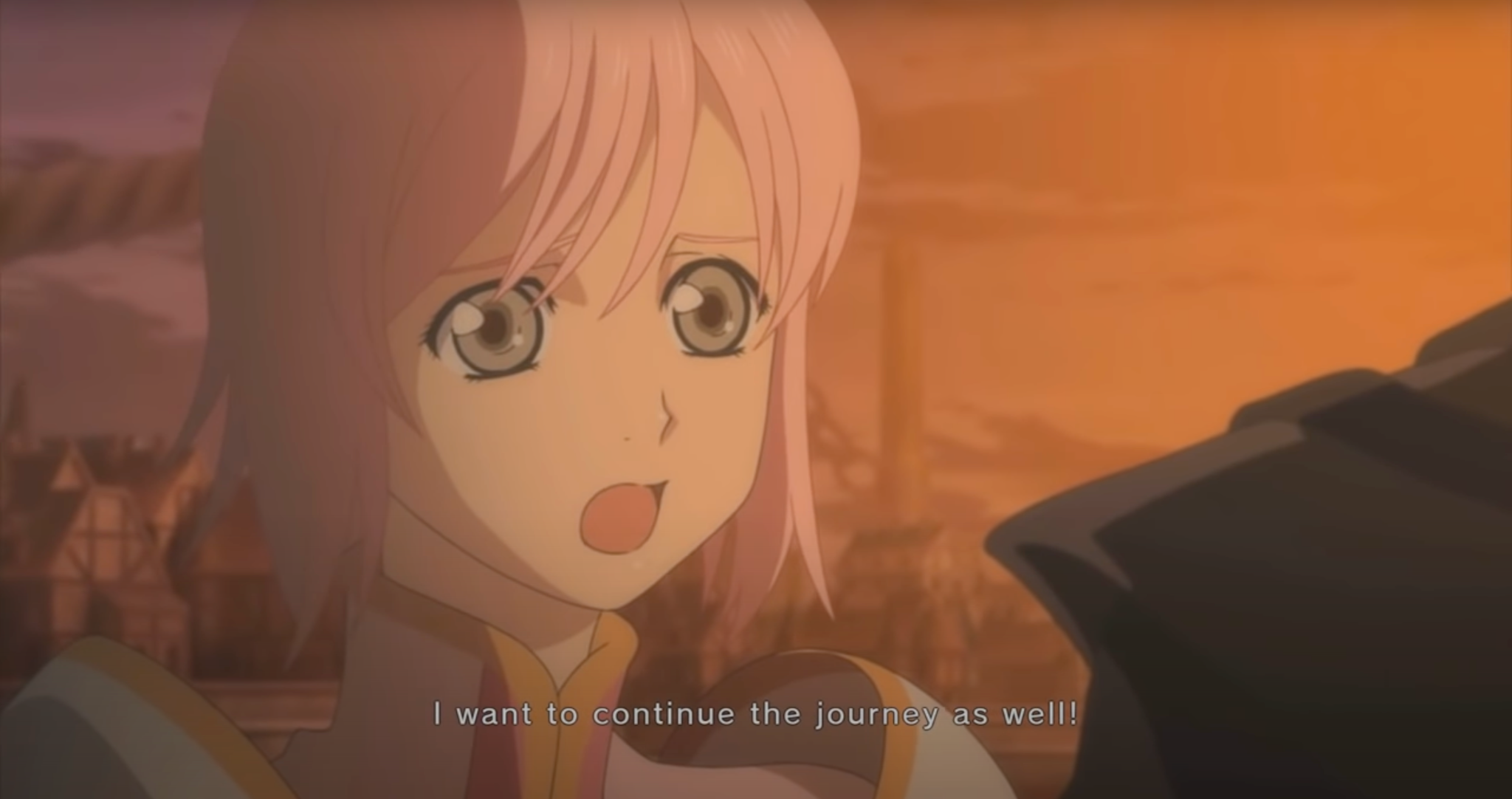
At the end of Tales of Vesperia‘s first act, Estelle reaffirms her desire to continue on the loosely defined party’s even more loosely defined adventure.
The heroes of Tales of Vesperia begin their journey simply by finding some quest to begin based on what’s right in front of them, without some further agenda or high-minded mission: Yuri takes it upon himself to find the thief of the lower quarter’s aque blastia; Estelle sets off to warn Flynn of those conspiring against him and the Imperial Knights. Along the way, other party members attach themselves to the party not because of some shared vision of a future they wish to create together, but rather for their own instrumental reasons: Rita wants to investigate blastia and investigate Estelle as a clue to the Rizomata Formula; Karol looks to Yuri and Estelle as a means of helping him to prove himself to Nan, and to give him a new sense of group identity in place of his latest failed guild membership; Judith partners with Yuri when his mission to retrieve the aque blastia intersects with her journey to destroy Hermes blastia.
As the characters set off on their first tasks together, they repeatedly emphasize the priority and primitivity of their desires in grounding their actions: Rita can’t articulate her attachment to blastia beyond her sense that “they’re fun”; Yuri acknowledges that, for many of his interests, “the reason I like them is because… I like them”; Judith is “destroying [Hermes blastia] because I want to.” This is a group of people that explains their courses of action to each other purely through their immediate desires, which is enough to get them in conversation with one another—but it’s also why we see them, remarkably often, getting together to reevaluate whether and why they will continue traveling with each other to the next destination. It’s always through a coincidence of near-term objectives that the party members stay with each other—Estelle forming a party with Yuri through a coincidence of the path Flynn and the aque blastia thieves take, Karol heading back to the Hunting Blades in the same direction as Yuri following the aque blastia’s trail, Rita deciding to come along to the next town in order to investigate its blastia—until there’s enough of a “critical mass” of coincidence in their journeys for them to begin defining and articulating reasons to stay together as a group rather than individuals in constant conjunction.
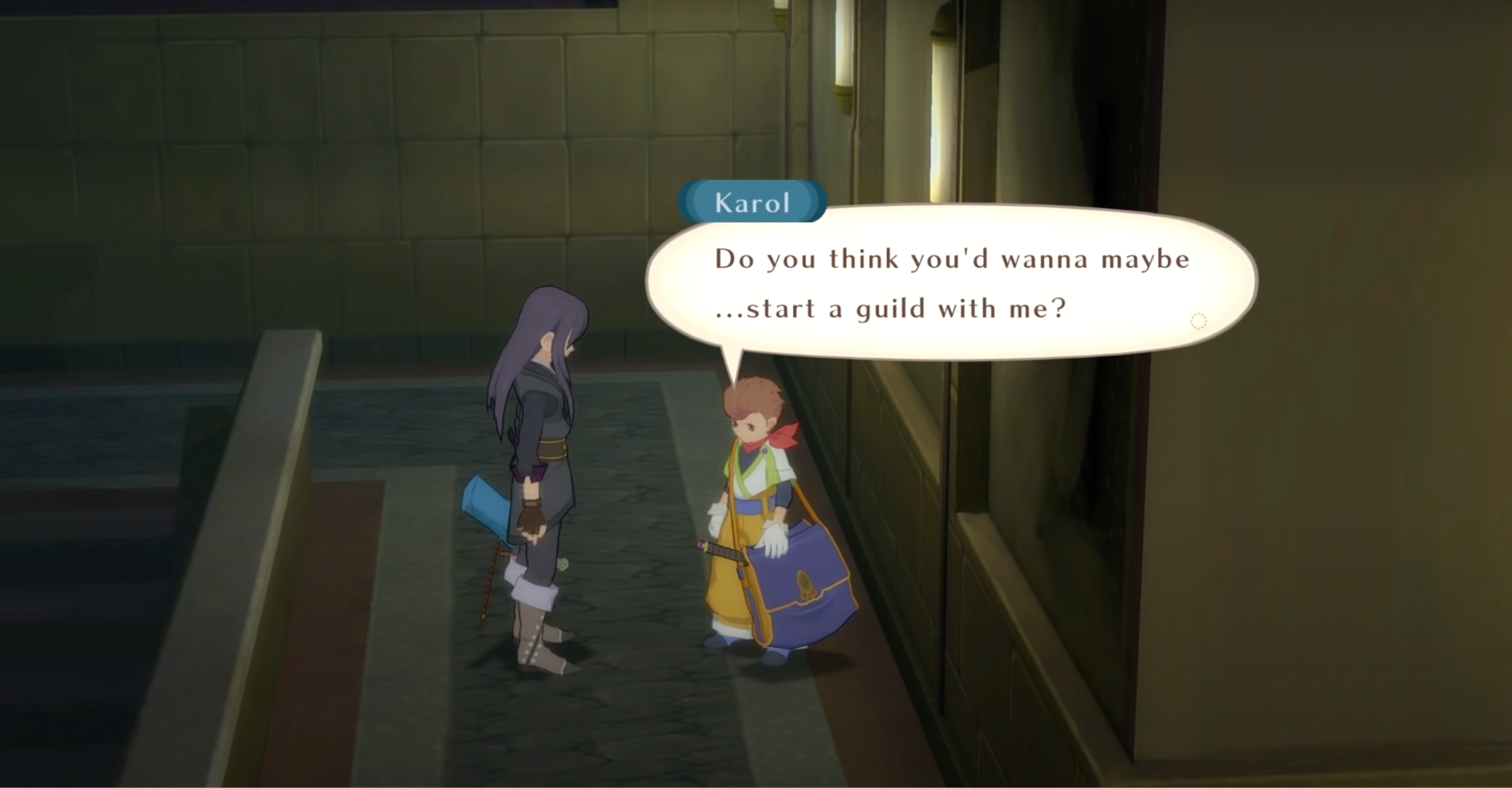
In Heliord, Karol quietly asks Yuri if he’d like to start a guild with him, sowing the seeds of Brave Vesperia.
Once the party finds Flynn—not just the object of Estelle’s first mission, but also a representative of the Imperial Knights, the enforcers of order across the empire—they begin to take account for the paths on which they’ve sent themselves, deciding and articulating how to square their inner desires with their actions in the world. In Capua Torim, Estelle asks Flynn for permission to stay with Yuri rather than return to Zaphias; in Heliord, retrieved from Caer Bocram by Cumore and Schwann’s Knights, Rita uses her affinity for blastia to save human lives, Estelle uses her healing artes to save Rita, and Karol digs himself out of his depression over the Hunting Blades and Nan rejecting him to meekly ask Yuri whether they might someday start a guild of their own. It’s with this newfound coordination between desires and future courses of action in mind that the party is able to vocalize what they positively want to do next when issued orders by Alexei, following the events at Heliord, to investigate the aer krene at Keiv Moc:
- Rather than pursue her work as an imperial blastia researcher, Rita vocalizes that “if Estelle is going back to the capital, I want to go with her,” a sentiment that aligns not only with her suspicion of Estelle’s connection with the Rizomata Formula, but also with her growing affections for another person rather than a blastia: a person who’s willing to risk her life to protect and heal Rita.
- Rather than return to the Zaphias, Estelle, upon hearing Alexei’s order for Rita to explore the Keiv Moc, insists that she join Rita in Keiv Moc since “[her] healing artes would prove useful,” as they did with the Great Tree of Halure and protecting Rita from the out-of-control blastia in Heliord.
- Yuri accepts Estelle’s request that he accompany them in order to make the empire feel comfortable with its princess traveling to a dangerous place—choosing to stay with the group despite the fact that Alexei asks that he do so “only because you once sought to join the Imperial Knights,” the role which Yuri had previously defined himself by rejecting in favor of anything else.
Now, from beginnings in quests decided by what they don’t want, our heroes are ready to start recognizing and articulating their desires, those ends which they do want. Remember, however, that we’re tracing the symbology of a sword, and for all its influence in the story, Dein Nomos barely makes an appearance in Tales of Vesperia’s first act: we see Duke using it to “[slice] through the aer” in Keiv Moc, calming the aer krene while explicitly refusing to provide background context on it (“What good would that knowledge do you?”, he asks Rita when she wants to know how he was able to use his sword in this way), and Ragou wistfully invokes its name—the name of a principle at which he never arrived—when Yuri slays him. These characters don’t sufficiently understand the dynamics of their world to coordinate their desires into a principle that can legislate their activity and reshape the world as a law; short of the contextual clarity to do so, their desires only fashion them into well-animated pawns for those who do understand the wider machinery according to which the world’s factions interact.
On this reading, it’s no coincidence that the party begins to find its desire-based footing in the first act in the midst of an assignment by Commandant Alexei, the very same puppet master who uses the twin antagonists of Vesperia’s first act, Blood Alliance leader Barbos and Imperial Councilman Ragou, in the unwitting construction of his own Dein Nomos, his own will to power.
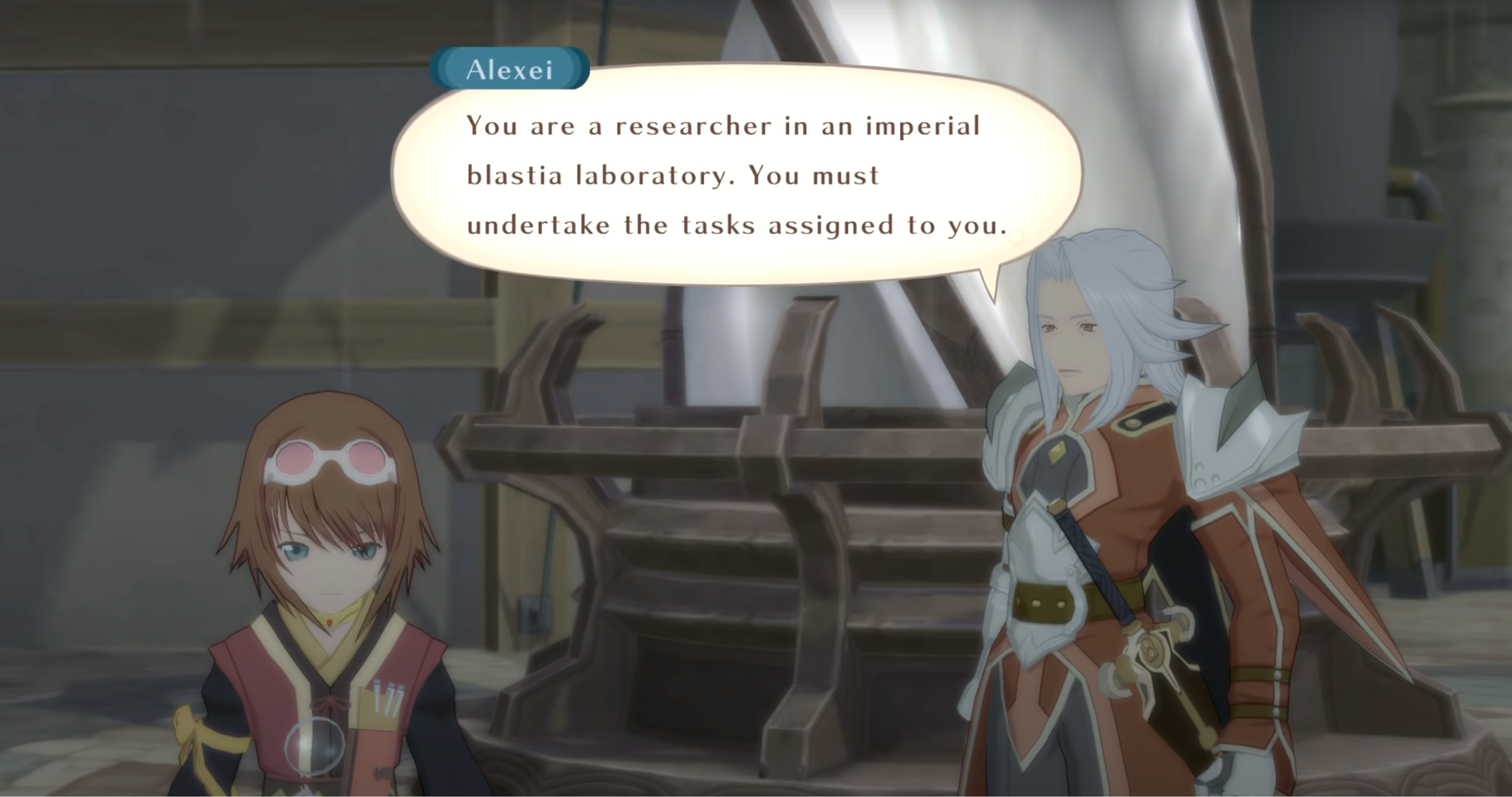
Alexei sets in motion the party journeying to Keiv Moc together from Heliord.
Like the party, Barbos and Ragou articulate and pursue their own desires, only to inadvertently serve Alexei’s ends for lack of coordinating their actions beyond themselves. The two conspirators are portraits of myopic men blinded by ambition, putatively leading organizations yet isolated in the pursuit of their missions. Barbos is the head of one of the five master guilds in the Union, yet he stands alone atop his Tower of Ghasfarost, a testament to his hubris, with a sword and blastia he expects will grant him the power to kill Don Whitehorse and take control of first the guilds, then the empire, and finally the world—with no clear path from one point to the next, besides faith in his own power and desire for domination. Ragou, meanwhile, seeks merely to manipulate the weather of his own little corner of the world, Capua Nor, in order to prey upon his townspeople as a means to “enjoy [him]self” and “dispel [his] boredom” as a councilman, conspiring for the sake of nothing beyond his own desire.
That Barbos and Ragou scheme with each other to achieve these ends with an agreement of “mutual non-interference” explicitly in place underscores how unable and unwilling they are to coordinate with each other for the sake of a mutual end. This isolation makes it child’s play for Alexei to use them for his own purposes: destabilizing the council in order to reinforce the authority of the Knights, and using Barbos to design and contribute to the network of blastia underpinning Alexei’s plot to forge his own Dein Nomos and seize control of Zaude.
Without coordination between the antagonists’ desires, it’s easy for Alexei to insert one of his enslaved agents—Yeager, with a blastia heart animated by the Commandant, and his Leviathan’s Claw guild—into their midst to coordinate their actions on Alexei’s behalf without their even noticing, since they aren’t sufficiently aware of the context in which they exist in order to recognize what such coordination looks like. Without coordination between the protagonists’ desires, it’s easy for Alexei to insert one of his enslaved agents—Captain Schwann, with a blastia heart animated by the Commandant, in the guise of Raven—into their midst to coordinate their actions on Alexei’s behalf without their even noticing, since they aren’t sufficiently aware of the context in which they exist in order to recognize what such coordination looks like.
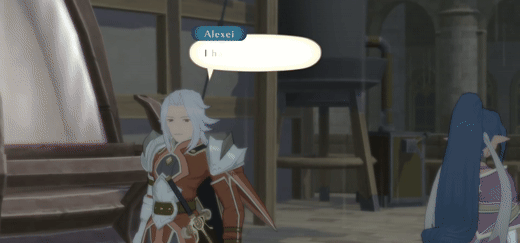
Alexei calls on Captain Schwann after sending the party to Keiv Moc.
Blind to the system within which their own desires are expressed, it’s as simple and unceremonious for Barbos’ sword to be neutered by Duke and the actual Dein Nomos as it is for Lydon to be swallowed up by the Eye of Atamoni. This public act of a law, the principle of Duke and the Entelexeia’s will, wiping clean the senseless ambitions of a directionless leader suffices to eradicate not only Barbos, but also, effectively, the Blood Alliance, the guild saddled with that senseless leader and his lawlessness. In contrast, a confrontation between two insufficiently articulated desires—Ragou’s desire for sadistic self-satisfaction, and Yuri’s desire to see him punished in a way impermissible by the empire—can only conclude with a clandestine act under the cover of darkness, Yuri’s extralegal execution of Ragou, effecting no broader change in the nature of the council, the empire, or the global ecosystem in which they are embedded.
With these two villains gone, our heroes are free of their inertia, but in its place, they’re left with a newly formed guild bearing neither a name nor governing principles, a princess whose healing powers earn her the title of an “insipid poison of this world” by a yet-unidentified Phaeroh who offers no further context or explanation.
To shape the future through their individual principles of will, Yuri and his friends must learn how to organize their actions into an expression of will that can impact the world beyond themselves.
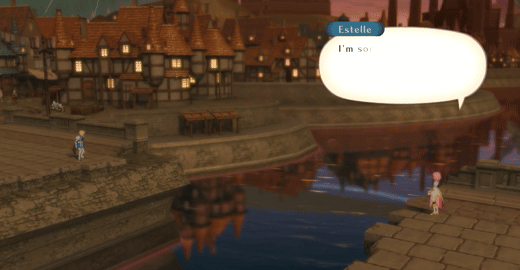
Estelle resolves to learn enough about the world to situate her newly awakened desires within it, following her encounter with Phaeroh.
We’ve begun the process of forging two swords with which to enact a future on the basis of our individual volition, but only just: the Swordians haven’t been honest about their nature, and Dein Nomos has barely shown itself, let alone presented itself as a tool to be used or understood by the party. Two groups have found their way out of inertia by learning to act instrumentally, whether ordered by others or themselves, and to discover their internal interests along the road; in order to transition now from honoring their authentic feelings to shaping the world beyond themselves, they need a reason and vantage point from which to interrogate how their personal desires relate to those of the others who came before them and who stand beside them.
Act 2: Through Betrayal, Resolution
You cannot grasp the impact of your desires until they publicly conflict with those of someone you trusted.
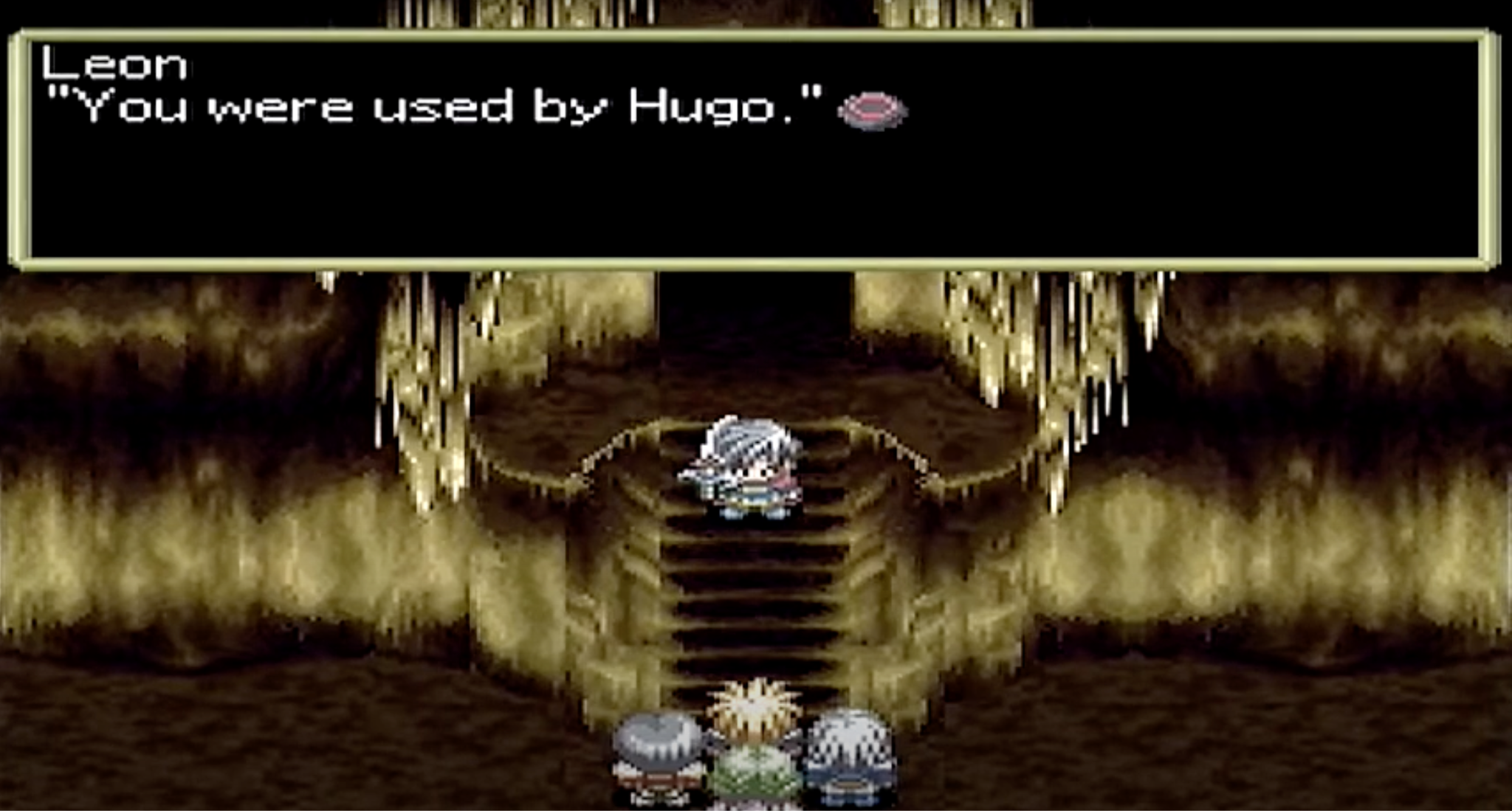
Leon reveals himself as a traitor and Hugo as the mastermind of the events in the first act of Tales of Destiny.
Tales games are known for their sympathetic portraits of complicated traitors, and Tales of Destiny and Tales of Vesperia illustrate how betrayal can be a surprisingly empowering force in helping individuals discover the contours of their own volition—how to take up a sword as a tool of projecting your values beyond yourself for the sake of creating a different world. Once Stahn, Yuri, and their friends experience how the actions of those inside and outside of their group can distort, co-opt, and reinterpret their own actions, they also discover how they can shape their wills to have a positive and additive impact on those beyond themselves.
Tales of Destiny: Reading a Marionette’s Strings as Information
The difference between destiny and self-governance is a choice in how to relate our actions to those of the past, and that choice is a privilege only possible when the past’s impact on us is laid bare for all to see.
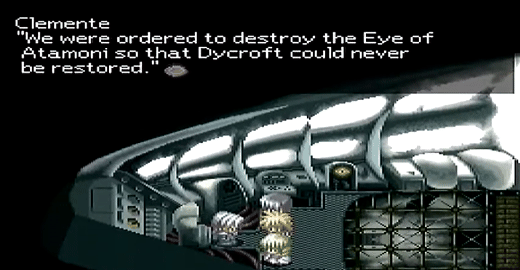
The Swordians confess their deception to their masters after the return of the Aeropolis.
After Leon submerges the Swordians’ consciousness with his trick of the Aura Discs, Act 2 of Tales of Destiny opens with the revelation of that betrayal laying the foundation for the party to better understand their personal relationships with the present and the past. The characters have the opportunity to bear witness to the lives and connections the others have chosen—not out of inertia, but out of the clarification and vocalization of values they underwent in the game’s first act:[6]
- Philia finds Stahn home in Lienea with his sister and grandfather, living a quiet country life.
- Stahn and Philia witness Rutee caring for the children at the orphanage she sought to protect in Cresta.
- Stahn, Philia, and Rutee see Garr assuming the role of King of Phandaria following the death of his father, presiding over a restabilized kingdom from his throne.
- Mary is readjusting to life with her memories and her husband, Dalis, after finding him in Phandaria, overcoming the amnesia he’d imposed upon her to protect her, and freeing him from the yoke of Lydon’s mind control.
Even before Hugo reveals his intentions and the Swordians confess to the party about their true mission, these tableaus show that different individuals are called to wield the tools of the past in different ways, and that it remains their choice to answer this call. When Stahn and Philia see Rutee happily presiding over the orphanage, they both feel that it would be best to let her stay in Cresta rather than asking her to rejoin them, whereas Dymlos and Clemente insist that, as a master, her service is necessary for the group to combat the catastrophic threat of the Eye of Atamoni; when push comes to shove, though, Rutee is adamant that only she can decide what’s the right thing for her to do—and that she feels more at home traveling with her friends than at the orphanage, especially if she can do so in service of saving the orphanage from destruction at the Eye of Atamoni.
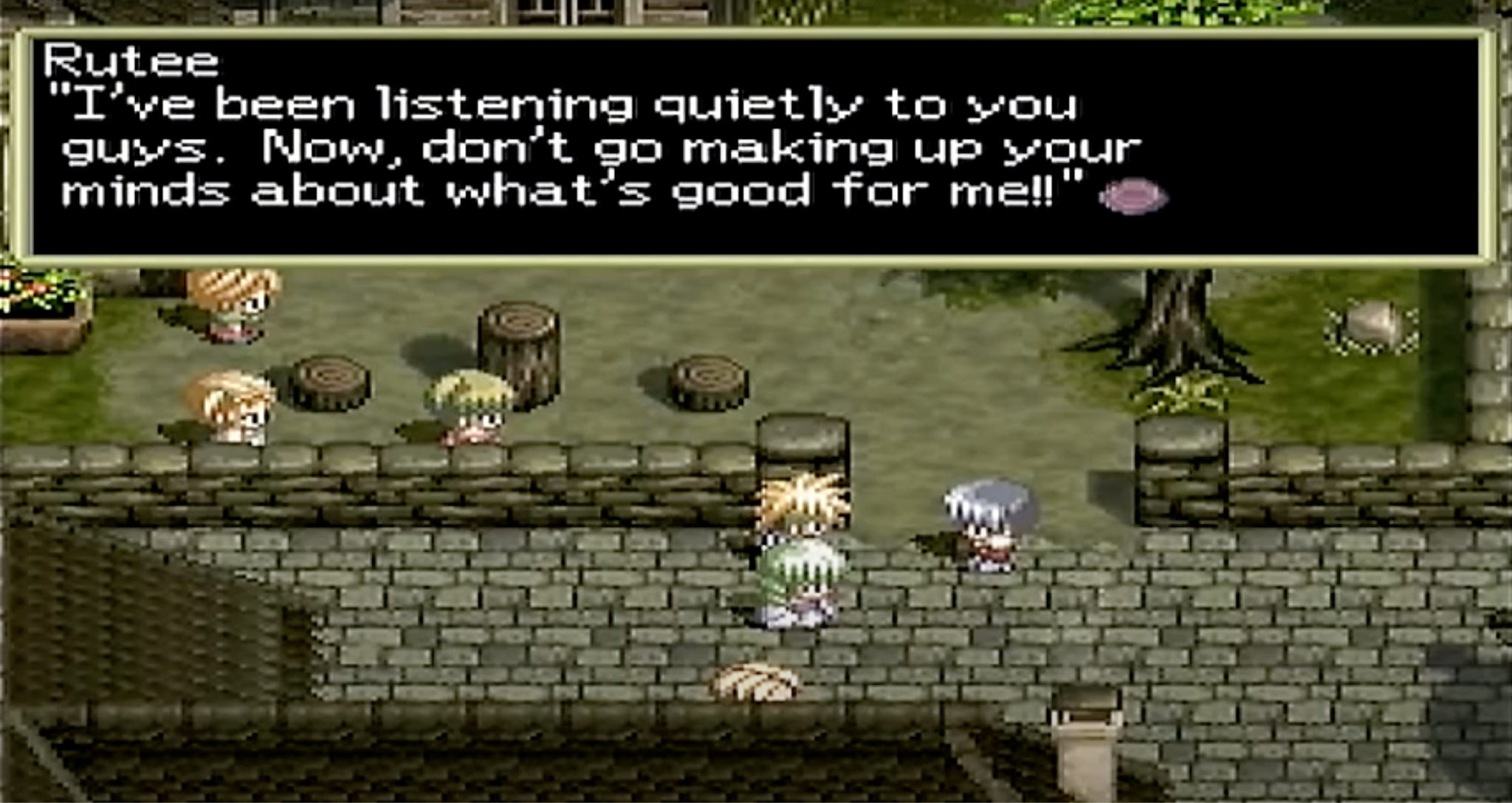
Rutee asserts her right to participate in the party’s journey for her own reasons, interrupting Stahn, Philia, Dymlos, and Clemente’s debate about whether to take her with them to Seinegald.
At this stage—with the Eye of Atamoni back in play and the Swordians insisting on their knowledge of its danger from 1000 years ago—the heroes are in a position to understand that they are being called back to deal with some kind of history. They’re no longer muddled in the toxic timelessness of Lydon’s struggle, understanding now that this has more to do with the Eye of Atamoni than him or any present-day actor per se, but the relationship between past and present remains opaque: Why is the Eye of Atamoni back? What is the Swordians’ relationship with it? Their choice, then, is one to confront history whatever it may bring, for the sake of improving the present and everything they care about. The Swordian masters reuniting with each other in their home environments allows them not only to make that election individually, but also to see and support each other’s reasons for making the same election.
Mary, meanwhile, makes a structurally analogous decision to wrestle with and interrogate her own past, now that she has rediscovered it—a decision that leads her to refuse to come with Stahn and the others as they are recalled to Seinegald to deal with the Eye of Atamoni because the past that is relevant to her calls her to a different present-day principle of will than that which the masters take up.
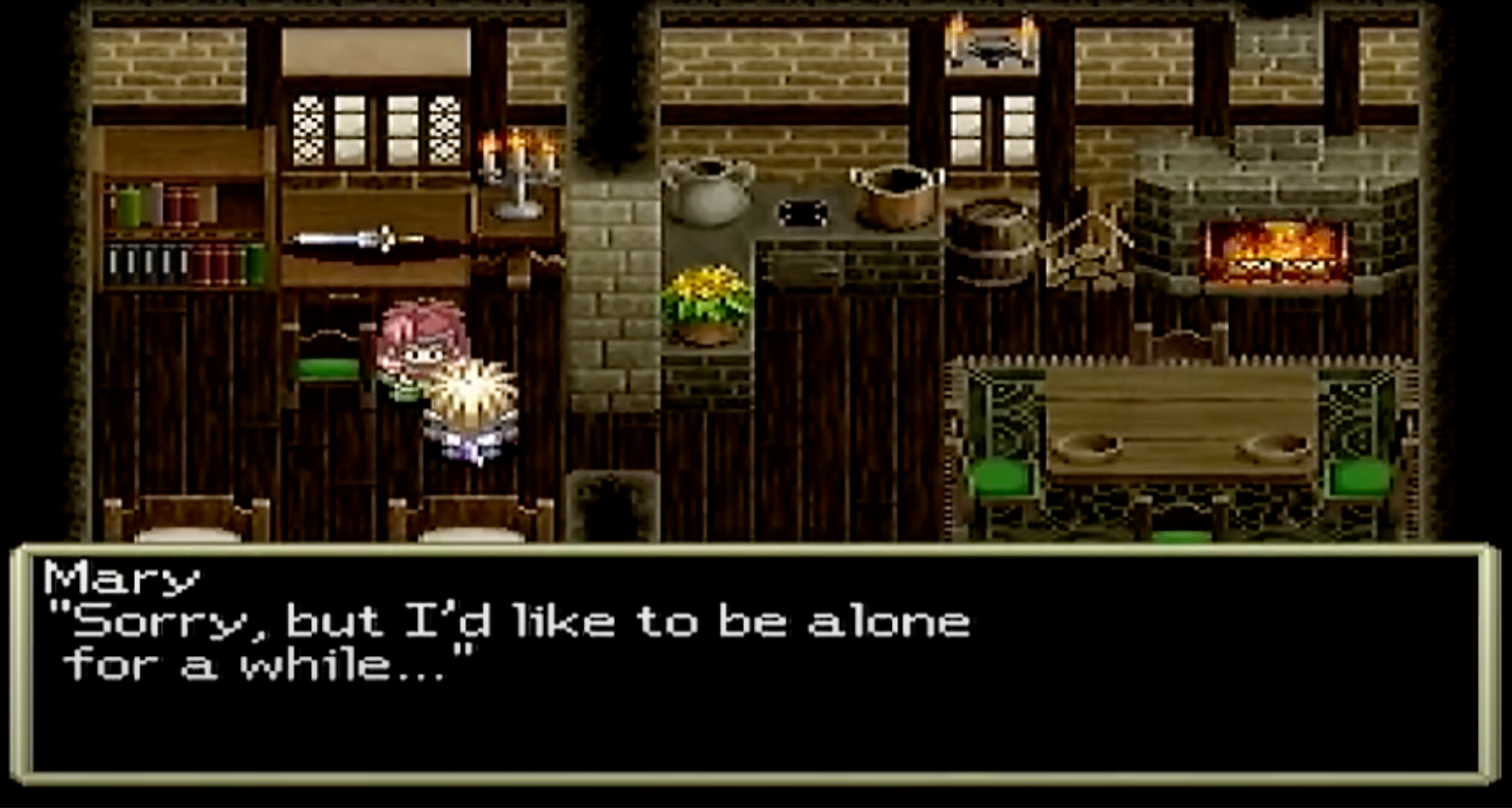
During the regrouping of the party following Hugo and Leon’s theft of the Eye of Atamoni, Mary rejects rejoining the group in favor of engaging with her own, newly discovered past and relationship with her husband.
The honest rediscovery of the masters’ native contexts as separate from the Swordians is a prelude to discovering a tragically inverted state of context in the treachery of Leon and Chaltier, Hugo’s marionettes. Where Stahn, Rutee, and Garr are Swordian masters who exert their own agency and chosen roles over their home lives—Stahn being a supportive big brother to Lilith, Rutee acting as a kind of surrogate older sister or mother to the Cresta orphans, and Garr ruling his family’s domain—Leon is a tragic shell of a “master” forced into a role by a manipulative and artificial conception of his home manufactured by Hugo, his own father, and Marian, a hapless housemaid whom Hugo brought into the household because she resembles Leon’s deceased mother. Stahn and his friends’ newfound sense of fulfillment in their place in the world is counterbalanced by Leon’s imprisonment in a home that’s completely predicated on treating people as tools: as the President of Oberon Corporation, Hugo is an expert at using people instrumentally to advance his own agendas, whether that’s coordinating international trade for the bottom line of his company, guiding Lydon’s machinations to put the Eye of Atamoni in motion, or threatening his housemaid to secure his son’s cooperation in manipulating our heroes into getting that Eye of Atamoni into his hands.
When the party confronts Leon beneath Libra IV—the secret, recommissioned base of his father’s company—he reveals himself not just as a traitor, but specifically as a kind of “anti-Swordian master,” clarifying the importance of the masters and Swordians’ own growth by showing them how deleterious the opposite dynamic is. Where the Swordians represent those with a purpose in the past acting as tools to enable their masters’ new principles of actions in the present, Leon is made into a tool for someone else’s ends by being bullied into a subservient relationship to his own past. Where Lydon’s toxic zealotry was timeless, Leon’s enslavement by Hugo perverts relationships between past, present, and future: Chaltier, his own Swordian, is entirely submissive to the will of his “young master” in the present, while his Swordian comrades hold fast to their true mission from the time of the Aeth’er Wars; back in the first act of Tales of Destiny, we now understand, Leon pulled the strings of the party using Hugo’s electric tiaras to keep them bound to Hugo’s vision of the future rather than anything to do with their present-tense goals.
Entirely robbed of the ability to determine the context motivating their actions, all that remains for Leon and Chaltier alike is to lapse into a purely defeatist form of fatalism: not a prudential lie about destiny to empower others of the sort that characterized the first act, but rather the resignation and self-abnegation at the heart of the only two sentiments Chaltier utters to to the Swordians—or to anyone for the remainder of the story—after the party has learned of his betrayal: “it’s out of our control […] You should acknowledge the fact that it is useless to go against the ancient ways.”
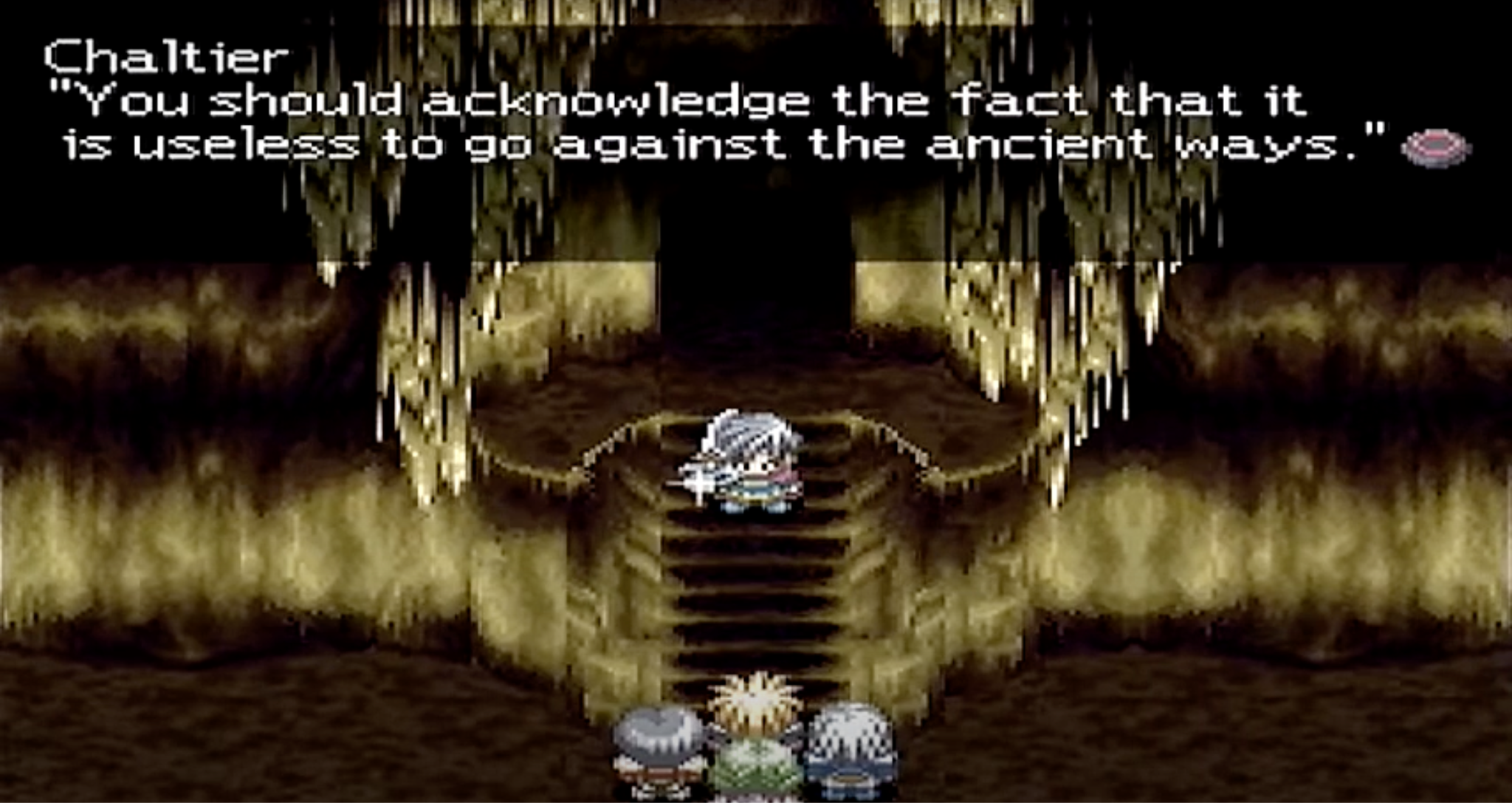
Leon’s Swordian, Chaltier, expresses the fatalistic perspective that subjugates him and Leon to Hugo’s machinations.
The revelation that Rutee is also Hugo’s child—a revelation which Leon hurls at Rutee like a knife meant to fatally wound her before the battle has even begun—is a devastating discovery for Rutee, but it also poses a clear and present danger to the Swordians. Leon is a living testament to how thoroughly these corrupted networks of influence can co-opt not just an agent, but a Swordian and its master, specifically. Without an explicit demarcation between the agents of the past and the agents of the present, those agents can be so completely dislocated as to completely lose the will to govern themselves at all. If Hugo could achieve this with his son—a son who recognizes himself as “merely a disposable tool” to his father—one might worry that there would be little to stop him from repeating the process with respect to his daughter, replacing his current tool once the heroes “dispose” of it. Atwight seems to recognize this risk immediately, calling out to Rutee that Leon’s claims about her lineage are “nonsense” and ordering her not to believe him; it’s this same recognition, I think, that explains why the Swordians quickly become more honest with their masters once they defeat Leon and witness Belcrant and the Aethersphere rising, evidence of how high the stakes of Hugo’s mind-games are.
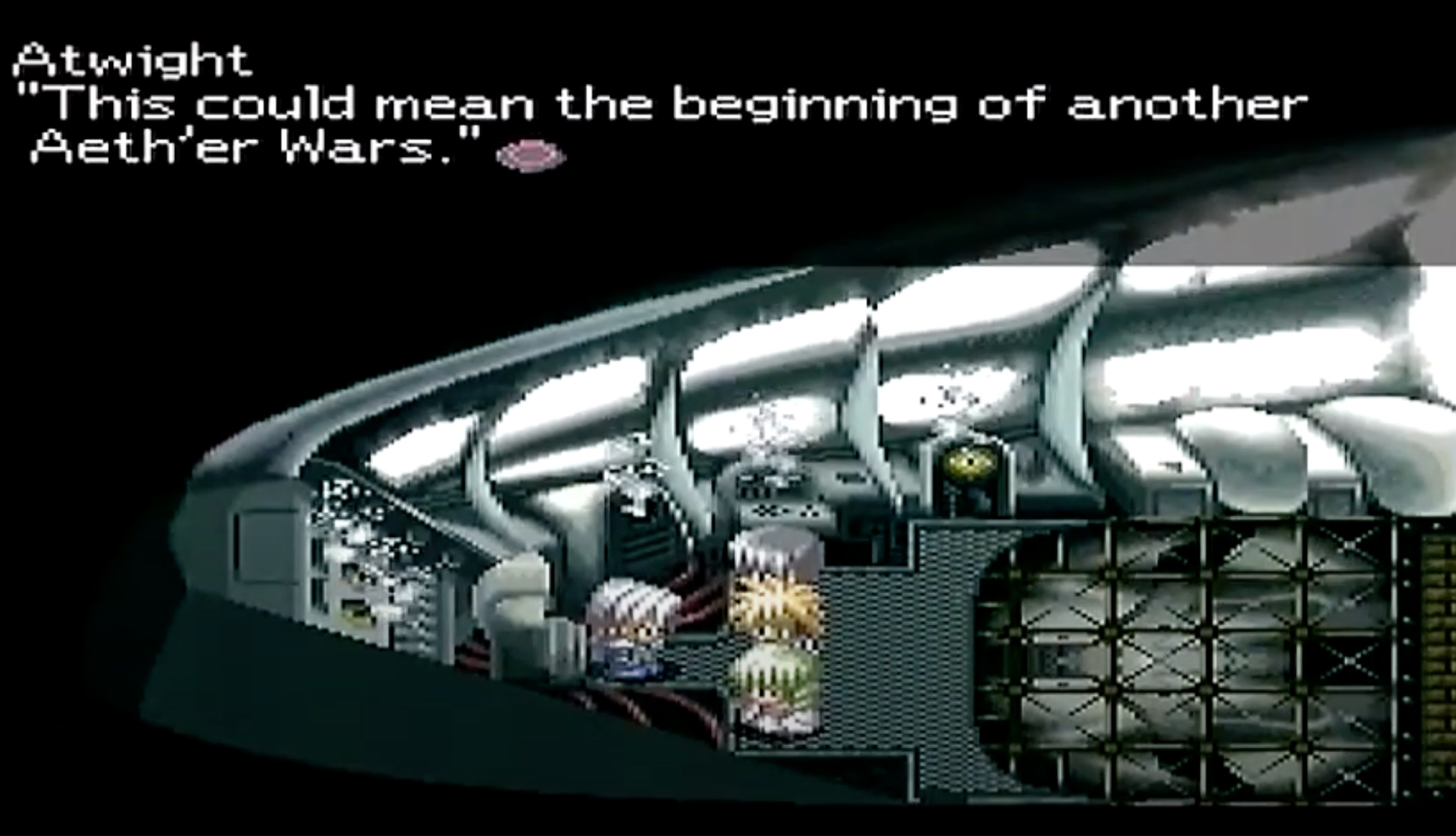
Atwight expresses the Swordians’ collective fear of the past reasserting itself in the present following the advent of the Aeropolis and Belcrant.
In the face of the revived Aetherian homeworld, the Swordians confess what their true purpose has been since they first found their new masters, acknowledging not only their own deception but the contributory role their deception played in Leon’s manipulation of the party:
Dymlos: “At the end of the ancient wars, when we were about to enter our sleep… We were given a mission.”
Clemente: “We were ordered to destroy the Eye of Atamoni so that Dycroft could never be restored.”
Atwight: “Ever since we were reawakened, our intent was to destroy the Eye of Atamoni. As a result, we ended up deceiving you all…”
Dymlos: “But Leon was aware of what we were doing. And he led us around by the nose. At this rate, the surface will be totally destroyed by Belcrant.”
This explanation sets the tone for the rest of Act 2: to overcome the risk of the temporal perversion that swallowed Leon, the Swordians and their masters both accept more personal responsibility in actively vocalizing the contexts within which their lives and principles of will are embedded. On the Swordians’ part, this consists in helping their masters to reach and overcome Hugo by introducing them to the history, characters, and actual machinery of the Aeth’er Wars that spawned them in the first place:
- They introduce their masters to the digitized personality imprint of “Marius Raiker, commander of the Er’ther forces during the Aeth’er Wars.”
- They band together to revitalize Radisrol—now reinterpreted from the mysterious, Atlantean city in which Clemente called out to his “destined” user, to the Er’ther Aeropolis in which an ancient army ascended to the sky to finish their oppressors once and for all—in order to reach Hugo and his brood, entrenched in their mausoleum of a sky fortress.
- Igtenos, that same Swordian whose damaged, non-sentient form symbolized the inability of Lydon to grasp the distinction between present and past, now must be revived by his comrades and their masters specifically for his expertise from his own, past context as an expert in high-energy physics, so that he can help the party in their present-day context of reaching Hugo in Dycroft, protected by a Mirror Shield.
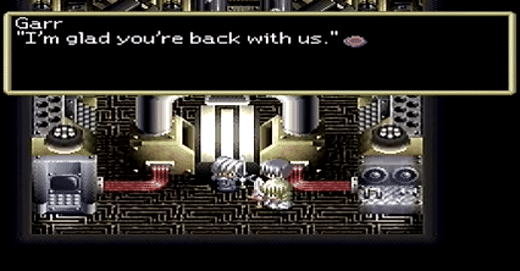
Igtenos immediately apologizes to Garr upon being revived in Helraios.
As in Tales of Destiny‘s first act, Igtenos is a telling marker for the group’s progressive development. When Garr and his friends revive the Swordian in Helraios on the way to Dycroft in the Aethersphere, Igtenos’ first reaction is to apologize to his master for failing to protect his father from Lydon, the usurper. Garr, the ruler, is able to take responsibility for the burdens and failings of his kingdom in the present, absolving Igtenos of his guilt and inspiring him to do the job that only someone with his expertise from the past could do: the job of undoing a magical barrier that’s of a piece with Igtenos, another object of the world’s past.
Suppose, like the Swordian masters—like Leon, like Garr, like Rutee—you discover that your world and your capacity to act within that world—the very sword by which you enact your will—are contingent upon agents and events from the past—a mother whose legacy is manipulated by your father, a war whose leaders left the central conflict unresolved to fester over centuries. At that moment of discovery, you find yourself to be a marionette, your limbs animated not by your own volition, but rather by a set of invisible strings, the ghost of something that ought not to exist in your present context. Once you see those strings, you have two options: you can interpret your own agency as impotent and fully surrender to the whims of the hand pulling the strings, as Leon does with Hugo, or you can take those string as an expression of information about the connection between you and someone beyond yourself, and use that information as an opportunity to communicate with the hand on the other end, allowing both the marionette and hand to act better in concert with each other according to their own intentions, as Garr does with Igtenos.

The marionette model of discovering one’s volition in Tales of Destiny. (Source.)
This clarity of communication allows the masters to ascend to the upper echelon of the Aethersphere of their own accord with the support of the Swordian’s full knowledge and practical facility with the past, reenacting the Er’thers’ ascension in Radisrol for their own, modern reasons. Nowhere is the human impact of this growth more poignant than in the case of Rutee gaining the depth of insight her tragic brother could never access, allowing her to see Marian’s relationship with him more holistically than Marian and Leon can—and to call her father back from oblivion in his final moments.
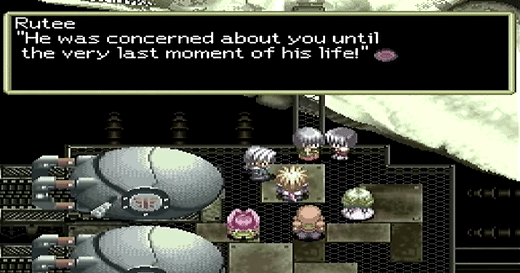
Rutee takes Marian to task for mischaracterizing Leon’s feelings for her.
After the party defeats a maddened Rembrandt in Mikheil, Marian, his hostage, mourns the death of Leon, lamenting that she “couldn’t do anything for him. He died without knowing what true kindness meant […] [H]e didn’t really open his heart to me. He only opened himself to a shadow of his mother.” Rutee confronts Marian with the bluntness and incisiveness only available to a sibling of Leon’s who escaped his fate: she tells Marian flatly that “Leon is dead” when Stahn hesitates to say anything and Philia wants to hold on to the unreasonable hope that Leon survived his confrontation with the party beneath Libra IV; when she hears Marian’s lament, she immediately rejects Marian’s despairing point of view, yelling at her that Leon sacrificed his life for hers: that Marian was someone whom Leon loved, not “some kind of tragic heroine, and that, if Marian “really love[d] Leon,” she must honor those feelings in order for Leon to be able to rest in peace.
For those whose lives and actions have been hijacked by puppeteers with agendas reaching backward into the past, the submission to the strings that guide their actions is total: even the emotions they might feel are interpreted as superficial artifacts of the puppeteers’ actions, from which the marionettes themselves can derive no value or sense of personal identity. Thus we saw Leon, all the way back on the party’s return voyage from the battle against Lydon, rejecting Stahn’s gesture of friendship when Leon is airsick on the Draconis, exclaiming that he doesn’t have friends and adding the fatalistic perspective of a broken marionette moments later: “Let me tell you something,” he tells Stahn: “People will deceive you no matter how much you trust them!” Thus, too, we see Marian describing Leon as someone who chased a shadow, robbed of the experience of true kindness. Yet for Rutee, who has undergone the growth of (1) appreciating others’ utility as a means to their own ends and (2) understanding Atwight’s mission and reasons for withholding Rutee’s own history from her, the influence of the past has no power to nullify the emotions and intentions of the present. Once the relationships between Leon Magnus, Chris Katrea (his birth mother), and Marian are clarified, it’s perfectly consistent to acknowledge the resemblance between Chris and Marian according to which Hugo was able to make Leon his pawn, while also validating the feelings which Leon and Marian have for each other as individuals sharing a home together in the present tense.
When all is said and done, the tragic difference between Rutee and Leon is that Rutee has the privilege of being able to develop in a group of humans and Swordians who empower her to reconceptualize her manipulative tendencies as a lens through which to relate and support the autonomy of herself and others, whereas Leon remains sealed within a prison in which he is governed by the most instrumentalist mastermind in the world, leaving Leon to treat his own manipulative tendencies—perhaps a family trait between Hugo, Rutee, and Emilio—as a method of reinforcing the same, all-encompassing machine in which he’s been taught to see himself as a cog.
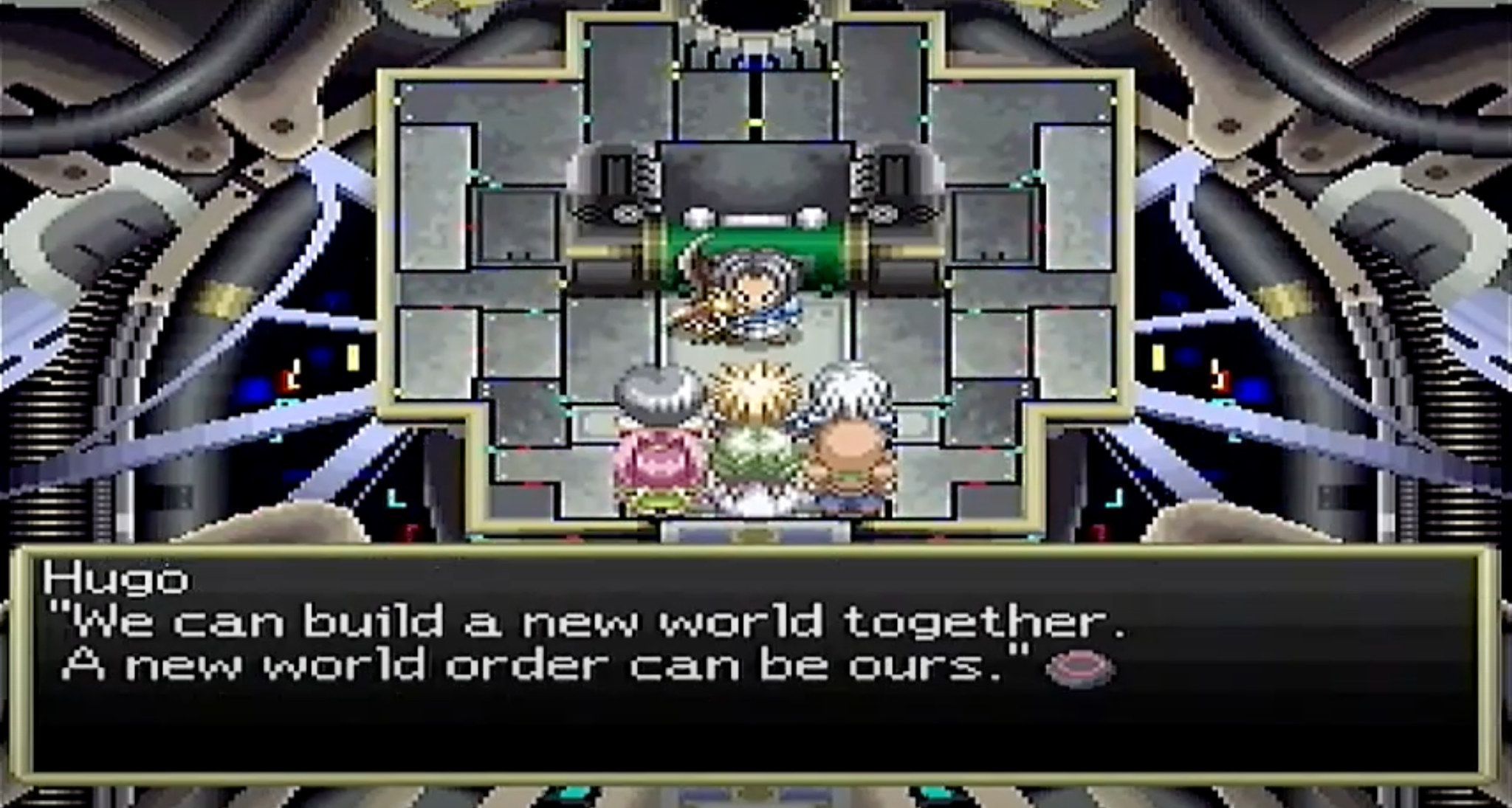
Gripping the Swordian “Berselius,” Hugo offers what he calls a “premonition” in the form of an invitation for the party to join him in creating a new utopia, divorced from the past.
By understanding the distinction between past and present agents and reasons for action, Rutee, Atwight, and their friends can overcome the instrumental manipulation that bound them in the first act and bound Leon from birth to death; absent Lydon’s toxic timeliness and Leon’s temporal perversions, our heroes are in a position to evaluate their actions in terms of ideals which they wish to impart upon the world’s global community. Accordingly, in their journey through the Aethersphere following Leon’s betrayal of the party and self-sacrifice for Marian, the party engages in philosophical debates with Hugo’s acolytes who sincerely believe in his vision for the world’s future, rather than those who served his purposes unwittingly or against their will. Oberon Regional Managers Ilene and Baruk—the kind-hearted confederates who kept the party on Hugo’s intended path for them during their pursuit of Lydon—now both reveal themselves as disciples of Hugo in every sense, advocating that the only way to cure the personal and societal ills of the world is to “start all over again” (in Ilene’s words), in “a true utopia” made possible by Hugo “harnessing the Eye of Atamoni’s power” to “transform himself into a superior being,” governing a new world order as a god whose “motives are not clouded by his ego or any hidden agendas” (in Baruk’s words).
Whereas Lydon, a priest presumably isolated from the outside world through his practice in the Straylize Temple, was so consumed by his ego as to enact a scheme of world domination that offered no rationale to justify itself, Ilene and Baruk, Oberon operators deeply embedded in their regional communities, have robust, justified perspectives on why the world is “suffering from a disease” and therefore needs to be reshaped. In Stahn and his friends’ his journey around the world in pursuit of Lydon, both Ilene and Baruk endeavor to give them quietly curated windows into those experiences that inspired their ideals:
- Ilene takes Stahn on a one-on-one date, showing him around Neuestadt, sharing with him its history of having “lost something important” as its natural environment was exploited for the sake of societal progress. During their day together, she meticulously tailors their progression from a serendipitous, intimate moment of sharing a couple of popsicles together to wandering into Neuestadt Arena and being berated by the champion, Khang, for the sake of sport and human entertainment.
- Baruk’s legacy precedes him: the party learns about, and sees the influence of, “the Baruk Fund” before they meet Baruk himself as he legislates from a building designating the “Baruk Fund Office” (whereas the party interacts with Ilene in a Lens Shop and her family mansion). The Baruk Fund is an institutional embodiment of Baruk’s will, “a non-profit foundation established by Baruk to focus on charitable activities,” supporting “orphaned children” and “sen[ding] donations for disaster relief,” all for the purpose of “helping the weak [for the benefit of] society,” in a world which Baruk sees as suffering from self-destructive factionalism across the course of history—particularly, in a corner of the world, Calvalese, which the party witnesses as plagued with xenophobia that’s been entrenched in its communities since the aftermath of the Aeth’er Wars, at which time the surviving Aetherians were sequestered in that unlivable desert continent and “systematically discriminated against for countless years.”
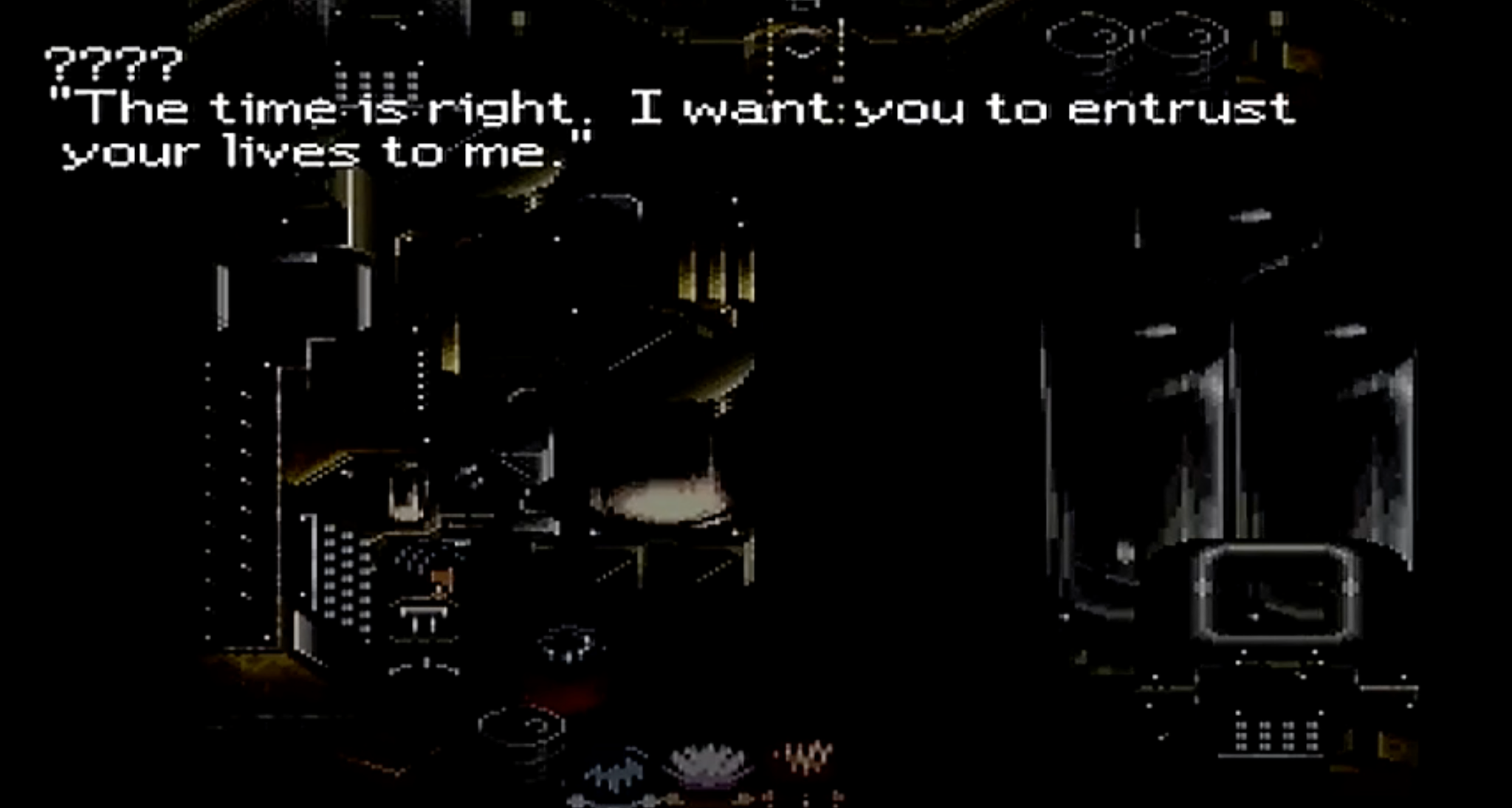
Hugo calls to his “four generals”—Leon, Rembrandt, Ilene, and Baruk—to commit themselves to him in changing the world “for true peace to reign supreme.”
Ilene and Baruk jointly illustrate how well-intentioned people can be misled into sacrificing their free will in the service of an apocalyptic idealism from diametrically opposed perspectives: Ilene from disillusionment with individuals, and Baruk from disillusionment with society. As Ilene shows Stahn a personal connection and portraits of individual life within Neuestadt, so she laments as an antagonist in the Aethersphere that “Countries, kingdoms… they’re not important at all. The most important thing is what’s inside people’s hearts:
You should have experienced things like suspicion, hatred, discrimination, and calculated kindness during your travels… I’ve had enough of this world! There’s no choice except for us to start all over again.
Further on in the Aethersphere, when Philia tries to convince Baruk of humanity’s potential to band together and improve, he rejects her individualistic perspective in favor of the macrocultural perspective that inspired his non-profit Fund in the first place: she tells him that “[p]eople are capable of understanding each other and working together towards a common goal,” and he counters that “That might be true among individuals, but it’s not necessarily true if we looked at society as a whole. Look at all the social ills that plague this world […]:
It is impossible for mere mortals to achieve order and perfection. […] Didn’t you experience Lydon’s rebellion first hand? […] It’s not just him. His followers like Batista and Tiberius as well. There are plenty of fools like that in the world. […] [D]on’t you feel that senseless destruction and chaos should be avoided at all costs? Every time someone like Lydon appears, many lives are sacrificed.
Coming from these two perspectives of personal failings and societal inadequacies, Ilene and Baruk arrive at an ideology to which they are willing to sacrifice their individual volition completely: Ilene “belong[s] to Oberon Corporation [and] can’t disobey Hugo,” and Baruk “has no choice” but to obey Hugo’s orders, to the point that “that man [who Baruk formerly was] no longer exists”—both individuals subsumed by Hugo, but not for a lack of conceptual distinction between past and present, as was the case with Lydon. Rather, Ilene and Baruk see the present state of human nature and the culture within which it exists as irredeemably self-destructive, preventing the peoples of the world from progressing over any time horizon. This kind of pessimism is like a lock joining with its key: far from being ahistorical, Baruk sees the long arc of history poisoning entire continents like Calvalese, and Ilene sees the corrosive emotions of human life stoked by these circumstances, corrupting those who could otherwise do good in the world. When the present and past offer only confirmation of negative outcomes rather than a blueprint for progress, the only model for change appears to be a clean break, fully rebirthing society under the governance of a god rather than its own agency; to this model, Ilene and Baruk surrender themselves.
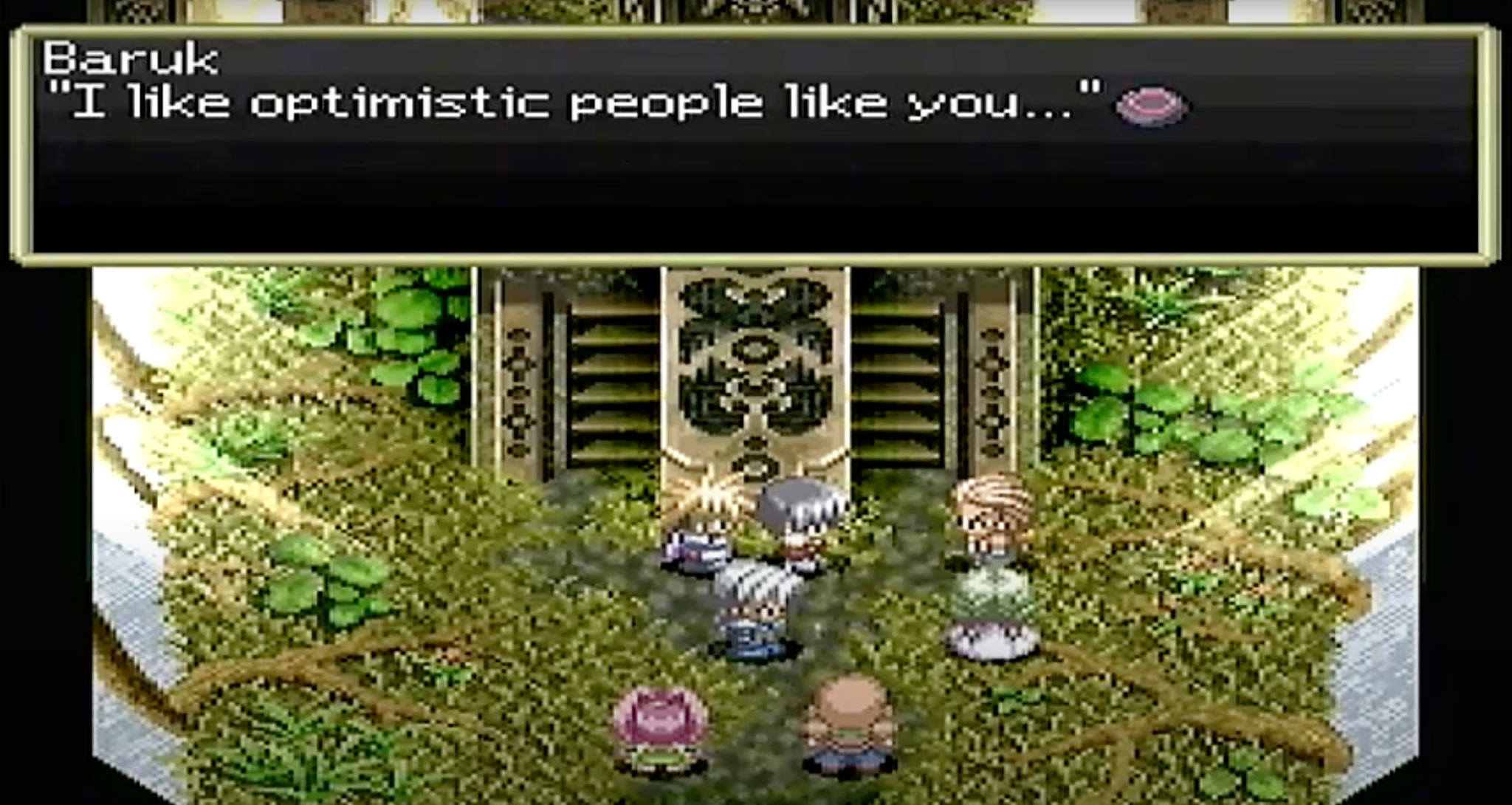
In Cloudius, Baruk commends the party’s optimism at the end of their debate about the nature of social progress, just before they come to blows, unable to resolve the difference between their views.
Of course, pessimism isn’t the only ideology at which one can arrive after experiencing the people of the world and their relationship to history: its counterpart, which both Ilene and Baruk explicitly recognize in the party, is optimism, the belief that it’s possible for enough people to collaborate in pursuit of a better future and overcome the patterns of the past, be those patterns interpersonal or international. In the wake of her confrontations with Leon, Atwight, and Marian, it’s a foregone conclusion for Rutee to not only reject but even revile Baruk, a man whom she once admired, from a place of optimism in the face of his resigned, utilitarian pessimism: she has the self-awareness to admit that at the beginning of her journey, when she saw people as tools to be used, she held up Baruk as a paragon of someone who used his own means, and the means of those within his domain, for reasons that resonated with hers, like helping orphans; but she has also evolved to the point that she now recognizes the final conclusions of Baruk’s method as monstrous, and that the true ideal by which one govern’s oneself ought to be an end to tragedy for all those among the living:
Rutee: I always thought the world was full of worthless people… Then there was someone like you… someone who I thought I could respect… I can’t forgive myself for ever thinking that way about you.
Baruk: You sound as if you’re against everything I stand for. Remember, judging people while you’re emotional will cause you to make serious mistakes.
Rutee: I just want to prevent any further tragedies.
Similarly, Stahn’s unshakable faith in the simple ability for people who care about the world to work together for the better is something that the pessimistic Ilene decries as “impossible,” so opposed as it is to her view of the human condition—though she quietly, hopefully, recognizes that a world with more people like Stahn might be able to turn his dream into reality.
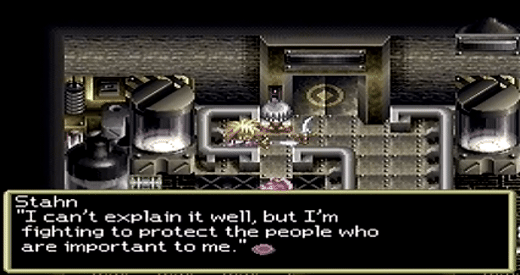
Stahn reflects with Rutee on the nature of the “optimism” Ilene identified in his approach to his journey.
We’ve identified the symbology of the Swordians as representing conflicts from the past empowering new principles of action in the present. In Tales of Destiny‘s first act, these living swords showed their users how to wield a sword, take up a desire with which to orient their actions at all, absent the temporal demarcations required to understand where the tool’s purpose ends and the user’s begins. In this second act, the revelations of treachery and manipulation are a tempering fire for the swords, putting their origins and designs into finer definition, and thereby empowering their wielders to more precisely define how they want to use that specific object from the past to impact themselves and their fellows in the present world. This distinction of past and present between tool and user effects the transition from an isolated, instrumentalist worldview with no room for autonomy to an idealistic worldview in which agents can articulate what kind of change they want to bring about in the communities to which they belong.
Instead of looking inward to discover their desires and then inhabit their desires in their home environments, they now look outward to unearth the shape of their intended impact, a process best realized through a combination of (1) clashing with differently-minded idealists and (2) deliberating with like-minded idealists. Stahn asserts his “naive” optimism to Ilene, who wants to believe him yet doubts the capacity of humankind, and then, after the battle, Stahn speaks with Rutee, Atwight, and Dymlos, helping the masters to determine the impact they want to have on society’s future as the output of their unique journey to use the Swordians in the Swordians’ own mission to destroy the Eye of Atamoni: they “don’t think our world is something you throw away,” yet they help the world not by thinking about “stuff like ‘the world'” in an abstract way—rather, they do so by “fighting to protect the people who are important to [them].” This mode of cherishing the world by virtue of cherishing those within it gives them a different understanding of their historicity—how their actions in the present stand in relation to those of the past and future—than Hugo, who would schematize everyone within this ideal of erasing the world’s present and past in favor of a discontinuous future.
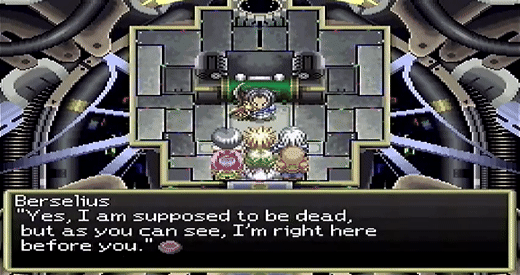
Hugo stands before the party basking in the power of “Berselius”—in fact, Kronos, leader of the Aetherians, masquerading as the ancient Swordian hero.
The tragedy of Hugo is also the lesson of why the party’s idealism is insufficient to determine the world’s future course through their individual volition. Hugo, like the party of Tales of Destiny‘s second act, understands enough about the past and present states of the world to wield a sentient Swordian (unlike Lydon), articulating and enacting an ideology through his blade. Yet the substance of Hugo’s ideology reads as a total refusal to process the past: rather than work with the people of the world to understand how the legacy of the Aeth’er Wars and its wounds have shaped their world, helping to chart a course to heal those wounds, Hugo’s raison d’être is to erase all of civilization, all of history, in favor of a fresh start governed solely by his will.
The instructive irony is evident: those who reject the past are dominated by it. Hugo’s will is puppetted not by Berselius, but by Kronos: the ancient leader of the Aetherians from the time of the Aeth’er Wars; the despot whose only agenda is to finish the conflict in which he was embroiled 1000 years earlier.
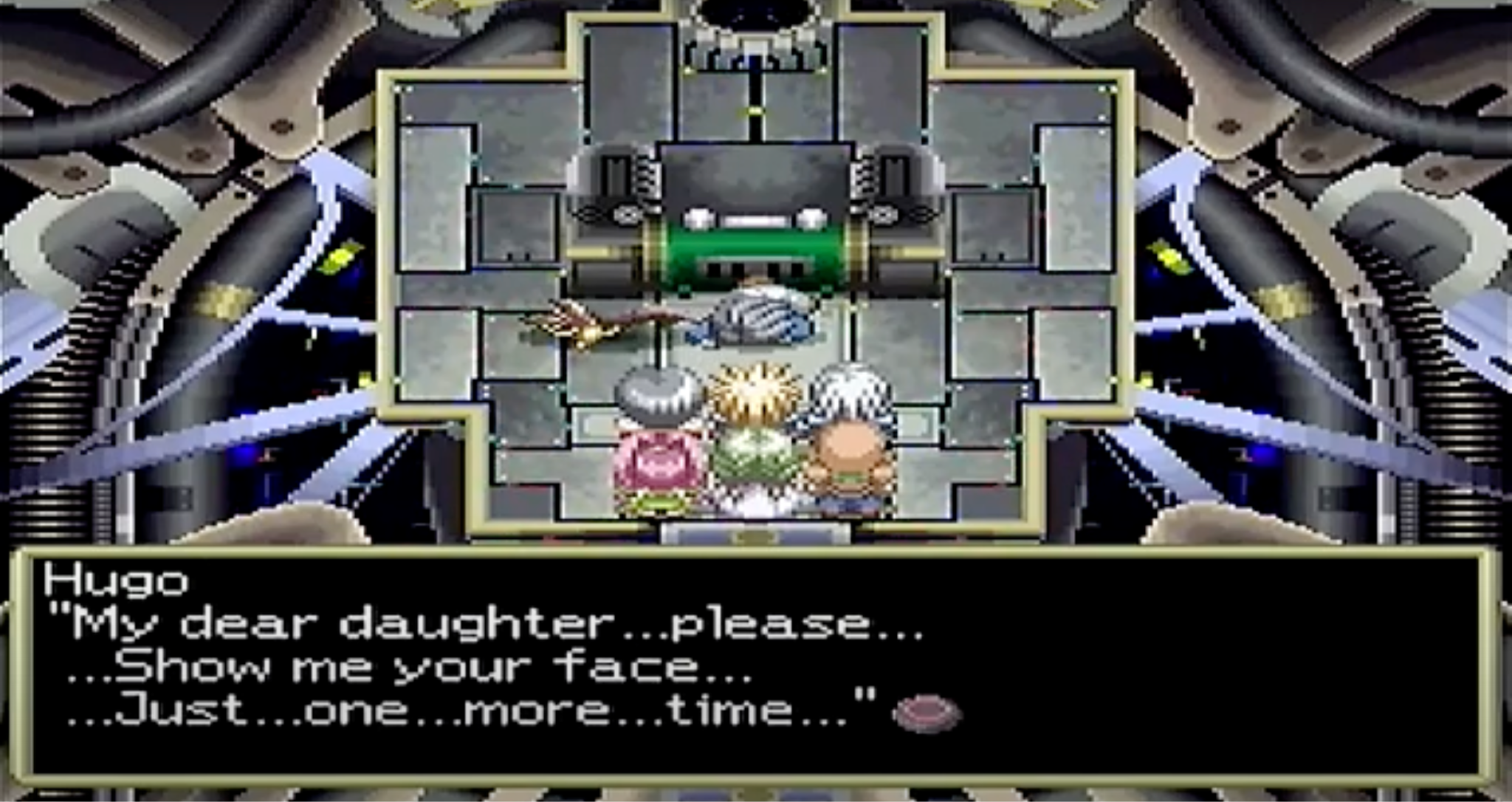
Hugo, finally released from the grip of Kronos, calls out to his daughter, in hopes that an intimate moment with her might be his final moment.
Even if we understand the difference between our actions and those of the past, unless we fully address the conflicts of the past and put them to rest within their native context, their influence will bleed through and constrain the desires, intentions, and choices of everyone in the present. Without addressing the past, all we can do is grasp for meaningful moments with good intentions in a kind of mindless presentism—as poor Hugo did when he had one fleeting moment of clarity in which to push Rutee and Atwight away from him, to Cresta’s orphanage, before losing any capacity for volition whatsoever; as poor Hugo does when he reaches out to see his daughter’s face one final time for a moment of true happiness as he lays dying, finally freed from Kronos’ puppetry. Kronos’ revival demonstrates that this danger is just as pressing for our heroes as it was for Hugo: the masters may understand their desired future, but without addressing and helping their Swordians to fully put their past—and, by extension, themselves—to rest, their actions amount to little more than a recapitulation of a war from 1000 years ago.
To shape the future through their individual principles of will, Stahn and his friends must learn how to inter their tools within the forges whence they came.
Tales of Vesperia: Discovering Your Group’s Principles by Learning What It Means to Betray Them
When you form order out of chaos, you need to witness that order breaking before you understand what holds it together.
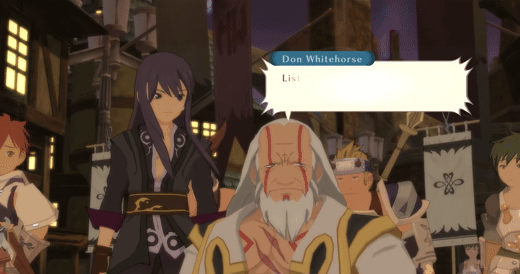
Don Whitehorse charges all those in Dahngrest, including our heroes’ party, to make the world’s new age for themselves—his final words before dying as recompense for the death of Belius.
As Yuri, Repede, Estelle, Karol, Rita, Judith, and Raven set out from Dahngrest followed the deaths of Barbos and Ragou along with the visitation by Phaeroh, they’re no longer following instrumental missions to recover a blastia or find a Knight: now, they’re on a mission to understand the world and their places in its networks of communities in order to have the epistemic standing to coordinate groups that can impact the world according to the groups’ desired outcomes. A consequence of this new resolve is that the outset of Tales of Vesperia‘s second act is itself more chaotic than the first act, and diametrically opposed to the outset of Tales of Destiny‘s second act: where Stahn and his friends progress from attuning to their desires at the end of a fetchquest to expressing those desires isolated from each other in the presentism and simplicity of their homelands, Vesperia‘s party sets out with a newly-formed guild that lacks both laws and a name, encountering a wide range of communities under the influences of leaders with agendas bearing no obvious connection. While Barbos and Ragou were unwitting pawns of Alexei in Act 1, they both bore a clear connection to the party’s quest to reclaim the aque blastia and reunite with Flynn, preserving the player and party’s sense of narrative continuity from one town to the next; now, in pursuit of Phaeroh and Estelle’s “destiny,” the party bounces across self-contained portraits of Cumore’s oppressive regime in Heliord and Mantaic, the Flynn Brigade and Hunting Blades’ occupation of Nordopolica, Duke’s respite in a projection of the ancient Yormgen, and Yeager’s antics in Heliord, Nordopolica, and the Weasand of Cados.
The signal within all of this noise only becomes clear once the party learns how to convert its desires into constraints on their group’s collective will: something that is only possible by witnessing the death of a man whose will superseded that of the very Union for which he stood, and finding within his legacy a method for holding their own members accountable to the group’s laws.
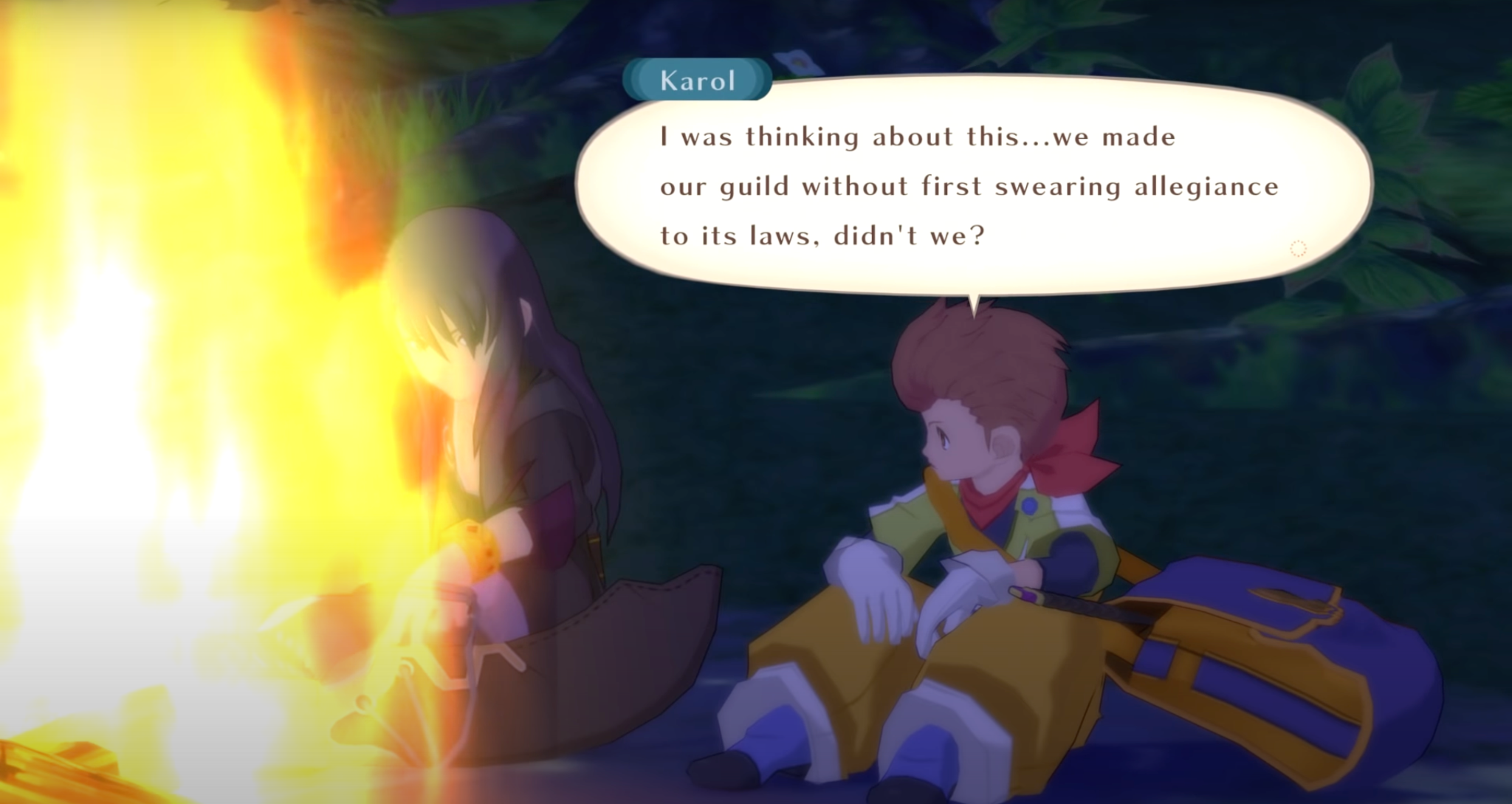
Karol reflects with Yuri on their decision to start a guild prior to deciding what it stands for.
The end of Act 1 showed Karol and Yuri’s decision to start a guild based on Karol’s desire to do so, with neither a name for the guild nor laws for its members to uphold. They begin Act 2 by putting laws and a name to their fledgling guild, without understanding what it really takes for the guild to collectively advance an agenda based on its laws. In large part, this second motion of Tales of Vesperia‘s story—the movement in which its characters must refine their desires into publicly accessible principles of action to which communities can subscribe—is the story of Brave Vesperia learning the difference between the solipsistic enactment of a principle in private, incommensurable ways by the members of a group, and the coalescence as a group behind a unitary, publicly determined course of action.
In contrast with guilds that serve a particular industrial function, like Barbos’ mercenary Blood Alliance or Regaey’s blastia-excavating Ruins’ Gate, the laws which Yuri puts forward for Karol’s guild are abstract, guiding the ethos of its members’ actions no matter the industry in which they may participate: “Everybody supporting each other, and always acting with the interests of the guild in mind. Striving to always do the right thing, while punishing those who don’t.” Such a broad mandate to pursue justice for the sake of the guilt is extremely malleable, a maxim which Yuri and Judith effortlessly reduce to the desires they found for themselves by the end of the first act—a reduction echoed in the fact that Yuri is ready and willing to dub Karol the guild boss purely on the basis that it was Karol who first vocalized his own desire to start a guild, rather than by virtue of any actions he had undertaken on the guild’s behalf.
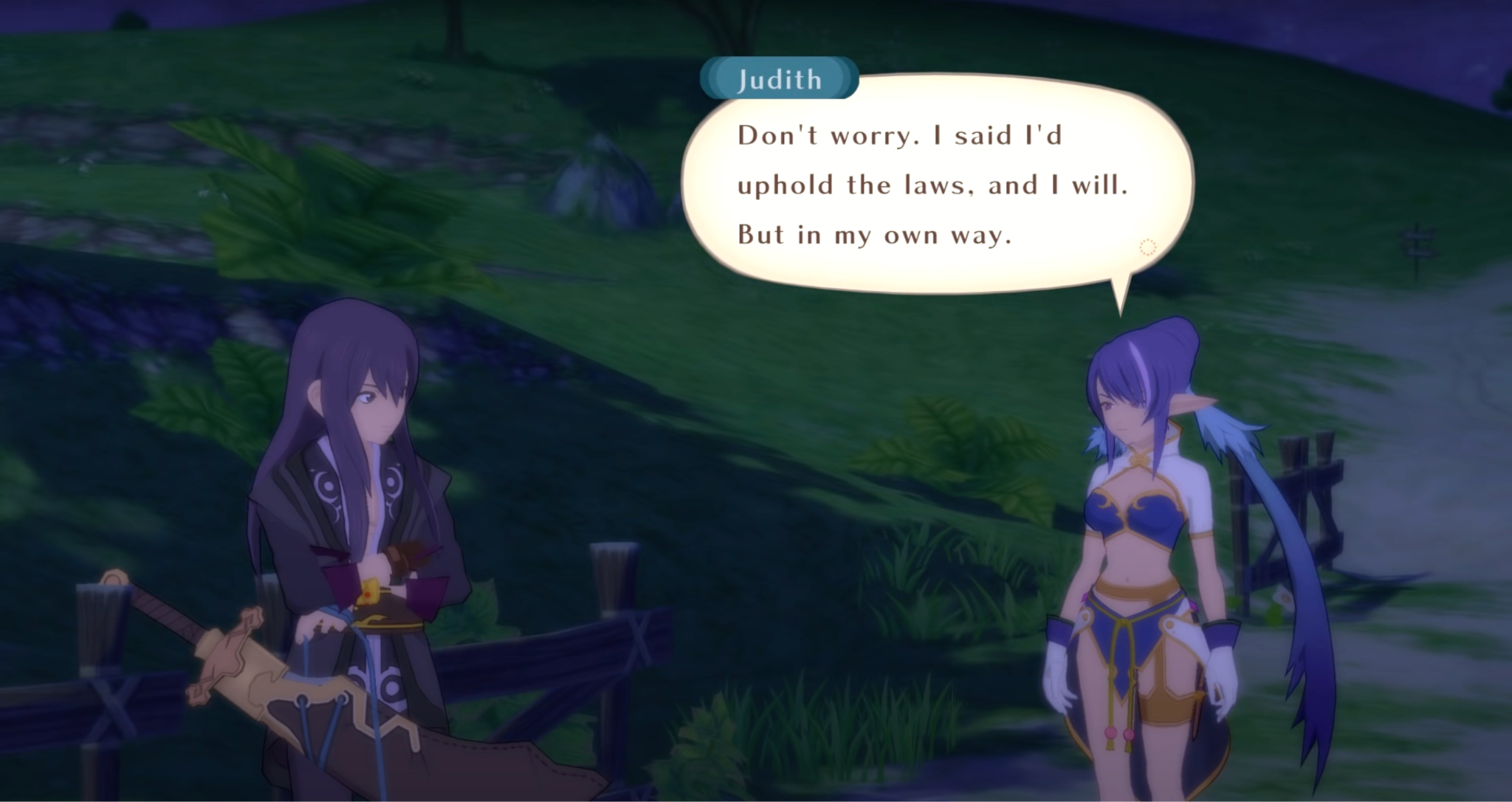
After joining Brave Vesperia for opaque reasons, saying only that she “joined because [she] wanted to,” Judith assures Yuri that she will abide by the guild’s laws “in [her] own way.”
Treated as this kind of justificatory shield, the disunity of the guild radiates out to surrounding party members’ roles in the story. In this context, it’s intuitive for Estelle to insist that her desire to set off and seek Phaeroh in the desert is a “selfish quest” that belongs to her rather than the guild, triggering a flurry of individual resolutions from the party as to why they want to come with her—a mirror of the party’s routine deliberation about whether and why to continue traveling with each other in the first act, rather than a cohesive alignment around a singular purpose of the kind we might expect in another JRPG. In this context, it’s natural that Raven could survive under the party’s radar, categorically distrusted yet successfully undercover as a pawn of Alexei: despite the party further investing in and supporting one another, they haven’t yet overcome the basic assumption that people’s intentions are their own and only selectively expressed to, let alone shared with, the group. On that assumption, the idea that someone in their midst is hiding something—even something unsavory—isn’t the red flag it would be in another story.
Brave Vesperia’s unspoken individualistic attitude is surfaced and resolved through two key events beyond their control: the death of a guardian who could no longer temper the chaos of Terca Lumireis, and the death of a leader who shone a light on the path out of that chaos. The first is Belius, Entelexeia and leader of Palestralle; the second is Don Whitehorse, Karol’s role model and leader of the Union.
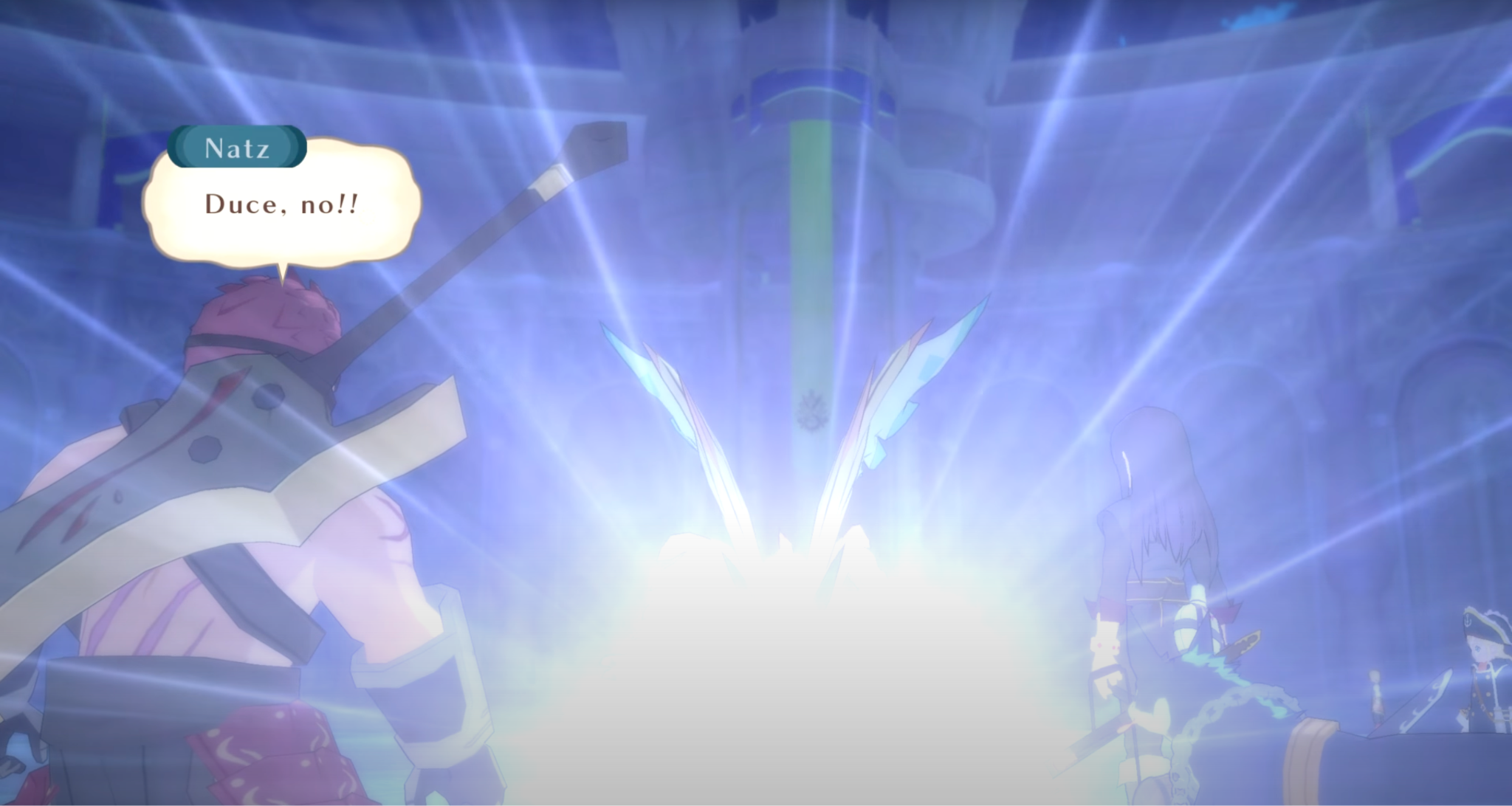
The death of Belius brings together the party, Palestralle, the Union, the Hunting Blades, and the Imperial Knights in a chaotic climax in Nordopolica.
In Tales of Destiny, the chaos of Leon’s bondage to times beyond himself in conjunction with the reemergence of Belcrant sufficed to prompt the Swordians to be more honest with their masters; in Tales of Vesperia, because the problem has less to do with deception than it does with a lack of understanding how to contribute one’s privately motivated actions to a greater, public whole, the party needs to be submerged in a sufficiently overwhelming chaos to force a conflict in their individual desires before they can synthesize a collective will: in this sense, the party as a whole needs to discover itself to be in Leon’s position, bound by conflicting desires and interests to the point that their group identity is incontrovertibly crippled. Belius’ death is this flashpoint, bringing to the surface the totality of poorly understood conflicts between the bloodlust of the Hunting Blades, the Entelexeia-centric worldview of Judith, Estelle’s nature as a Child of the Full Moon, the Knight’s systemic obedience to their Commandant, and Yeager’s manipulation of the Union (through the proxy of Harry, the Don’s grandson). All of these interests revolve around the as-yet poorly understood apatheia—which the Hunting Blades seek as prizes of vengeance against Entelexeia; which the Knights and Harry seek without knowing the reason why; which Judith safeguards as the souls of the Entelexeia; which Estelle’s “healing powers” somehow wrench out of Entelexeia at the cost of their lives.
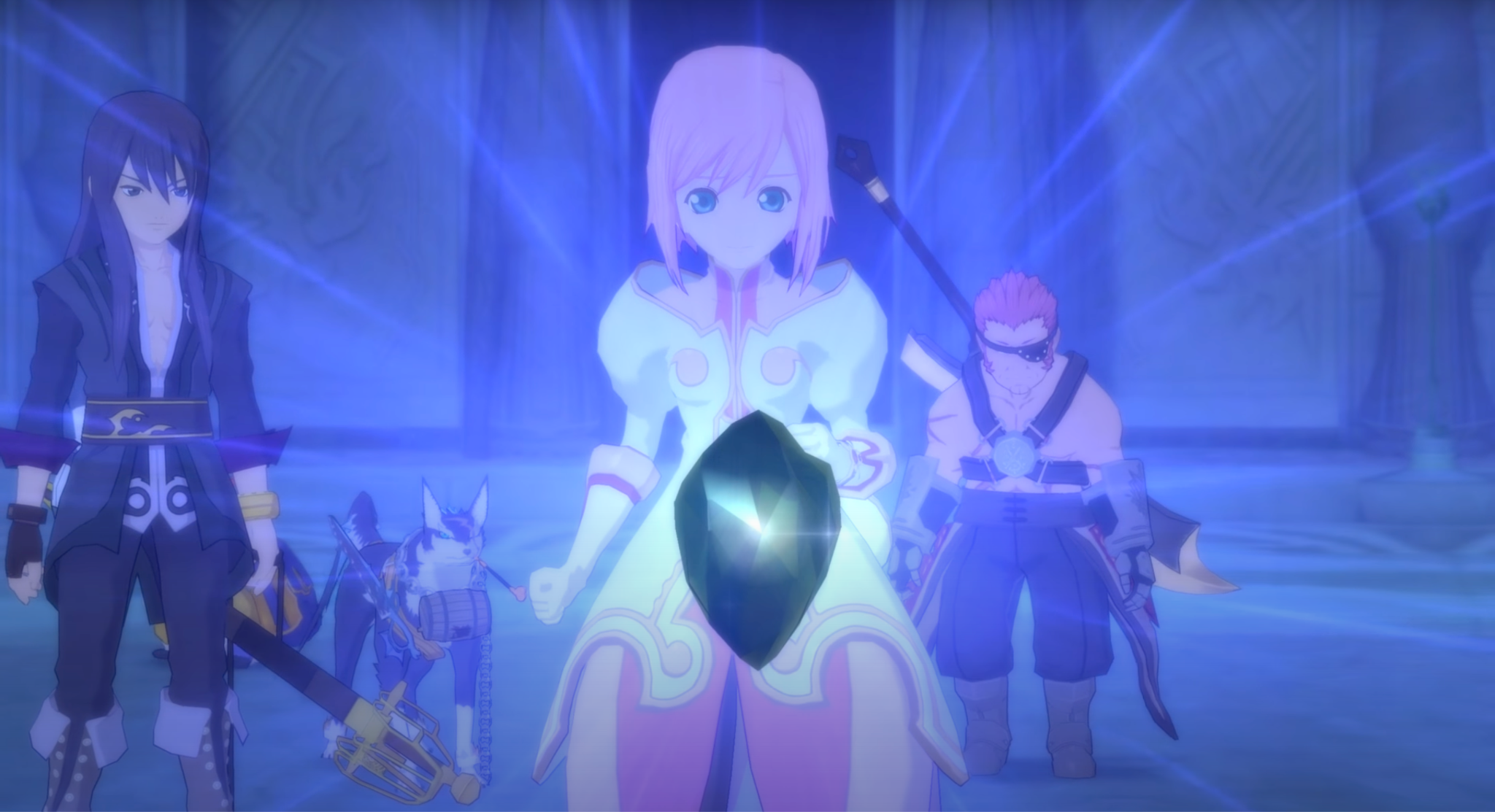
Belius’ soul, the Cyano Ciel Crystal Apatheia, which she asks the party to convey to Don Whitehorse—her final request after she cedes her life to Estelle’s powers.
In a symbology where Dein Nomos represents the collective principle of will to effect change in the chaotic energies of the world, the apatheia is a living testament to individuals’ failure to marshal this chaos: a jewel embodying the overflow of aer which an Entelexeia consumed in an effort to balance the world over the course of its lifetime; a jewel which individuals misinterpret as a conduit for their own agency, using as the basis for the blastia that only further exacerbate that overflow. The birth of Belius’ apatheia as the output of this conflict is the metaphorical and literal crystallization of the chaos that has lain latent in the party’s journey so far, demonstrating that these various groups which Brave Vesperia encountered on their journey to find Phaeroh were nowhere near as unrelated as they seemed—yet nor are any of them, especially Brave Vesperia, as unified in purpose as they believe themselves to be.
Where betrayal by those outside the group motivated a clarification of agency in Tales of Destiny, the death of Belius and emergence of the apatheia catalyzes betrayal from within the group to achieve a more open, deliberative method for coordinating agential clarity. In the same way that Estelle suddenly discovers that her blastia-free healing can be a force of destruction, the groups who have assumed an alignment in their members’ intentions suddenly discover their actions may not serve their assumed course after all:
- Yuri reminds Flynn that the Flynn Brigade’s pursuit of apatheia, enforced occupation of Nordopolica, and the consequent upheaval undermine Flynn’s intentions of being “with the Knights to change things like [exerting the empire’s will by force],” running the risk of merely “follow[ing] Cumore and Ragou’s examples”—an indictment that rattles Flynn enough for him to fail to give his lieutenants any orders to pursue the party as they escape Nordopolica by sea.
- Flynn, who witnessed Yuri killing Cumore and learned of his identical role in Ragou’s death, takes their confrontation as an opportunity to expose him as their killer to the whole of the party, including the rest of Brave Vesperia.
- In the group’s flight from Nordopolica aboard the Fiertia, Judith witnesses the ship’s Ceres blastia resonating with Belius’ apatheia, leading her to recognize it as a Hermes blastia and destroy it on the spot, outing herself as the “dragon-rider” the group encountered earlier in their journey, declaring flatly, “This is the path I have chosen,” and abruptly departing from the party—and from her sworn guild.
- Harry realizes that the intelligence conveyed to him by Leviathan’s Claw that “an ally of the Don’s [Belius] had been captured by a monster [possessing apatheia] was a sham,” leading to the death of that ally and a seemingly irreparable fracture between the Union, Palestralle, and the guilds as an overall ecosystem.
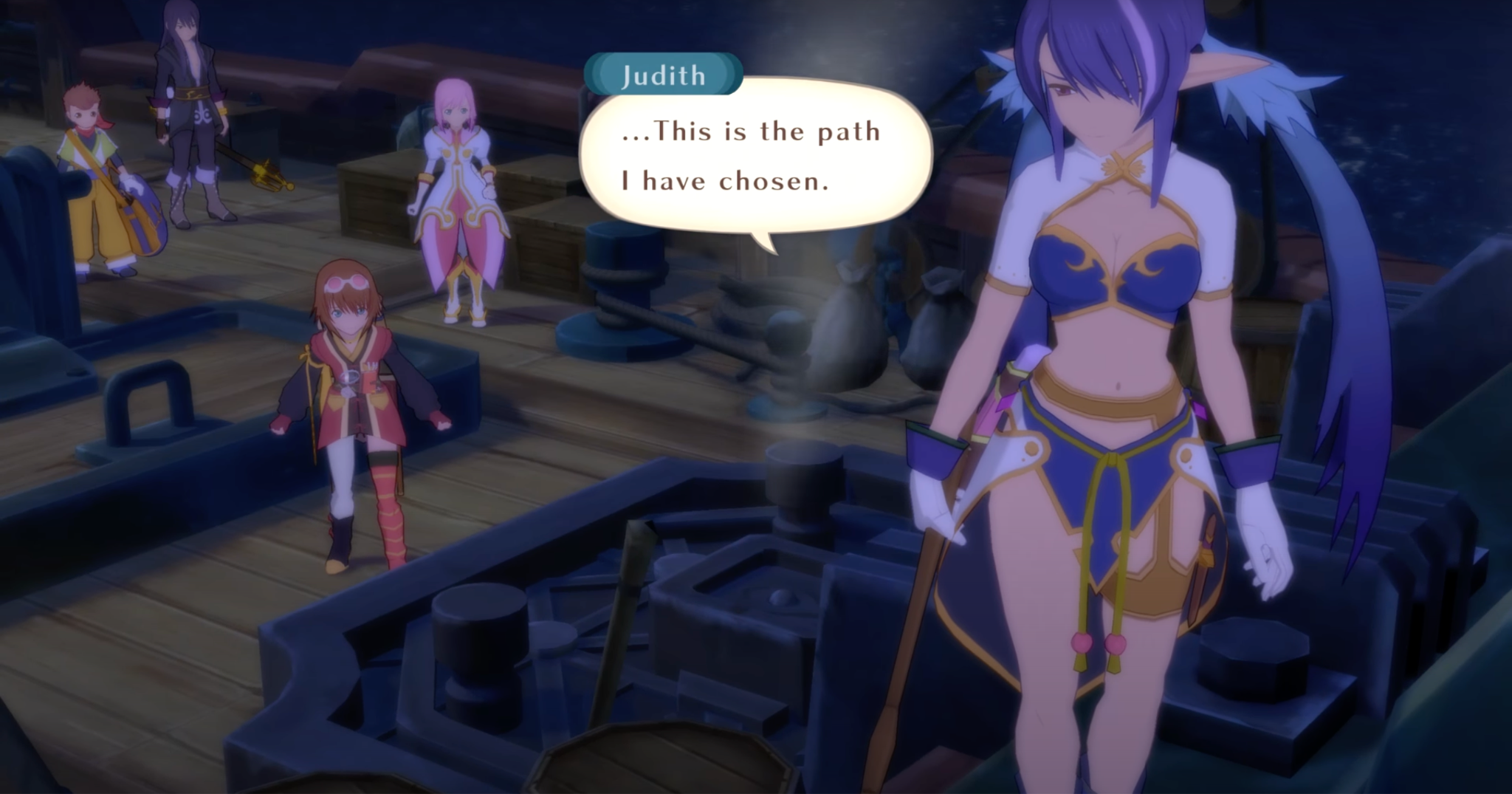
Judith shatters the superficial cohesiveness of Brave Vesperia by revealing herself as the “mysterious dragon freak” who dogged their travels and enraged Rita by routinely appearing to destroy unusual blastia earlier in their journey.
In the wake of this revelation of countless diverse, mutually incompatible individual paths where communal order had previously been perceived, it’s not obvious how the pieces of any of these groups can be put back together. For our heroes, this path to rectification comes from the act of the seasoned founder of the Union—perhaps the only person in the world with the necessary personal history to set groups on the path to a healthier future for themselves and each other.
Don Whitehorse brought the guilds together under the Union banner to “once again return to the basic principles behind the guilds and join our strengths together as one.” For the sake of restoring the ethos that motivated that ancient oath of the Union, he breaks the letter of the Union’s laws: first confronting Yeager one-on-one beyond the court of the Union, under the cover of darkness, to right the wrong of Leviathan’s Claw misleading Harry; when he runs out of time to kill Yeager before the onset of civil war among the guilds in Dahngrest, he sacrifices himself in an act of seppuku, suicide in defense of one’s honor, to buy the guilds the autonomy they need to chart a new future for the world rather than collapsing inward upon themselves.
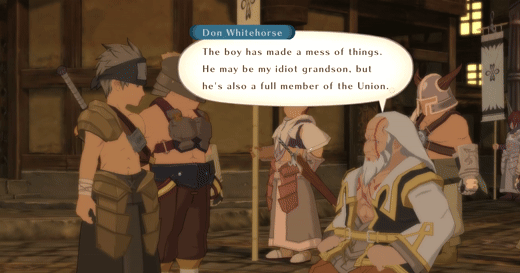
The Don expresses to Palestralle his wish to settle the debt incurred by Belius’ death with his own.
As the Don acknowledges through his confrontation with Yeager, the Union isn’t ultimately at fault for Belius’ death: his grandson was made the unwitting pawn of Leviathan’s Claw, which, (presumably) unbeknownst to the Don,[7] is the pawn of Alexei, sinking his influence into all factions of the world for his own purposes. But the Don understands that Belius’ death points to a more foundational problem endemic to the guilds, one which only he can cure: the guilds operate at petty cross purposes with one another, unified only by a vacuous allegiance to the principle of autonomy outside the empire, an ideal which—like the laws of Brave Vesperia—have become more of a decorative justification than maxims which coordinate everyone’s activities for the sake of something greater. Barbos, the leader of one of the Union’s five master guilds, conspires against everyone for the sake of his untempered ambition; Yeager uses his leadership position within Leviathan’s Claw and his disguise as Ruins’ Gate leader Regaey[8] to quietly advance the agenda of Cumore and, ultimately, Alexei. The same man who once called for the joining of strengths that established the Union has now become a figurehead for the ghost of that Union: even when he knows full well, during the first-act collusion between Barbos and Ragou, that Flynn unwittingly delivered him a forged letter of conspiracy from Price Ioder designed to pit the Union against the empire, he admits to Yuri that “we’ve got a lot of hotheads around [Dahngrest] who’d never let me hear the end of it if I didn’t raise hell,” sending Yuri to find the actual root of the problem while he takes his place on the battlefield as more of a scapegoat than a leader—none too dissimilar from our initial perspective on “Boss Karol,” so-called from his desire in formulating a group rather than his direction of that group.
The Don routs this unspoken misalignment from the guilds through an inversion of Belius’ death: Belius’ death was thrust unexpectedly upon her by a previously unrecognized chaos, the Don chooses to express his death as a gesture calling those around him to walk their own path out of the chaos, and demonstrating how they can do so.
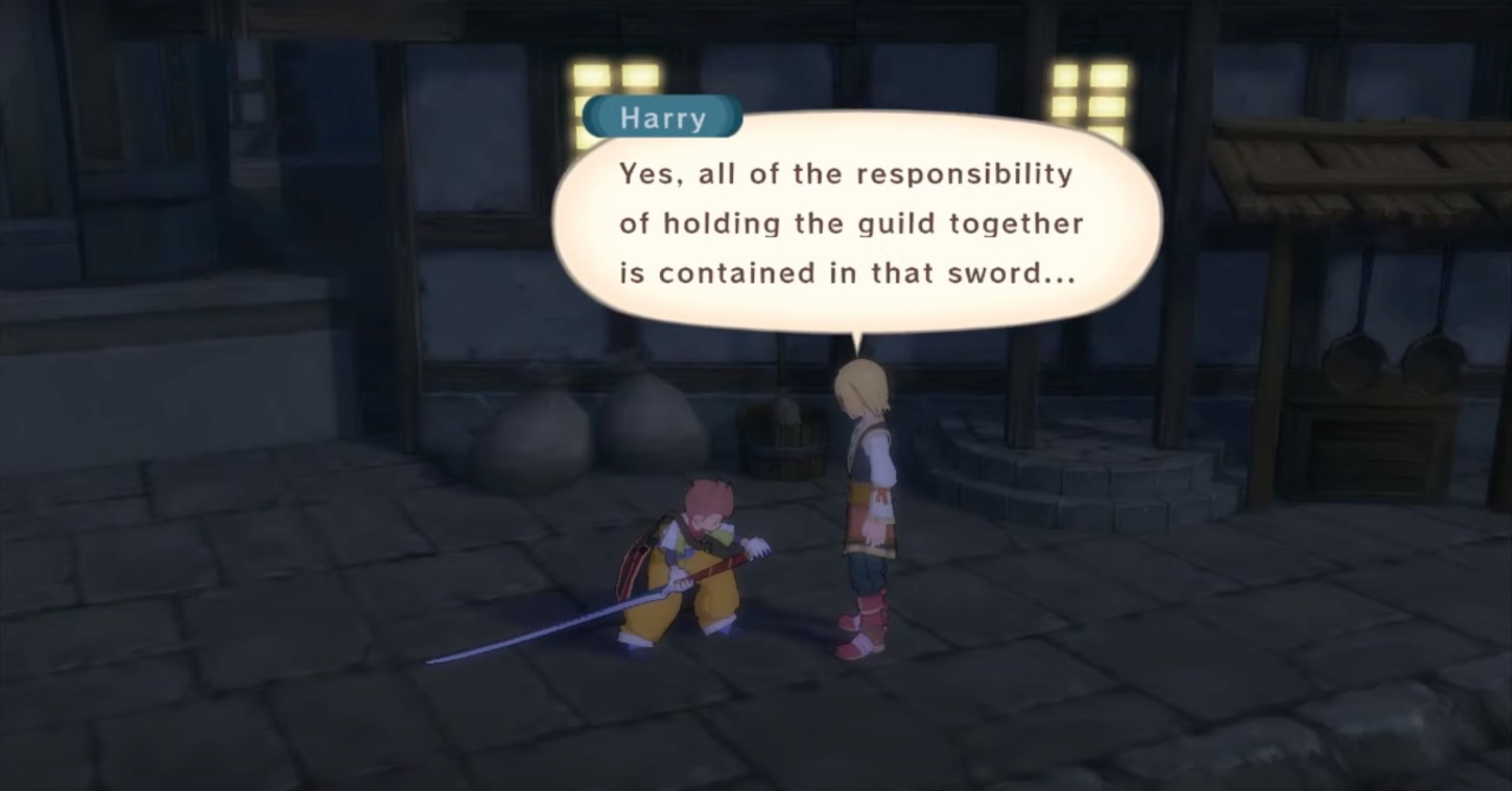
Harry and Karol reflect on the literal and metaphorical weight of Don Whitehorse’s sword in a nighttime training session after the Don’s death.
Unlike Duke, Yuri, and Alexei, Don Whitehorse never wields a version of Dein Nomos, but he does bear a special sword of his own: one which highlights the Don as a kind of “inverted Dein Nomos,” parallel to the inverted relationship of master and Swordian in Leon and Chaltier. Where Dein Nomos represents the collective will of individuals in a community to bring about a particular outcome, the Don’s sword is heavy with “all of the responsibility of holding the guild together”: his individual will is that of someone who calls others to collaborate in a community, not acting individually in accordance with an ideal but rather bringing about the self-awareness for everyone else to formulate their own ideals together. This principle of will forged the Union in the first place; years later, in the chaotic twilight of the Union, this will demonstrates that the ideals of a guild are only as robust as the individual contributions in public service of creating those ideals.
On this interpretation, the Don’s death is so resonant, penetrating virtually every group across the network of Terca Lumireis, because it dismantles the facade of group unity in favor of true, outspoken advocacy for shared values: the Don kills the figurehead he had become, and, in so doing, provides those who bear witness with a model of how those within a guild can keep the guild alive by holding it accountable, even when the chaos of the world provides excuses according to which they could avoid that accountability (e.g., blaming Leviathan’s Claw rather than the Union for Belius’ death). The Don calls everyone to stand on their own two feet and make a new age for themselves; he’s advocating for those people who have seen their communities lost in the noise and schemes of the world theater to reclaim them by explicitly taking themselves and their comrades to task for their actions, for that explicit accountability eliminates the conceptual space in which outside manipulation can instigate itself.
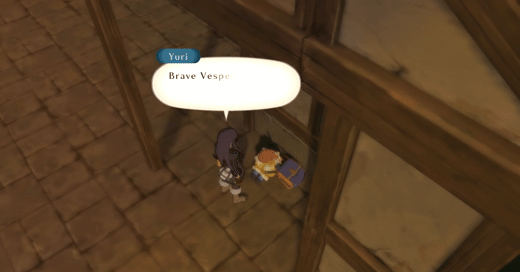
Yuri forces Karol to face the reality of Brave Vesperia in his moment of despair following the death of the Don.
The Don’s gesture gives both Yuri and Karol what they need to reconcile their natural inclinations with the reality of what they want to achieve through Brave Vesperia. Yuri—the erstwhile judge, jury, and executioner—takes up the public-facing role of kaishakunin, the Don’s second, beheading him as a gesture of mercy in enacting the Don’s chosen method of settling accounts across the guilds, rather than Yuri’s. This gives him the perspective and resolve to confront Karol when the loss of Karol’s role model cripples him, plunging him into self-doubt, prompting him to insist that he hasn’t moved beyond his desire to start a guild in order to “follow in the Don’s footsteps” and that, without the Don, there’s no guild left for him to lead: Yuri flatly tells Karol that Brave Vesperia is more than him now, and that he will pursue Judith on its behalf regardless of whether Karol joins him. This reality of the guild beyond Karol’s desires gives him the confidence not only to rejoin on his own terms, but also to reject the title of “Boss” which Yuri had foisted upon him: he recognizes that he has to earn the title through action that causes others to authentically recognize him as the boss, and in a way that allows him not to feel embarrassed when someone calls him the boss.
Fittingly, this process gives Karol the space and permission he needs to eventually do exactly what he fears he can’t: follow in the Don’s footsteps by articulating a way of settling accounts for Brave Vesperia that mirrors the ethos of Whitehorse’s self-sacrifice. When the party finds Judith atop Mount Temza and defends her and Ba’ul against the Hunting Blades—Karol’s former guild, which learned no apparent lessons from the death of the Don (aligning behind their ideal: the “credo,” or dogma, that “monsters are evil” to be hunted categorically)—they call on her to account for herself so that “[her] answers will decide [her] fate,” but they also show her that they’ve learned how to publicly align behind shared ideals and context in a way they couldn’t before: the guild joins her in defending Ba’ul against the Hunting Blades’ dogma, and Estelle takes Belius’ guidance to heart, “healing” Ba’ul with her kindness and support of his evolution, rather than impulsively using her poisonous healing artes on him. This demonstration of the lessons they took from the Don’s sacrifice invites Judith to reciprocate, opening up to her guildmates about her past for the first time.
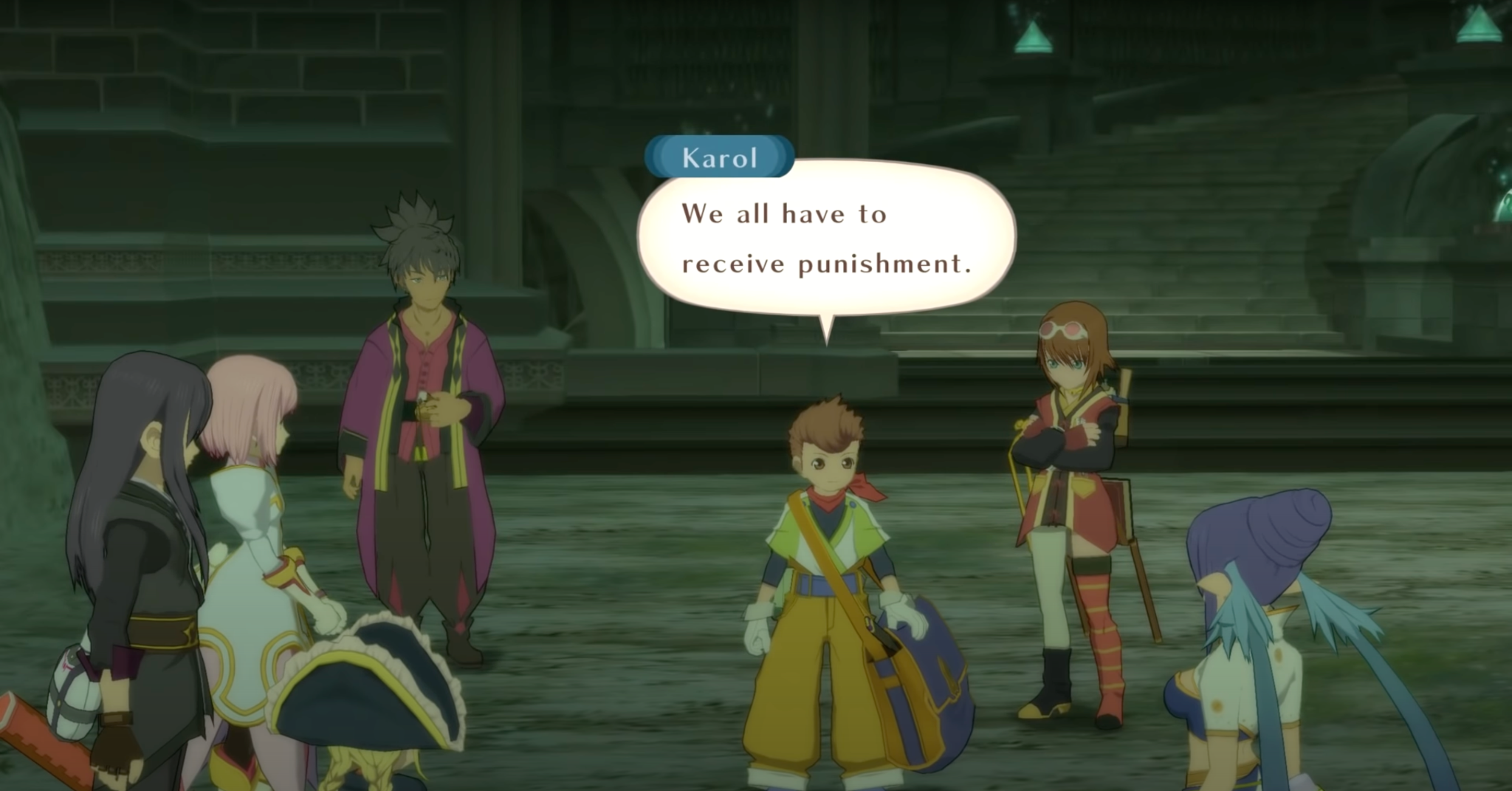
Karol decides on the fate of Judith—and of Brave Vesperia—as they seek out the Krityan homeland of Myorzo.
Karol deliberately takes his time to decide on how the guild should handle Judith’s betrayal after she and Ba’ul rejoin the party, and I think a decisive unspoken principle in his reflective process is that a fair judgment of Judith requires first observing to how Judith acts in the party now that the guild is more self-consciously vocal about how and why their intentions relate to those of the group. He only decides how to chart the future course of Brave Vesperia after Judith stands up to Phaeroh, whom she knew all along, and convinces him to trust the party’s mission to find a different way for Estelle to live in the world, one which will not upset the balance of aer. Finally, Judith is transparent in expressing both her intentions and her commitment to the guild: in full witness of the party, she promises Phaeroh that she will kill Estelle if her powers reach “their absolute limit,” adding in the next breath that “[she’s] sure Brave Vesperia will come up with something before that happens.” As she prepares to help Brave Vesperia discover that exact solution by introducing them to the esoteric traditions of her Krityan heritage, Karol decides that the best way to for “each of our own paths to be the same as Brave Vesperia’s,” so that they can keep traveling together, is for the entire guild to “receive punishment”:
I didn’t know that Judith was fighting for our planet, all on her own. But even though I didn’t know, I still failed to help a fellow guild member. So I gotta accept my punishment. Yuri. […] Maybe you were trying to “follow your own path,” but you still kept things hidden from us. There’s no way that can be for the good of the guild. […] So you gotta be punished, too. […] What if someone does the right thing, but still breaks the law. Should they be punished? To be honest, I just don’t know yet… So that’s why we should all just accept our punishment and start over from scratch. […] I…I just wanted to keep traveling with all of you. I just wanted each of our own paths to be the same as Brave Vesperia’s.
Raven is quick to tell Rita that Don Whitehorse ran Altosk “just a teensy bit differently” than Karol’s seemingly ad hoc way of legislating Brave Vesperia, but I think that Karol’s approach closely emulates the last act of his role model. The Don took responsibility for something which wasn’t ultimately his fault for the sake of effecting clarity and the coordination of individual members in the guilds; similarly, Karol sees the most important element of Brave Vesperia’s future as its path aligning with the intentions of its individuals, something made possible by a kind of dispositional atonement: the praxis of the group is to accept punishment for acting solipsistically, intentionally or otherwise, in relation to your fellow guild members—the content of the punishment itself is beside the point, whether that’s the Don sacrificing himself for Yeager’s machinations or Karol sentencing Brave Vesperia without bothering to decide what their actual punishment ought to be (and, fittingly, when Rita ultimately decides their punishment, it’s the grunt work of finding a Krityan to guide them to Myorzo—the next leg of their publicly aligned journey together).
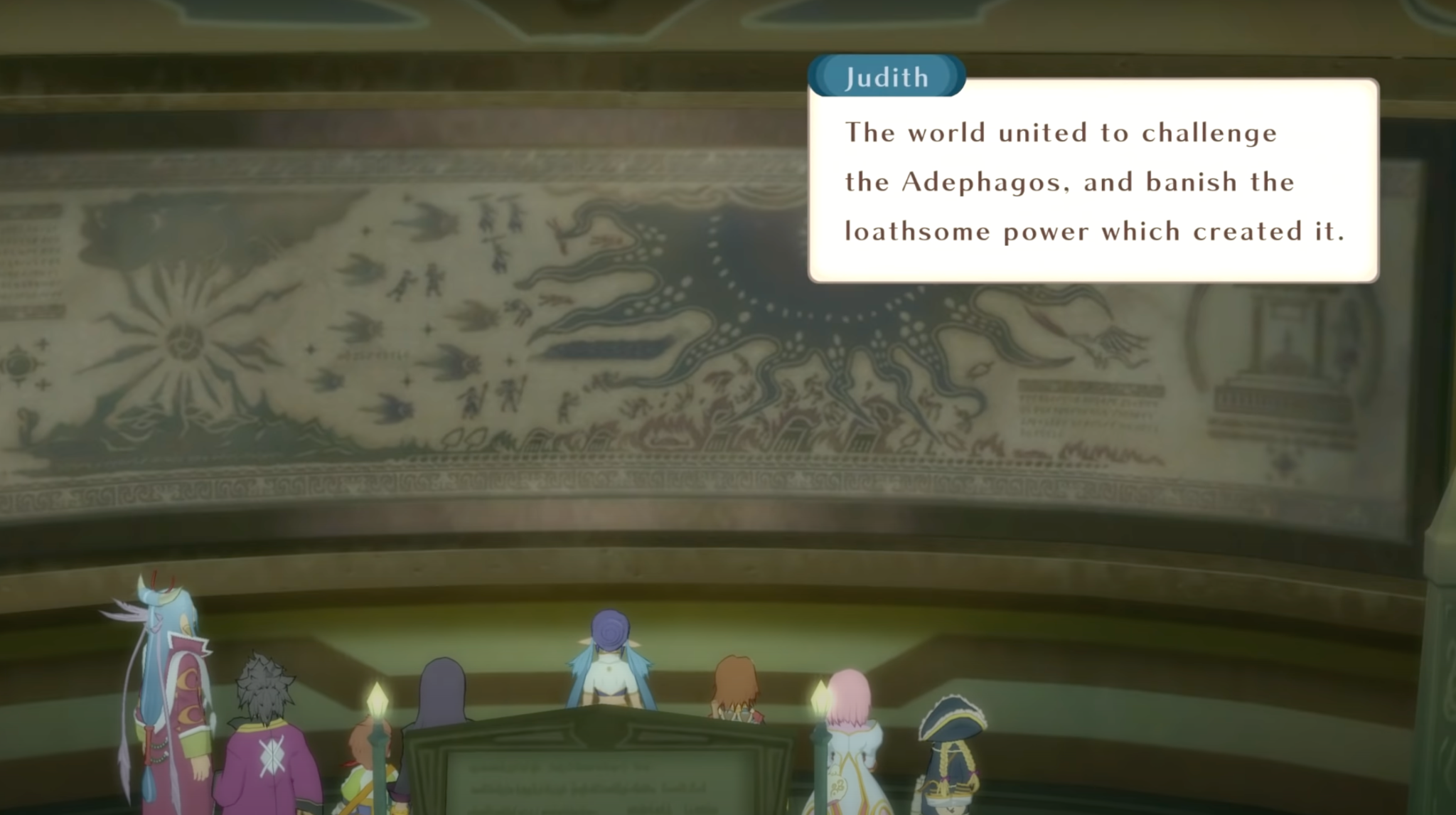
Judith’s use of the nageeg unearths the Krityan lore for the party, giving them a new framework for the narrative within which they situate their future actions as a guild and party.
The journey for the party to establish its guild and act more honestly with each other isn’t just one of establishing community: it’s also one of developing a culture within which to consume and tell stories, weaving a kind of folklore as the party uncovers what it means for them to engage the world as unique yet interrelated actors. Where Tales of Destiny‘s second act revealed fixed relationships between the events of the past and those of the present, Tales of Vesperia routinely bottoms out in fairy tales, rumors, myths, and other narrative frameworks that offer its characters ways to relate to the chaos of the world without definitively describing or explaining the world’s past. As the party decides how to use public accountability to align their actions according to a single principle of will, they accordingly transition from being embedded in these narratives with no orientation or agency to telling stories as a means of more easily maintaining that alignment between individual and group.
- Initially, the party finds itself nestled with minimal context in fairy tales, like: Estelle’s tale from a book about “a monster that speaks who lives in the Sands of Kogorh” when pursuing Phaeroh; naming their guild based on Estelle’s inspiration from an “old story” of a brother and sister saving the world from calamity, the brother subsequently ascending to the sky to watch over the world; experiencing a sort of “story out of time” when Phaeroh projects them into a vision of Yormgen from the past, showing them the story of a community without blastia; and falling into the chaos of a tall tale told by the empire about Belius’ involvement in instigating the poorly-understood Great War 10 years ago—a war whose facts are “shrouded in darkness,” according to Estelle, even in official government histories.
- As Brave Vesperia resolves to find Judith and hold its traitor accountable, they learn more about the context within which the Great War applies to them and their own trajectories of action by hearing Raven’s stories about his own time in the war as they cross an actual former battlefield on the way to Judith, coming to understand both Judith and Raven better even before the latter reveals his full identity to them.
- Once Judith rejoins the party, they begin to take agency over these stories: challenging Phaeroh’s narrative of the Child of the Full Moon as an “insipid poison” destined to oversaturate the world’s aer supply; Judith’s initiation of the party into the Krityan art of the nageeg, surfacing the stories within objects, provides them with the context to situate their actions within the broader story of the global ecosystem’s relationship with blastia, raising the question of how they can guide their own community in a way that overcomes that narrative without recapitulating it; even the story of the Child of the Full Moon becomes a narrative path by which the party is able to decode and unlock the hidden Sword Stair of Zaphias Castle, a passageway which Alexei himself could only access by force, using Estelle as a tool.
That this agency over folklore develops in tandem with the guild’s capacity to align its members’ actions and desires with its collective goals accounts for a key difference between the traitors in Act 2 of Tales of Vesperia and the traitors in Act 2 of Tales of Destiny: the traitors of Terca Lumireis are corrigible, capable of being corrected and brought back into alignment with the heroes’ party. The relationship between past and present contexts are so rigid and deterministic in Tales of Destiny that the only way to escape imprisonment is to avoid those temporal perversions in the first place: Hugo sends Rutee away, and Rutee has an opportunity for self-determination; Emilio stays with Hugo, and Leon is incorrigibly subjugated. On the other hand, in a world where characters are adrift in a chaos without a clearly defined past, agents can only anchor their desires to broader communities through the stories which they and others tell about themselves—and if a story can be told that casts one in the role of a traitor, like the story of Judith’s interpretation of the underspecified Brave Vesperia’s laws, then another story can be told to redeem one from treachery, like the story of Brave Vesperia according to which those acting according to a solipsistic justice are punished by the guild. Similarly, a character already caught between two narratives can use this fluidity to shape his own agency and free himself from whichever narratives subjugate him to the will of another—if only he has some help along the way.
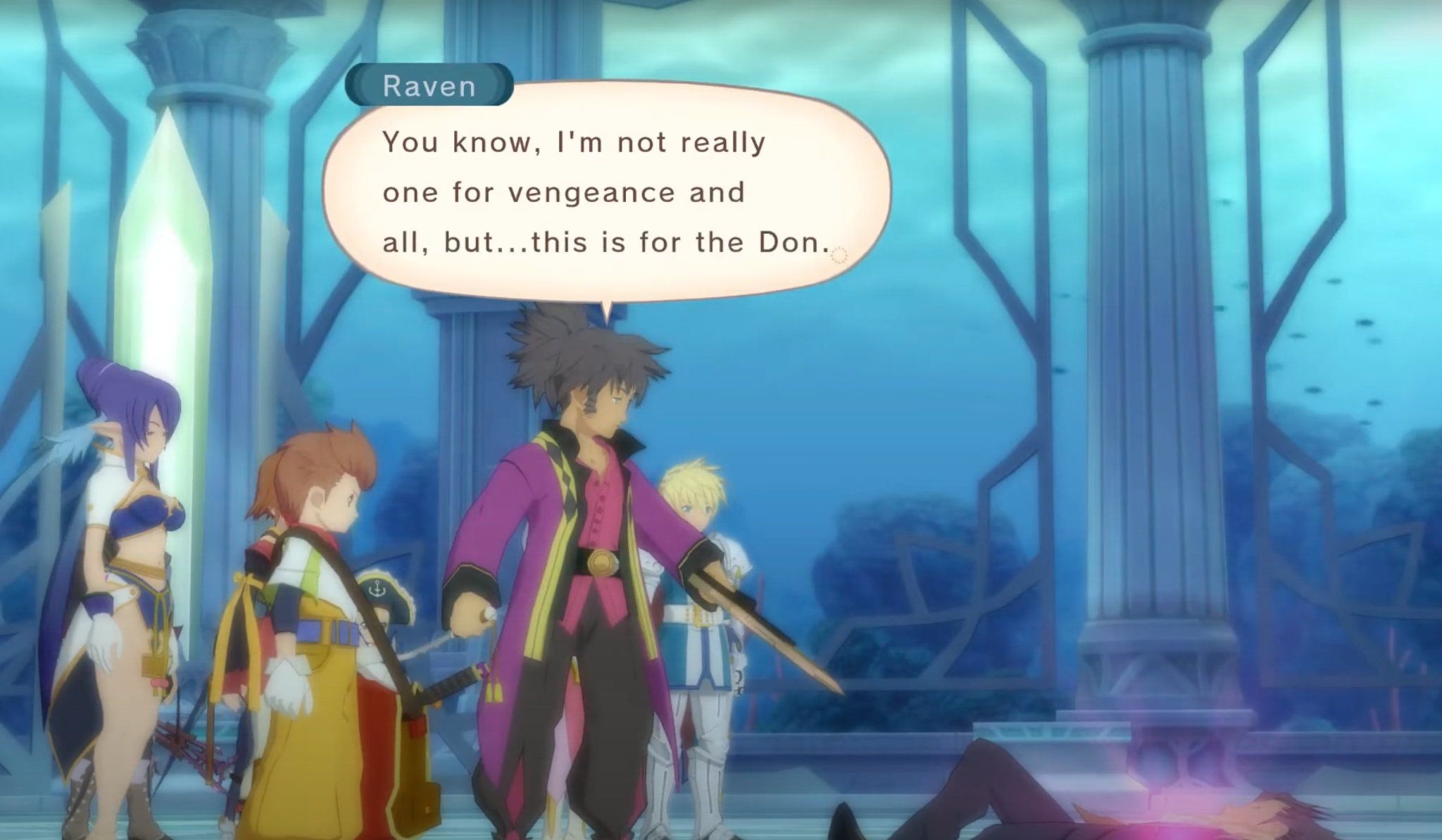
Raven and Yeager—two bound to Alexei, two bonded to the Don, and two juggling multiple identities even beyond these relationships—face each other for the final time in Zaude.
After briefly dwelling on Cumore—a lieutenant so obsessed with the narrative of his seizing the role of Commandant for himself that he falls helplessly, completely, into Alexei’s hands—Act 2 focuses on those enslaved to the ideology of an antagonist while existing in a liminal space between different narratives, identities, and roles. Chief among these are Raven and Yeager: two pawns of Alexei oscillating between the guilds, the empire, and their personal relationships that don’t fit neatly into either category. Both men bear a blastia “heart,” animated by their own life force rather than aer. Like the apatheia at the heart of Belius, these hearts are a telling metaphor for the role of these characters at this point in the arc of the parties developing their capacity for volition: as other blastia unnaturally filter the chaotic energy of aer into a single, formulaic expression, so these two blastia unnaturally filter the diversity of their bearer’s motivations, intentions, and desires into a single role, over which the “user,” Alexei, asserts authority. Raven juggles the roles of Imperial Knights Captain Schwann Oltorain, Altosk lieutenant, and comrade of Yuri and his friends in service of Alexei’s agenda to amass apatheia, while Yeager juggles his role as leader of blastia dealer guild Leviathan’s Claw with his other guise as Regaey, leader of blastia excavation guild Ruins’ Gate, to control the flow of hoplon blastia to Alexei to facilitate his blastia network—each serving one side of Alexei’s plan to develop his own Dein Nomos and impose his ideals across the world.
Both of these men were involved in, and apparently salvaged from, the Great War, and their personal identity mirrors the societal mystery of events like that same war—not unlike Irene and Baruk showing the flight to idealism from both societal and individual perspectives.
- The two seem bonded through a shared intimate connection from wartime named Casey, about whom Raven will scarcely elaborate, and whose very recollection is shrouded in a mysterious providence: How did Casey’s compact fall out of the sky upon Raven offering Casey’s favorite flower at Mt. Temza? How did Yeager end up with Casey’s bow?
- Even if the party takes the time to investigate the relationship between Leviathan’s Claw and Ruins’ Gate in sidequests,[9] they find no definitive confirmation that Yeager really was Regaey rather than that he was impersonating Regaey, regardless of their inverse relationship between their names inviting that conclusion, leaving the scope of Yeager’s overall role ambiguous; even Alexei’s role in Yeager’s blastia heart, along with Yeager’s motives for donating to the Capua Torim orphanage and taking Gauche and Droite into Leviathan’s Claw, are all depicted just enough to remain mysteries, unresolved possibilities between Yeager as sympathetic and Yeager as heinous.
But the centerpiece of the Don’s death offers Raven and Yeager a new lens through which to define themselves, just as it does for the guilds. Don Whitehorse directly charges Raven to “nail Yeager for [him],” and Yeager solemnly pays his own respects to the Don after bringing about his death. Though Raven betrays the party as a member and Yeager is an enemy from without, I think this sacrifice provides them both with a path out of their servitude parallel to Brave Vesperia’s philosophy of punishment and the settling of accounts.
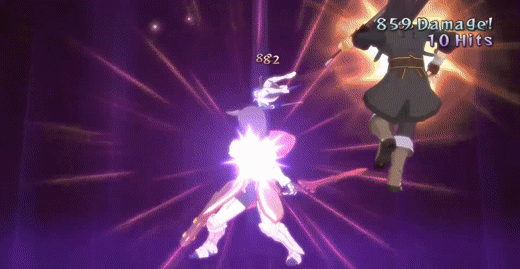
To fulfill the Secret Mission in the battle against Captain Schwann, the party can break his stance after he uses Alexei’s blastia heart as a bomb—an expression through gameplay of Brave Vesperia’s capacity to work outside the expected paradigm of the battle, the expected role which Alexei expects Schwann to play as a boss, to disarm Alexei’s influence and call Raven back to his friends.
With Brave Vesperia cultivating their own idealism juxtaposed against the totalitarian machinery of Alexei, Raven and Yeager can refocus their life energies away from Alexei’s formula by allowing Brave Vesperia to “shatter” the role expressed by that formula, not unlike Judith’s initial approach to shattering Hermes blastia to rebalance the aer. Raven achieves this in a heartwarmingly (no pun intended) symbolic turn by, following Alexei’s deployment of him as an attack dog against the party in Baction, interpreting his defeat and burial in the shrine as the death of Captain Schwann, the identity over which Alexei held sway—leaving Raven to escape, rejoin the party, and “settle accounts” with Brave Vesperia as Judith did, handing over ownership of his life to them as punishment and thereby enshrining himself within a narrative that affords him an agency Alexei denied.
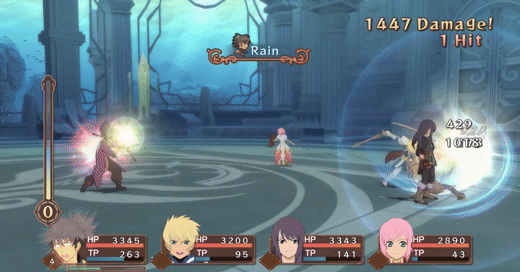
To fulfill the Secret Mission against Yeager when he guards the path to Alexei in Zaude, Raven can pay forward the lesson and fluidity of personal narrative which the party conveyed to Captain Schwann in Baction: disarming him by penetrating his guard and shooting an explosive arrow into his blastia heart, the symbol of his bondage to Alexei.
While the reality of Yeager’s character is murkier, the Don’s death seems to awaken something in him, as it is he who directs the party to Baction and Zaphias when they are trying to find and free Estelle from Alexei’s grasp. Seen in this light, I think that we might read his final confrontation against Brave Vesperia in Zaude, explicitly defining himself and them as “sworn enemies,” as a similar act to Raven’s, perhaps even inspired by his example: while Yeager, the pawn of Alexei, dies in service of Alexei, his act also frees Gauche and Droite (whom he refuses to involve in the battle) from Alexei’s grasp-by-proxy and affords the party the opportunity to discover and remember him according to his broader, ambiguous legacy. Though the “truth” of his involvement with Casey, the Great War, and the orphanage remain beyond our grasp, his act affords us with the standing to unearth these stories and contemplate the holistic picture of Yeager in this light, beyond his role as Yeager’s puppet—a blessing unavailable to Barbos, Ragou, and even Cumore.
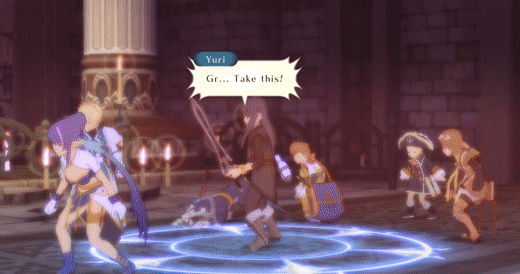
Yuri wields Dein Nomos against Alexei’s system of Estelle and apatheia in Baction.
After Karol has articulated the governing, punitive principles of Brave Vesperia, the party doesn’t just gain agency over the narratives it navigates: it develops the ability to wield its principles as a narrative, an idealism, combating those of others. This constitutes their first step toward bearing the kind of communally defined principle of will symbolized by Dein Nomos—a step acknowledged by Duke, who lends Yuri the literal Dein Nomos at this juncture in the story. When Alexei deploys Schwann to kidnap Estelle following the party’s revelation of Myorzo’s lore and begins abusing her powers to kill Entelexeia and gather more apatheia, Duke appears at Baction—the site of Alexei’s assault on the Entelexeia Astal—which the intention of “remov[ing]” the “cause of imbalance” in the region’s aer krene: Estelle, whom he describes as “[a]n unstable Child of the Full Moon.” Yuri stands up to Duke by pointing out that Duke’s narrative is the same as Phaeroh’s, countering that Estelle is “one of ours” and that Brave Vesperia’s “motto,” which motivates them to stand up for Estelle regardless of the implications of her abilities, is “always do what’s right.” This invocation of Brave Vesperia’s guiding, publicly avowed and upheld ethos prompts Duke’s challenge for Yuri and his friends to “show [him] that resolve which so impressed Phaeroh,” giving them Dein Nomos as a means of quieting the chaos of overstimulated aer—giving them Dein Nomos as a representation of the idealism which they have already learned how to enact.
It’s during this sequence in the story—with Dein Nomos temporarily in Yuri’s hands, molded in color and moveset to the praxis of its current wielder—that the party first saves the people it cares about from the narratives of other toxic ideologies by offering them a different way in which to tell their stories.
- “Schwann” dies and “Raven” gives his life over to Brave Vesperia in quick succession in Baction and Heracles.
- The party channels their faith in Estelle, in her ability to express kindness without laying waste to the world, into Dein Nomos to overcome the bindings of Alexei’s apatheia, freeing her from his control at the moment atop the Sword Stair when she’s fully lost her will to resist Alexei’s description of her as a “tool” for his own plans, a “poison” that can only become a ‘blessing” when subsumed in his system for terraforming the world according to his own totalitarian, imperialistic vision.
- On the way to save Estelle, in the Blade Drifts of Zopheir, Karol steels himself and overcomes a monster preying on his aersick friends—friends oversaturated with the chaotic energy from an overclocked aer krene—by seizing a stray giant sword (the same kind of sword that shattered in his hands when he was internally emulating Clint, the leader of a guild with no institutional interest in him as an individual[10]) and standing up for Brave Vesperia’s principles in the guise of another piece of the Don’s advice: “Take care of your friends and they’ll be there when you need them.” Karol’s display of coalesced will catalyzes Rita’s observation that the ice of the Blade Drifts was probably a stabilized, solid, manipulable form of aer—a meditation on stabilized chaos that prefigures her development of mana in the third act.
- Even Flynn, who admits to Yuri that he allowed himself to be manipulated by Alexei through blind allegiance to Alexei’s ideal that “[t]hose who are just will lead lives of prosperity,” receives a directive from Prince Ioder to represent the order of the Imperial Knights within Brave Vesperia, taking the guild’s code as a context within which he can “settle things personally with Alexei.”
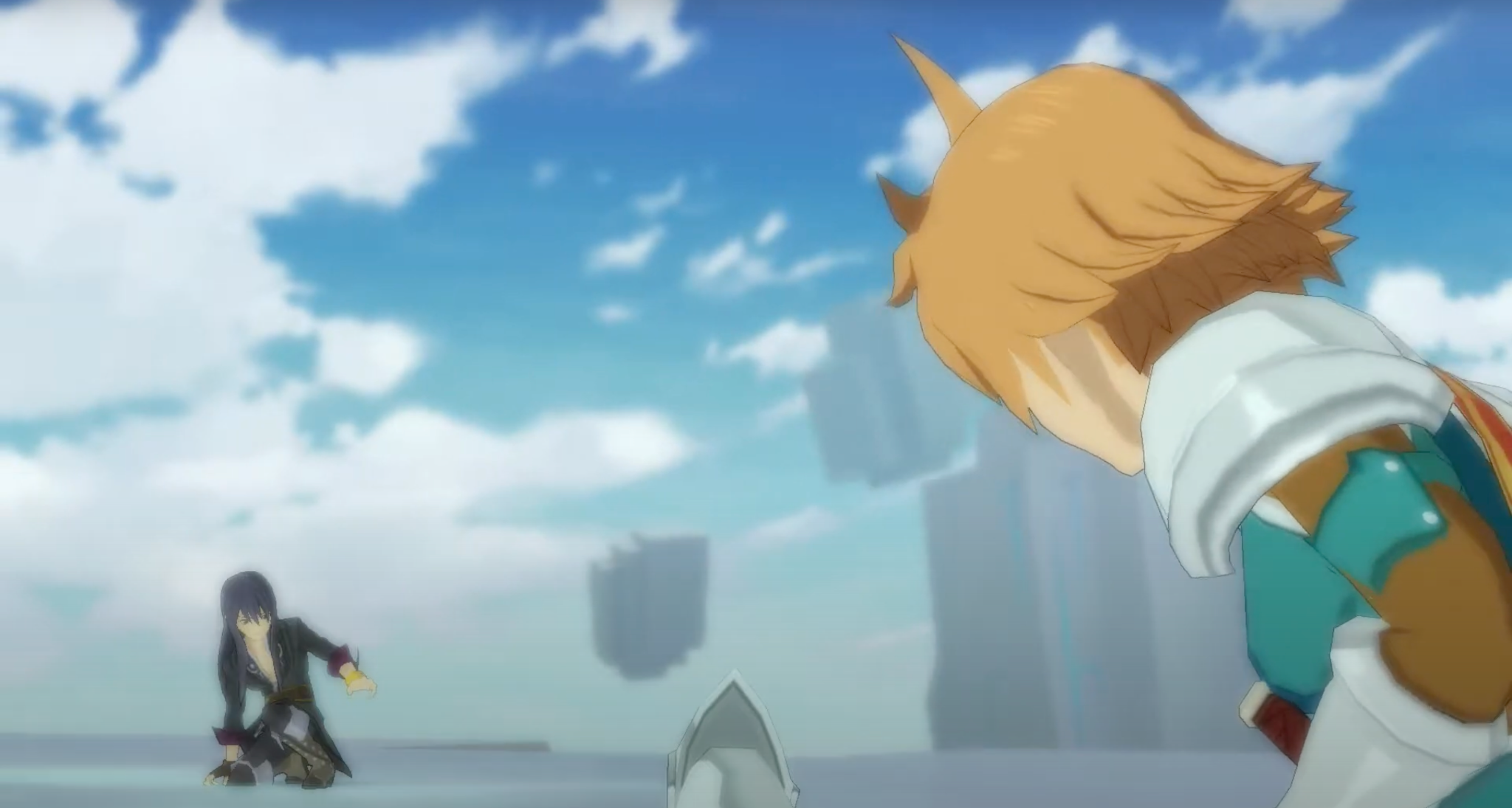
Sodia takes the measure of Yuri atop Zaude after Flynn knocks Yuri out of the way, absorbing the full force of one of Alexei’s strikes.
Yet as much as Flynn may seem empowered by joining forces with Yuri and Brave Vesperia against the ideology of his former Commandant, he ends up caught in the crossfire: a human shield putting himself in harm’s way for the sake of one ideology in opposition to another. The final moment of Act 2 in Tales of Vesperia—Sodia, Flynn’s lieutenant, stabbing Yuri and consigning him to a free-fall from the top of Zaude—might seem like a non sequitur following the party’s confrontation of Alexei, but I think our volition-oriented interpretation illuminates it as a precise indictment of the limitations inherent to Brave Vesperia’s current mode of collective action, willing them to further evolve in the next act.
For all that Brave Vesperia manages to achieve in the game’s second act, up to and including Alexei’s comeuppance, they’ve only managed to define and implement a framework for imposing their own system of ideals upon individuals and advancing it against other idealists like Alexei, in the same spirit that Stahn and the other masters debates mutually incompatible ideals with Ilene, Baruk, and Hugo. We need look no further than the Commandant to see the dangers of this praxis: like Hugo, Alexei believes that the world must be “reborn” through “absolute power,” exerting his totalitarian authority with the cataclysmic power of Zaude—like Hugo with Belcrant—to “free this world from the Entelexeia, from the aer, and from this pitiful empire,” giving birth to a more perfect, global order through an autocratic, fascistic regime. This is Alexei’s synthetic “Dein Nomos”: a principle of individual will he’s quietly cultivated by pulling the strings of those less in touch with their volition (like Ragou and Barbos), by giving those who’ve lost their sense of identity a new purpose with which to ground themselves (like the Royal Guard, handpicked to serve the Emperor in an age with no sitting Emperor, leaving them to be groomed by the Commandant instead), and forcibly co-opting people to use as tools according to their “purpose” within the framework of his intended course of action (like Estelle as a Child of the Full Moon, interacting with Alexei’s apatheia and blastia sword as a human-powered Dein Nomos replacement; like Schwann and Yeager, turned from fallen warriors into reanimated slaves, prefiguring Leon in the third act of Tales of Destiny).
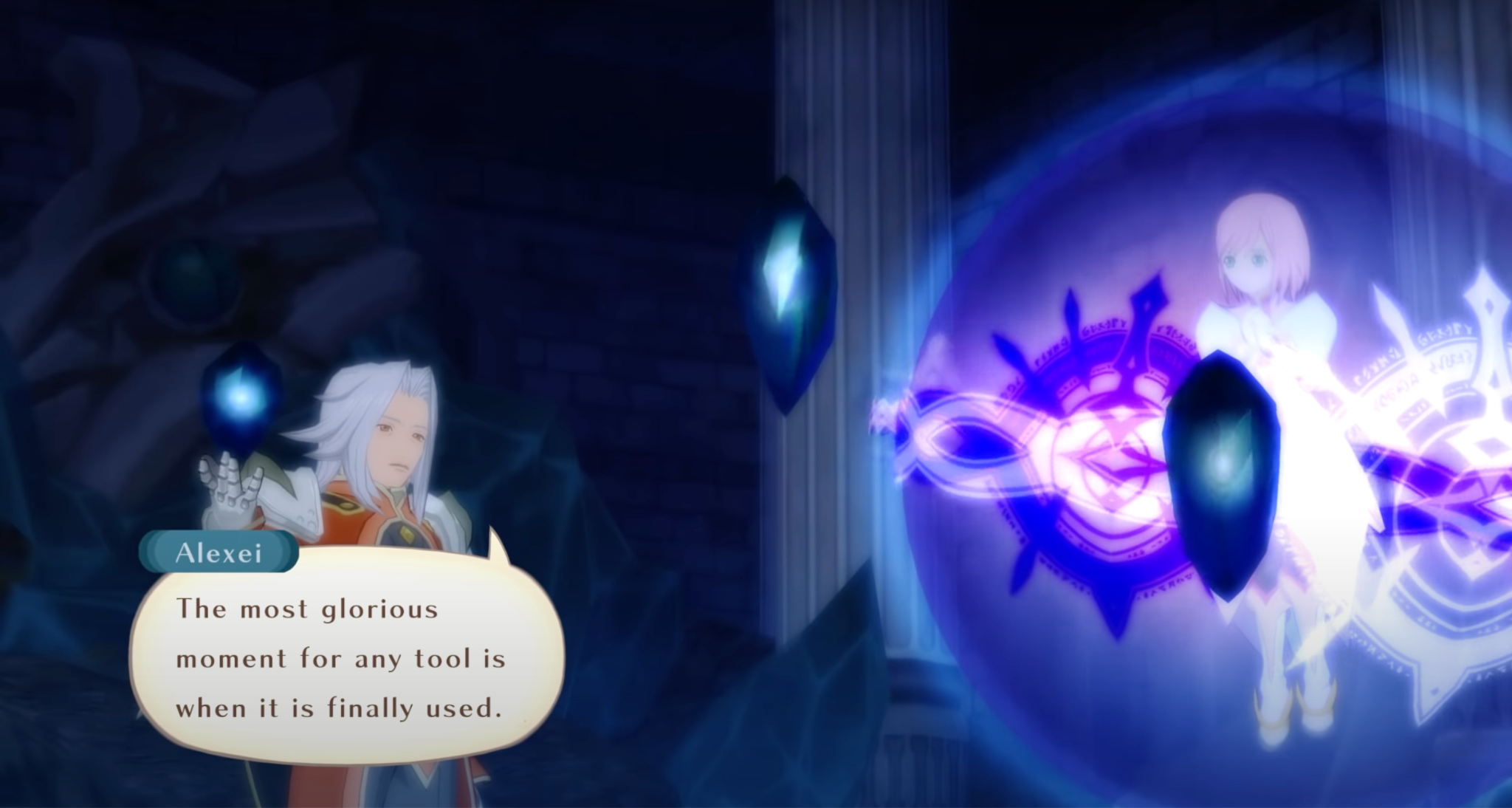
Alexei boasts about his laughably convoluted system as though it were the only natural context in which Estelle could find meaning.
Beyond the immorality and disenfranchisement of the means Alexei takes to realize his ends, the story makes evident that the ends he pursues, like Hugo’s, go no distance toward actually determining a new course of action for the world. The unnatural, jerry-rigged nature of Alexei’s “system” represents this almost comically: the Commandant believes that he can reshape the world using a patently convoluted system of apatheia, an imprisoned Child of the Full Moon, a sword, and an ancient ruin which he takes to be the equivalent of a nuclear warhead stockpile (this coming to fruition only after Judith and the party undermine his equally convoluted global network of Hermes blastia). Alexei is haphazardly shoehorning individuals and resources from across the world in pursuit of his singular course of action, and, by subordinating all other agents to himself, he blinds himself to the true, complex dynamics of the world, which govern the present and which must be respected in the present in order to conceive of, and enact, any kind of sustainably different future. Alexei’s story of Brave Vesperia and the Child of the Full Moon—the piercingly bright, channeling light in the sky above, and the Enduring Shrine of Zaude, below—is one of a weapon with which a sovereign could shape Terca Lumireis in his image; in telling this story, he overlooks the relationship between aer, the human channeling of aer, and the Adephagos, only further contributing to the world’s chaotic natural state in pursuit of his new order and stimulating that very Adephagos calamity which subsumes chaotic human enterprises such as his own.
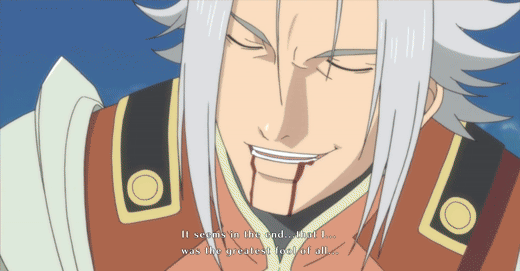
Alexei is finally broken, literally and figuratively crushed under the weight of Zaude as it exposes the depth of his misunderstanding.
But even with a more positive set of ideals than Alexei’s, the party’s story of Brave Vesperia and the Child of the Full Moon doesn’t understand or overcome the natural chaos of the world, either. The guild’s newfound principles of holding each other publicly accountable for the sake of justice provides foundation for Rita to put her formula research to use developing a control formula to limit her powers over aer as a Child of the Full Moon, siphoning her own life energy to afford her protection and the opportunity to live as a “normal individual”—yet this liberation of a Child of the Full Moon within the protective aegis of Brave Vesperia only pushes the chaotic ramifications of aer and those activities that agitate it out of sight and out of mind, as the Geraios civilization did with the Adephagos. The guild can save people like Raven and Estelle by integrating them into the guild’s story, as they do by laying claim to Raven’s life; but this still presupposes, as Yuri asserts to Alexei, that “We all have a role to play, but each person has a say in what that role is.” So long as people are merely choosing which ideal, narrative, and community to use as a framework for their activities in the world, the underlying chaos never really goes away: it may just be masked by an artifice of order, for a time.
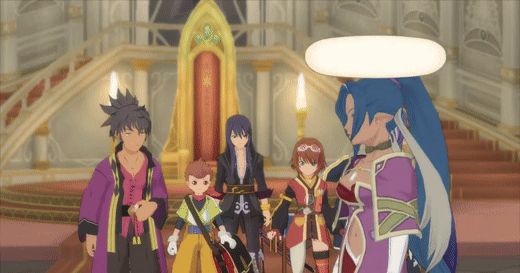
Khroma exhorts the party to stop “that one”—presumably, Duke.
Yuri, Alexei, and Duke alike all wield proper versions of the Dein Nomos symbol during Act 2, but they all suffer for having arrived at this principles of collective will through processes that did not involve groups of individuals define their own principles of actions and contributing those to a publicly chosen, common cause. Yuri and his friends spent this leg of the journey refining and understanding what it means to govern their individual actions by the collective laws of Brave Vesperia, holding the laws up as the abstractions by which they must conduct themselves, rather than a description of their coordinated, individual choices. Alexei deceives and manipulates the world into serving an ideal that’s only explicitly understood and endorsed by him, the megalomaniac who has enshrined his identity within that ideal. Duke, meanwhile, lurks in the background with a sword designed to preserve the legacy of the Children of the Full Moon who led the world following the sealing of the Adephagos, taking it up as the de facto sword of the Entelexeia, the community of aer krene guardians to whom Duke also remains an outsider, regardless of his friendship with the fallen Entelexeia, Elucifur.
Duke, as much as he might view himself as a guardian of nature and enemy of the human impact on Terca Lumireis, remains a human wielding a principle on behalf of a community without arriving at that principle in conjunction with the individuals of that community—his ideal is simply a different one, favoring the annihilation of humans where Alexei would have total authority over them. Arriving at his chosen path in large part as a reaction to his personal loss—the betrayal of Elucifur by humans following the Great War—he seems to be quietly, pitifully trying to convince other humans to understand and submit to his ideal based on their own experience, in contrast with Alexei’s iron fist—and in a similar way to Ilene and Baruk trying to show the party their ideologies through lived experience.
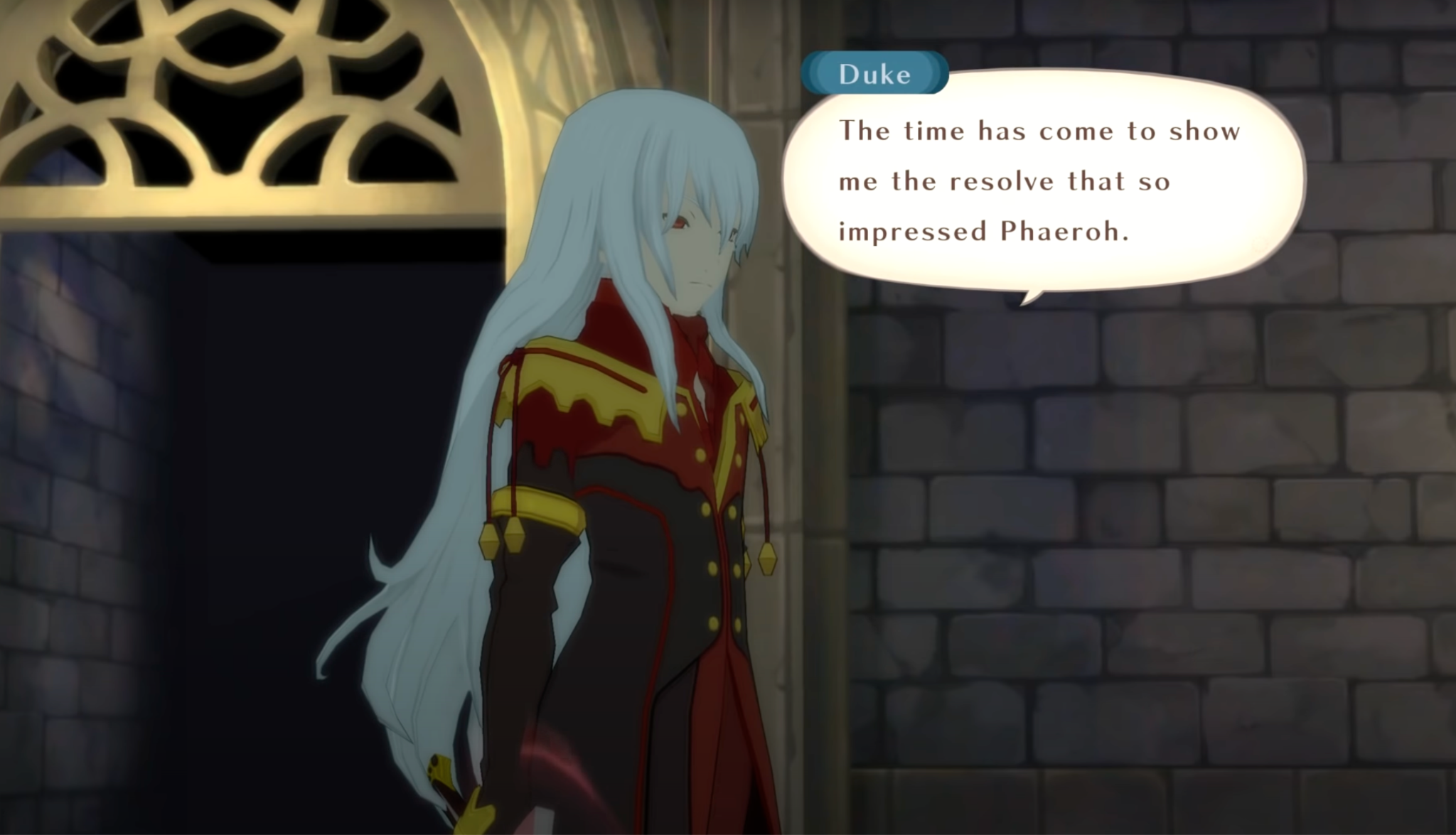
Duke directs the party to show him “the resolve that so impressed Phaeroh” before lending them Dein Nomos in Baction.
It’s not clear exactly what Duke intends by lending Yuri Dein Nomos following Yuri’s assertion of Brave Vesperia’s creed, but after the fall of Zaude, he will tell Yuri that it was because they “were the only ones who even attempted to communicate with the Entelexeia.” Duke isn’t the same kind of hyperbolically villainous puppet master that Kronos is, but I think we can read him as pulling strings in a similar way: Khroma, Duke’s Entelexeia partner, masquerades as a Krityan and acts as Alexei’s “personal assistant” throughout the story, through the events at Zaphias’ Sword Stair; later, Sylph will admit to the party that this was for the purposes of “keeping tabs on Alexei” for Duke. Like the chaos of Raven and Yeager’s identities, we can tell different stories about what Duke is after: the optimistic reading of him may be that he truly wonders whether the party can prevent Alexei from reviving Zaude and engaging the Adephagos, but I think the sadder, more realistic reading is that Duke sees no path according to which humans can rebalance the natural order without removing themselves from it—thus, to invite Yuri and his friends to challenge Alexei is to hope that they will come to understand that no human-directed ideology can save the world from the insipid poison of humanity—a realization that would, at least, cure Duke of the solitude he suffers in his own one-member “guild.”
It seems to be this sadly realistic outlook which Khroma invokes when she shows the party the way to Alexei atop the Sword Stair, cryptically saying, “I cannot know what that one saw in all of you… but I wish for you to stop him.” Understanding Khroma’s intimate relationship with Duke, I think we can read her most naturally as speaking about him, not Alexei—which is to say that, even before the Adephagos reemerges, she recognizes that Duke believes events can only end in humanity’s chaos and his “cure” in the form of Tarqaron. The final challenge for Brave Vesperia, therefore, is to fulfill Khroma’s wish: to move beyond their facility with binding others to their own ideals, and to instead use supportive platform of their community to awaken in others the will to link their actions with those of others, creating a future with a single community defined by no ideal beyond those that emerge as epiphenomena of the honest, public empowerment of diverse individuals.

Sodia stabs Yuri and leaves him to plummet from the pinnacle of Zaude at the end of Tales of Vesperia’s second act, with the shrine’s enormous blastia core collapsed on top of Alexei.
Two groups of heroes are now learning what it means, and what it takes, to hold the sword they’ve forged—a principle of will all their own—in their hands. The violation of their trust by the desires of others presents an unexpected gift, tempering their swords by showing how our inclinations can form commitments: commitments to their past, to their communities, to the context within which their capacity to act is embedded. For those who have only just discovered how to engage their desires and aggregate their agency with that of similar individuals, the question of the right way to hold one’s sword within that context for productive, forward-looking impact doesn’t invite an obvious answer, but portraits of those who have take up an inverted relationship with their swords—a disregarded past in favor of a predetermined, enervated present; a sacrifice of oneself for the sake of a community publicly determining its identity—reveal, in their opposite maxims, the path to charting a future based on ideals that emanate authentically from oneself and one’s community. These optimistic ideals can combat and conquer the pessimistic ideals of those who enslave individuals and communities—and, therefore, the entire present state of the world—in service of their own preferred notions of a future divorced from any past or present context. The progression from personal desire to beneficent idealism is crucial to developing one’s own principle of action, but it’s not the end of the story. The coordination of one’s actions according to the ideals of a group subordinates those actions to the context that formed the group in the first place: the context of the past; the context of the group’s collective narrative of its place in the world.
This isn’t a bad stance in which to bear your sword, but the stance alone won’t show you how to wield the sword according to your own, unique intentions. To learn the proper motions with your sword—the artes of your individual volition, if you like—you must fully study, honor, and commune with the heritage to which it belongs, both past and present. Only then can you and all other individual sword-wielders act together to chart an ordered future free from the chaos and histories of nature.
Act 3: Achieving Volition by Empowering Volition
To tell a new story for the world, the individual must use all of her intentions and abilities to tell the stories of everyone else in their proper contexts.
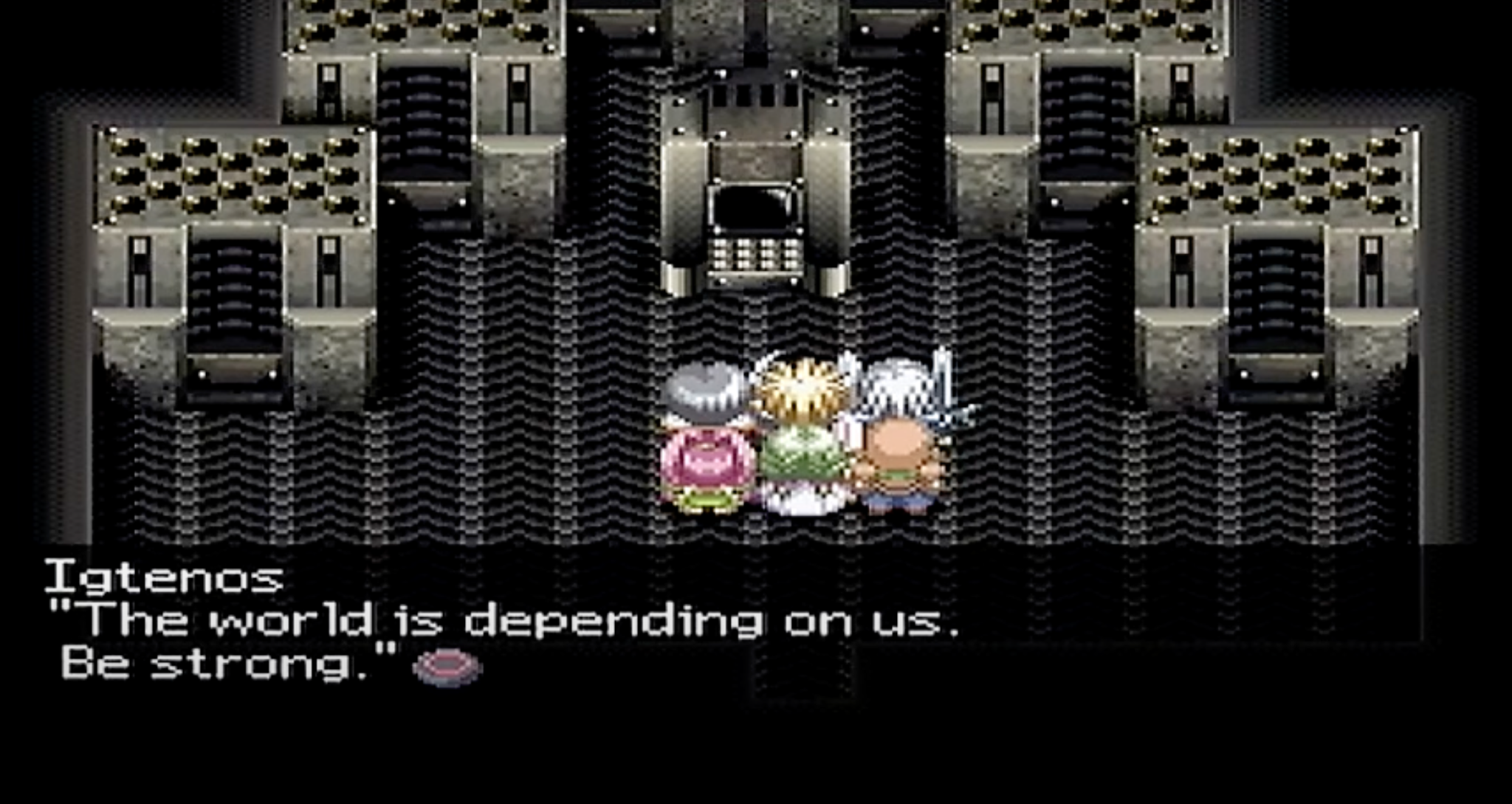
Igtenos calls on his fellow Swordians to steel themselves as their masters further temper them in the same forge that created them back in the era of the Aeth’er Wars.
Both Tales of Destiny and Tales of Vesperia carry the lion’s share of their developmental weight in their second acts: their first acts motivate the heroes out of inertia, and the second acts force them through the gauntlet of turning those desires into ideals that can govern the actions of a community. The third acts—relatively shorter, and focused on antagonists that don’t present an obvious extension of the sociopolitical issues that animated the villains of the first and second acts—run the risk of feeling orthogonal to the rest of the plot development, a kind of short story that extends the scope of the party’s journey with comparatively little thematic logic or continuity of personal growth. Seen through the lens of cultivating the individual and world’s capacity for free determination of their future, however, both of these third acts are vital and logical final steps: the difference between eternal recurrence and novelty in our own life stories; the difference between inescapable entropy and sustainable, global entelechy. Stahn and Dymlos may be wrestling with the depth of history’s reach while Brave Vesperia is grappling with the width of the present’s uncorrelated expanse of inexplicable interactions, but the answer is the same in both cases: to choose and shape a new future is to act of your own volition, and to free your volition from external fetters is to help others to actualize their own principles of will.
Tales of Destiny: Processing the Past for its Own Sake
True mastery of a tool from the past comes from learning how to let go of that tool.
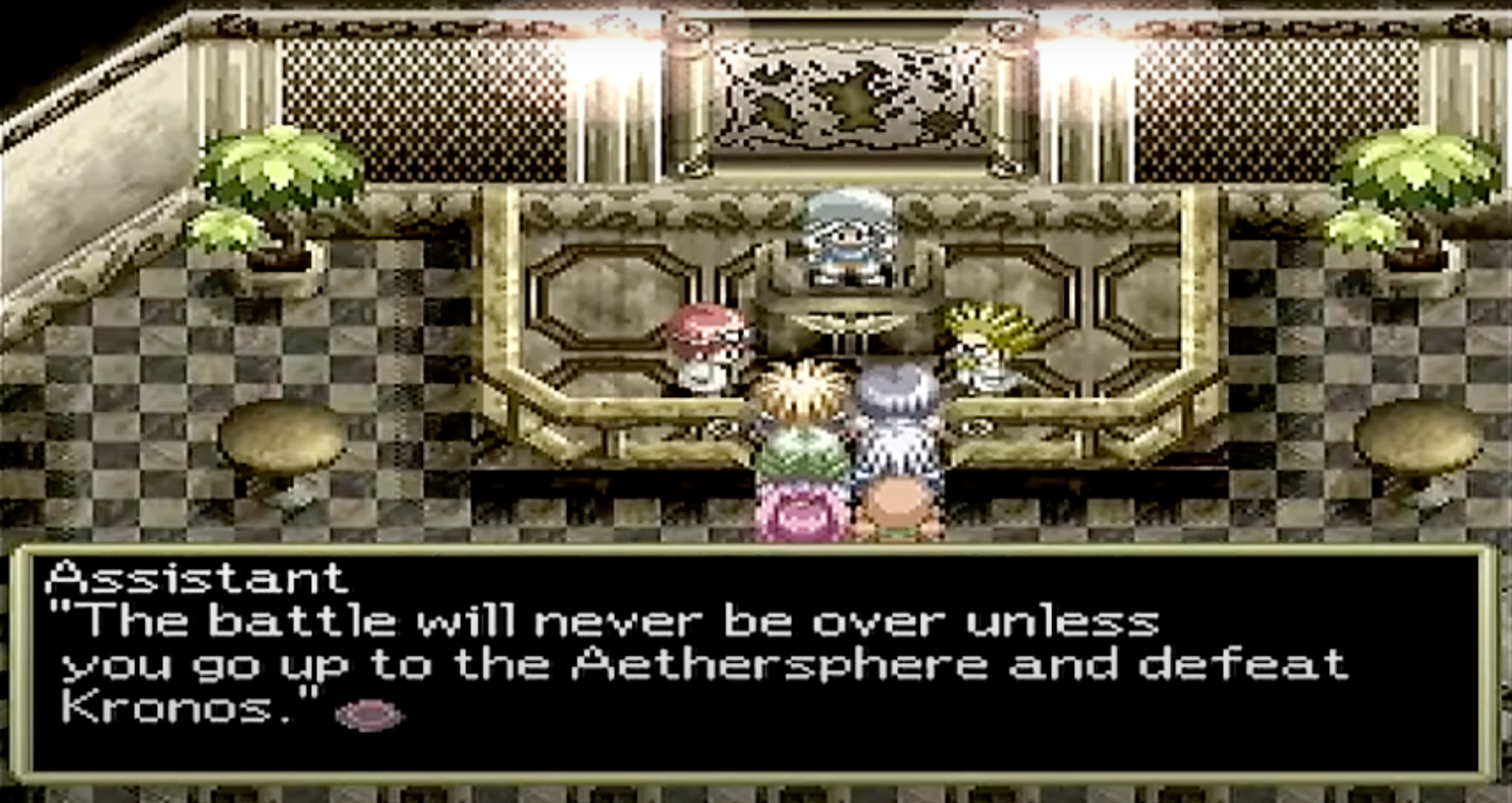
The assistant whom the party chose to help Raiker manage Radisrol calls on the masters and their Swordians to put an end to the conflict Kronos has clawed forward from the past into the present.
The advent of Kronos in the modern world lays bare for the party that truth which the ideals of Hugo had completely obfuscated: their journey, this moment in the world’s history, has recapitulated the events and motives of the Aeth’er Wars from the beginning. We see this not only in the archetypal tyrant of the Aetherian regime emerging from his disguise within the corpse of Berselius, but also in the ultimate nature of his plan: “draining the lifeforce out of this planet” in order “to resurrect the Aetherian people,” replacing the agents of the present with the static subjects of the past for the sake of a king who never relinquished his authority—who never allowed his war to come to an end.
The previous act saw the masters and their Swordians discovering and refining the ideals they wanted to enact in the world by better understanding their relationships with one another, especially the distinctions between their past and present. To bring about that future without reverting to the context of history, those in the present must complete two complementary objectives:
- They must relinquish their dependency on the past.
- They must impart to those artifacts of the past the agency to process and put to rest their own conflicts.
The first of these consists in recognizing that those same Lens that power the technologies of modern society and protect civilization from monsters undergird the international corporation that guided the history of the world, along with the ancient technologies and conflicts that created disparity and fueled war between the Er’thers and Aetherians 1000 years earlier. They are a power sourced from a foreign presence that disrupted the global ecosystem like a virus which the host never fully overcame, and the cause must be excised if its effects are ever to be overcome.
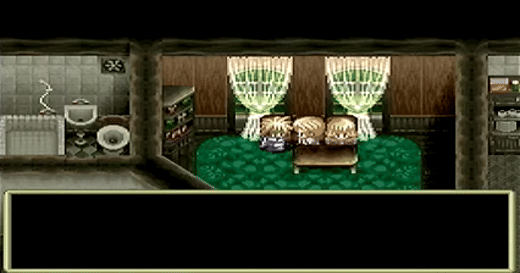
The wife of the mayor of Cresta implores him to give Stahn and his friends the Prototype Crystal “[t]o bring back our world.”
A long, long time ago, King Ravel, our country’s founding father, used a special Lens as a symbol in some cities. That Lens had so much energy, the monsters would be warded off by it. I believe the king wanted to protect the cities by placing them there. King Ravel probably never envisioned his Lens being used by our generation… We will have to use these Lens against the Aeropolis. We shall be doomed without them.
The 3 episodes of collecting these Prototype Crystals to power the Multiplexed Lens Cannon against the barrier protecting Kronos’ Aethersphere illustrates what it takes for the lawless, the capitalistic, and the governors to trust in an uncertain future rather than the preservation of a present literally overshadowed by an oppressive past.
- The lawless bandit who stole Armeida’s Prototype Crystal surrenders it after a show of force from the party when he tries to rob them.
- The capitalistic Walt trades Harmentz’s Prototype Crystal to Stahn with the expectation that the cachet conferred upon him by an act that helped to save the world would return his fortune to him several times over.
- The wife of Cresta’s mayor convinces him that, as much as he wants to protect his town from monsters, the best thing for the town is to bring back a world where they can “show the children”—including the orphans whom she threatened to de-home by backing the closure and demolition of the orphanage—”blue skies,” offering the heroes the town’s Prototype Crystal to clear the Aethersphere from view overhead.
All 3 groups willingly give up the objects of the past for the sake of their immediate concerns in the present—personal safety, finances, the next generation—spurred on by the expressions and actions of those masters who have completed the work necessary to identify and enact a course of action that settles the past rather than reverting to its legacy.
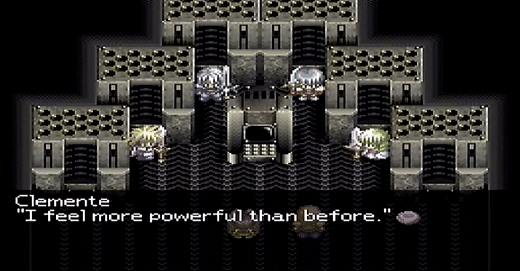
The masters and Swordians resolve to defeat Kronos once and for all after upgrading the Swordians in the reactor of the Swordian R&D Laboratory, the place of their birth.
Settling the past doesn’t just consist in distancing oneself from it, the fallacy of Hugo: one also needs to see the past vividly and contribute the appropriate vector of effort to process it on its own terms. The masters follow the lead of engineer Igtenos—the Swordian whom, not too long ago, they called back crippled unconsciousness—to strengthen the Swordians beyond their original forms. This upgrade doesn’t require accessing some newfound technology or esoteric magic, as it might in a different story: it merely and exactly requires going back to the forge that created the Swordians 1000 years earlier, a forge unwittingly reopened by that very ancient weapon they were tasked with stopping. This is the full realization of those in the present—called to their own agency by their Swordians’ skillful means—enhancing their weapons for the sake of fulfilling their weapon’s mission, which ought not to have anything to do with the masters yet cannot be put to rest in its proper context without their understanding and support.

Half of Tales of Destiny‘s main party of characters reflects on their own shared “destiny” on the night before the final assault on the Aethersphere.
The fully developed bond of understanding between Swordian and master allows the Swordians to finally articulate and accept, on the night before their final journey to the Aethersphere, that they are fulfilling their destiny, a use of “destiny” that accurately captures the sense in which these swords’ present actions are motivated by reasons that reach beyond present context, orienting them backward to their native moment 1000 years earlier.
No longer are the Swordians pawning off a contrived narrative of destiny on their users in order to spur them out of their inertia. Their users don’t need that anymore: their final heart-to-hearts before the assault on Kronos see them fully willing to express themselves and their desires relative to each other, without the support of their Swordians (even when Philia elects that some desires, like her sentiments for Stahn, are best expressed only to herself, much to Clemente’s chagrin). They look to the future in the way that only they can: not aspiring to divorce it from the past like Ilene, Baruk, and Hugo, but rather recognizing the past for what it is, doing what it takes to leave it there, and walk forward without shouldering it as the sword (or crutch) that will define their next chapter: Rutee thinks about “my past, the orphanage, my father, brother…” only to set it to the side and recognize simply that “it’s not the right time to get sentimental yet” because she and Stahn “still have a very important job to do”—a job she can face and undertake wholeheartedly because she’s done the work to understand her relationships with and distinctions from her past and family, valuing them yet not allowing herself to be fettered by them, as Leon was. Garr the King is already looking forward to “what needs to be done after the fighting is over” for a world that has been ravaged by Belcrant, the weapon of the past, yet is ready to move beyond it rather than recapitulating the systems of disparity and discrimination that bred a war’s history into its descendants.
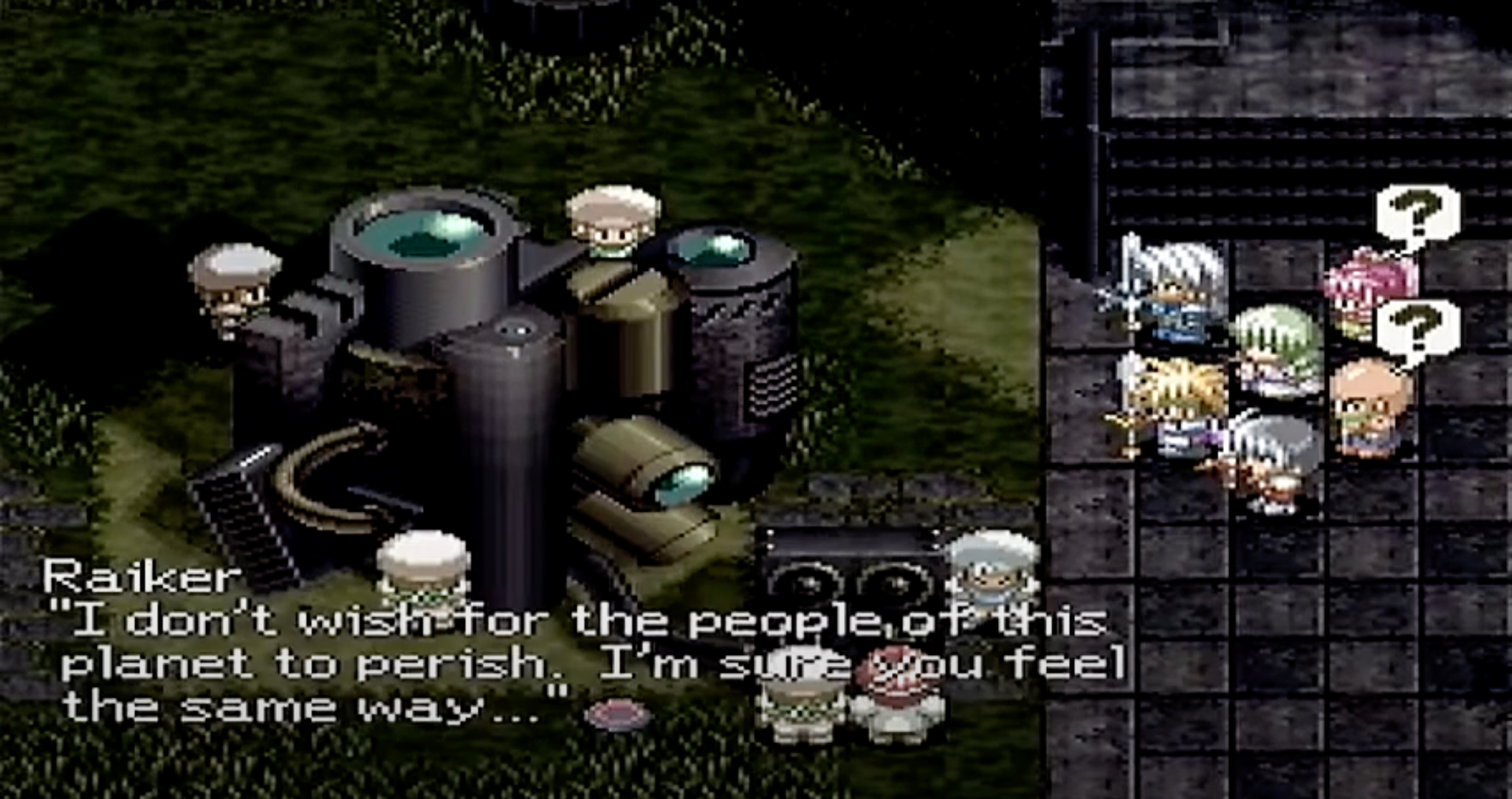
Raiker sacrifices himself, ordering Stahn and the rest of their forces to fire the Multiplexed Lens Cannon at the compromised Radisrol in order to open a path to the Aethersphere.
The resolve to process a community’s past—especially the past of a global community—is a contagious force of will, and Raiker takes this spirit into his digitized being in order to give the present-day world against the oppressive gravity of the past. Once Kronos finally shows his hand and openly expresses his influence, his Aethersphere seizes even Radisrol, the ancient Aeropolis base of the Er’thers, as another plate in the Aethersphere’s “armor” preventing access to it from the darkened, completely subsumed world below. Kronos is not interested in reenacting the past, but rather imprisoning the world, literally and figuratively, within his kingdom from the rest, and seizes one of the Er’thers’ primary means of mobility—Radisrol and its anti-grav elevator—to bury present-day lifeforms and ancient heroes alike within his own elevated kingdom, dominating existence en toto.
From up above in bondage, Raiker sees the coordinated wills of present-day citizens and ancient Swordians giving up the past in order to give the present a chance, and he offers them the only path to release the future from the grip of the Aeth’er Wars: the destruction of the ancient heroes’ base, the only place unshielded by Kronos, to open a path into the Aethersphere. Kronos—the perfected image of a deterministic, domineering past made manifest—only knows how to use those objects of the past, from the Eye of Atamoni to the Swordians to Aeropolises, to enact his worldview. Working together, the heroes of past and present can achieve that which Kronos cannot conceive: willingly sacrificing the positive elements of the past, with the consent of those elements, in order to make space for the principles of action that belong to the present. Where Hugo would have mindlessly destroyed the past only to unwittingly reenact it, Stahn and his friends have come to sufficiently understand and revere the past to find the correct, beneficent, step-wise process by which they can unravel history’s hold on their own lives.
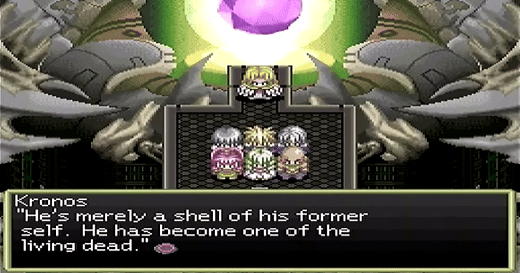
The party saves a hollow, reanimated, puppet version of Leon from a vengeful, sadistic Kronos.
By the time the masters and Swordians penetrate the Aethersphere on the backs of the present-day citizens and past heroes’ sacrifices, their defeat of Kronos is a foregone conclusion. For all his puppetting of Hugo—and, by extension, Lydon—Kronos shows his ignorance by bookending the game, true to his name, with another kind of toxic timelessness, that special myopia we witnessed in Lydon. Whereas Lydon’s zealotry made the question of relationships between past, present, and future irrelevant, Kronos recognizes the distinction between agents in different times yet sees himself as the rightful, changeless ruler of an empire that ought to persist across all time, with all other individuals equally apt objects to be manipulated in service of that empire (even the resurrected Aetherians are objects in service of his dominance, for “What is a king without his subjects to rule over?”).
Seen in the distorted light of Kronos’ doctrine of temporally fungible puppets, the notion of heroes who honor and support the wills of each other in their proper, distinct context is not only incomprehensible, but even sacrilegious—the reason, perhaps, why Lydon’s religious followers, Hugo’s employees, and Kronos himself all separately refer to these networked agents in the party as “infidels” across the course of the story. Kronos tries to disarm and disorient Stahn and Dymlos with mazes of mirrors that force them to battle a “reflection” of themselves in Dycroft, but these singular enemies only reveal Kronos’ misunderstanding that there are two heroes working together across distinct temporal contexts in this final sequence of the game, their mutually supportive wills easily dismantling the literal illusions of their reflection and the symbolic illusion of Kronos’ authority over the present. Kronos tries to break the party’s spirit with a sick, broken puppet of Leon’s reanimated corpse, but these “infidels” have learned that perspective to which Kronos is essentially antithetical: Leon belongs in the past, honored as a memory, and that the greatest gesture they can offer him is to stop him from being dredged back into the present.
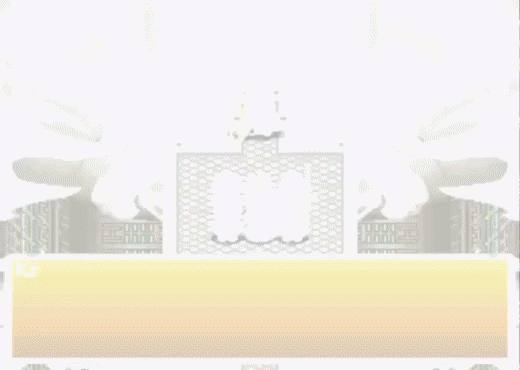
Kronos, absorbing the energy of the Eye of Atamoni with no willingness to distinguish any context from his own dominion, corrupts his own physical form, becoming Ultra Kronos.
Kronos, unable to see sentient beings as agents with intentions rather than as tools for his own designs, claims that “There is not much difference between [the Eye of Atamoni] and the Swordians that were developed by the Er’thers”—and his form is consequently disfigured by the power from that Eye of Atamoni, that history which he cannot see clearly constrained within its own context. The masters, who see their tools as agents with their own intentions that must be honored in the context that forged them, are able to purify themselves of the past—allowing their Swordians, their friends, to fulfill their destiny, and to buy their own freedom in the bargain. That same respect for distinction of context which allowed Stahn and Dymlos to overcome their reductive reflection in Kronos’ mirrors now empowers the heroes to dissociate Ultra Kronos back into the Eye of Atamoni and a defeated Kronos in his ordinary, Aetherian form: unlike Kronos, the Swordians understand that the Eye of Atamoni is an energy source which must be confronted, processed, and overcome as an artifact of the past, annihilated by other, resonant artifacts of that same past—not claimed by a tyrant outside of his own time as a warped proof of his right to rule every time, to reshape every context and energy source into a justification for himself.
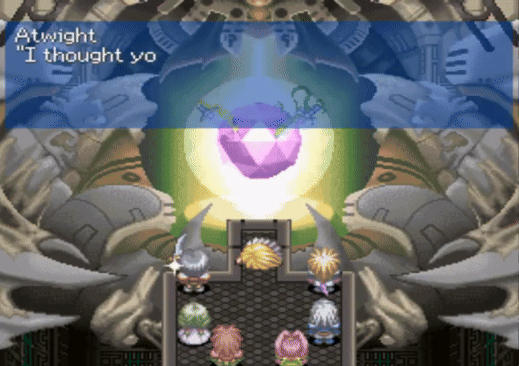
Atwight expresses her bond to Rutee and her mother at the moment of their goodbye.
At the last, the Swordians—these weapons that empowered the agency of their masters—are ready to go, putting the past to rest by sacrificing themselves to destroy the Eye of Atamoni, not just saving the surface from destruction but also saving it from the persistent influence of their own story. And in this conclusive moment, Tales of Destiny makes clear that this individual freedom, this definition and enactment of one’s principle of will, is only possible because of a relationship of understanding between sword and wielder: there is the will of the Swordian, the will of the master, and the dialogue between them, which reduces to neither and empowers both. After all that Atwight and Rutee have experienced together—the growth from manipulation of others to support of others’ own instrumental ends; the discovery of the inverse relationship between Leon and Chaltier, and the bondage of Rutee’s brother, Emilio; the confession of Atwight’s original mission, and the ideals according to which Rutee distinguished her own desired future from those of Baruk; the opportunity to honor Rutee’s own father in a context he deserved, yet was robbed off—Atwight, finally, expresses that she had another mission: protecting Rutee at the behest of her mother, a special bond between tool and user that only their empowerment of each other, in their proper context, made possible.
These connections—those which only emerge from the act of consigning the Swordians to history once and for all, kicking down the ladder by which one arrived at one’s present intentions—are the climax’s centerpiece and the reward for laying Kronos and the Aeth’er Wars to rest, a focus shown through the moving surprise of each duo of Swordian and master speaking and saying goodbye to each other, rather than a group-wide conversation of the kind we’d see in many other JRPG conclusions. As Dymlos tells Stahn, what the Swordians couched as “destiny” at the start of the story was really just a resonance between an intentional tool and a person with “the power to truly understand” others—to literally and figuratively hear the Swordians because they could attend to and honor the Swordians’ wills by cultivating and enacting wills of their own.
The gift of the Swordians, this half of the individual volition which Tales of Destiny and Tales of Vesperia cultivate, is the path to shaping courses of action that honor your personal desires by personally engaging with the past—while maintaining the presence of self to honor both that past and your own path to the future. Their gift is giving their users the self-awareness and communal support to speak and act like Stahn at the very end of the game, when the journey is over and the credits have finished: to gather with friends, with no sense of destiny, to honor the sacrifices of those in the past and build a future that does not essentially refer to those agents of the past.
To express gratitude, and then say to friends, to masters and ordinary people alike: “Anyway, why don’t you come inside?”
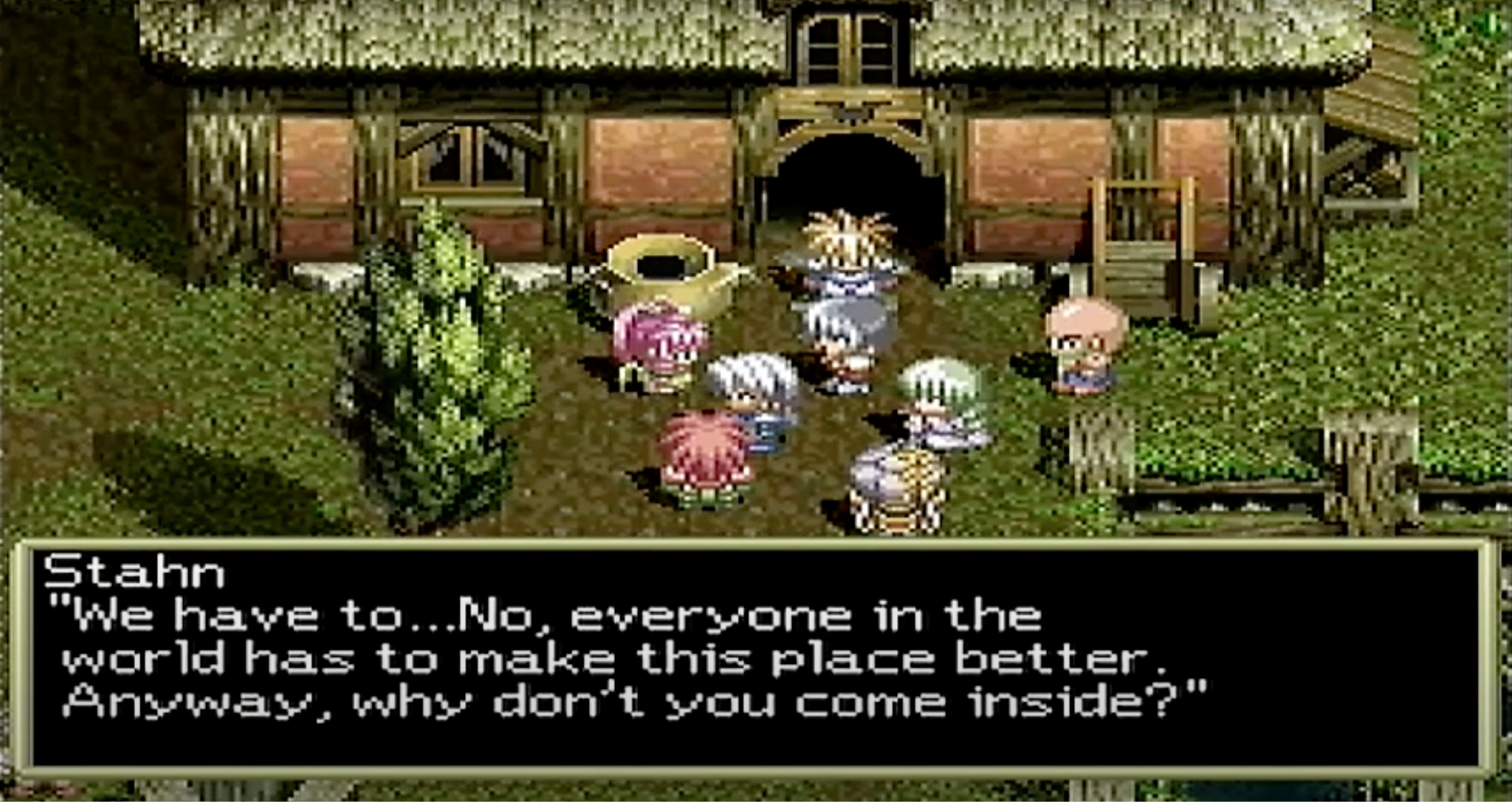
One year following the Swordians’ sacrifice, Stahn and his friends chart a future free of the past.
Tales of Vesperia: Telling the World’s Story through Personal Narrative
When you show every person in the world how to contribute to the forging of a sword with their own hands, you lay the foundation for a full armory with which to chart a new future.
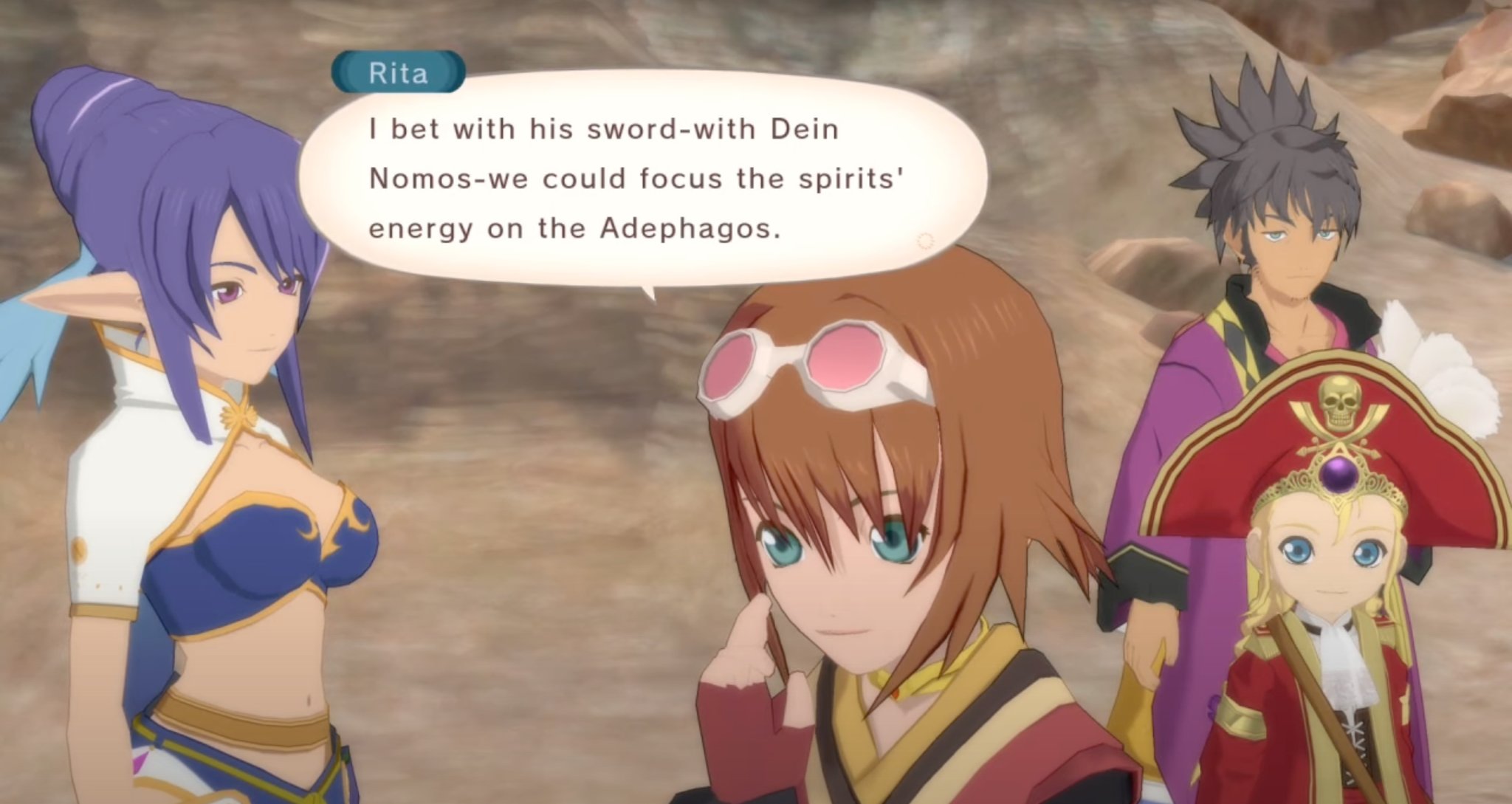
Following the reincarnation of Entelexeia Belius, Phaeroh, and Gusios into spirits Undine, Efreet, and Gnome, Rita takes the party’s ideological friction with Duke at Relewiese as inspiration for fashioning a “Dein Nomos” as an instrument of Brave Vesperia’s chosen future against the Adephagos.
The dual pillars of (1) the Adephagos’ reemergence and (2) Sodia’s attempt on Yuri’s life set a clear challenge before the party and all denizens of Terca Lumireis at the end of Tales of Vesperia‘s second act: humans must find a way to mindfully order their own activities if they wish to avoid swallowing their world and themselves in senseless chaos [1], and to achieve this sustainably, they must do so in a way that derives ideals and communal intentions from the autonomy of individuals, rather than governing and limiting individuals according to preordained ideals [2].
This challenge is of a different kind than the threat of Kronos and the Lens in Tales of Destiny: the influence of the past on Stahn and his friends’ present-day world was a foreign incursion, and so the heroes could overcome it by excising that foreign influence, “metabolizing” the comet and its derivatives to return the world and its people to a self-deterministic, natural state. But the problem with Terca Lumireis is its natural state: there are all the irreducibly chaotic motive forces of aer, individuals, and interactions that animate and constitute the world, and no way to reach beyond it—no way to distinguish the “problem energy” from those aspects of the world which one wants to save. The only path forward, therefore, is to reconfigure the world itself by reconceiving of your and others’ place within it, beginning by empowering the arbiters of the global ecosystem with a new principle of individuation and propagating outward to coordinate the entire network of global societies.
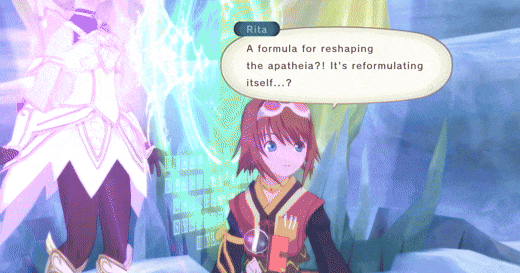
The party’s collective channeling of mana into Belius’ apatheia gives birth to Undine, a new entity with a self-concept and agency all her own.
Though Rita began the story more interested in blastia than other people, the young genius mage is the ideal candidate to synthesize from her personal journey a blueprint for more coordinated and productive energy system on which to base the organic and synthetic worlds:
- She sees the man-made technology of blastia as individuals with personalities meriting humane treatment even before she bonds with humans.
- She comes to cherish and support Estelle as someone with a power she doesn’t understand—which she initially sees as a clue to the Rizomata Formula, motivated by her intellectual and professional curiosity in achieving “the ultimate goal of current magical research by mages all around the world” by discovering the theory to “freely manipulate the essential mechanisms of aer,” and which ultimately helps her to unlock the Rizomata Formula as a way of saving her friend from a power that disrupts and threatens to consume her lifeforce.
- She studies and learns from Zaude as a protective technology that was fueled by, and expressed the protective will of, Children of the Full Moon like Estelle rather than aer, like other blastia.
- She learns from Judith and the other Kritya of the “ensouled” nature of apatheia and witnesses that consciousness within an apatheia “will[ing] the aer back to normal” with the help of Dein Nomos inside Heracles.
- She draws the connection between ice and condensed aer at the Blade Drifts of Zopheir after Karol condenses his own principle of will in the face of a monster who preys on those overwhelmed by aersickness.
Rita does not wield a symbolic Dein Nomos like Yuri or Duke, but her own mode of engagement with the world—a scientific curiosity complemented by her fascination with, and investment in, a girl who reconfigures her understanding of science—gives her a unique perspective from which to adjudicate the developmental trajectory of the party with the structure of the natural world and humanity’s capacity to influence it. The puzzle seeded for Rita at the climax of Act 2 is how to square her own ideology—the ability of her scientific knowledge to protect the life of her friend through a control formula that limits her impact on the aer, so long as she doesn’t use her powers—with the desires and autonomy of the object of her ideology—Estelle, who does not want to be controlled and limited but rather empowered to travel with, and support, her friends, even if that wears on her lifeforce. Her solution is to square her own desires with the group’s principles and place in the world by trusting and supporting Estelle through the conduit of the party: combining the beneficent intentions of Estelle, whose true “power” Belius interpreted as “kindness,” with the soul and energetic conduit of Belius’ “soul” itself, and binding the party to Estelle with the same life-draining formula of Zaude to achieve the opposite outcome of Zaude, the developmental progression that allows the party to ultimately create and wield their own “Dein Nomos”: the acknowledgement, naming, and support of a new, intentional, energetic principle in Terca Lumireis, rather than the suppression of an energetic force which we witnessed in the erasure of Zaude, or the erasure of individual intentions in favor of group ideals.
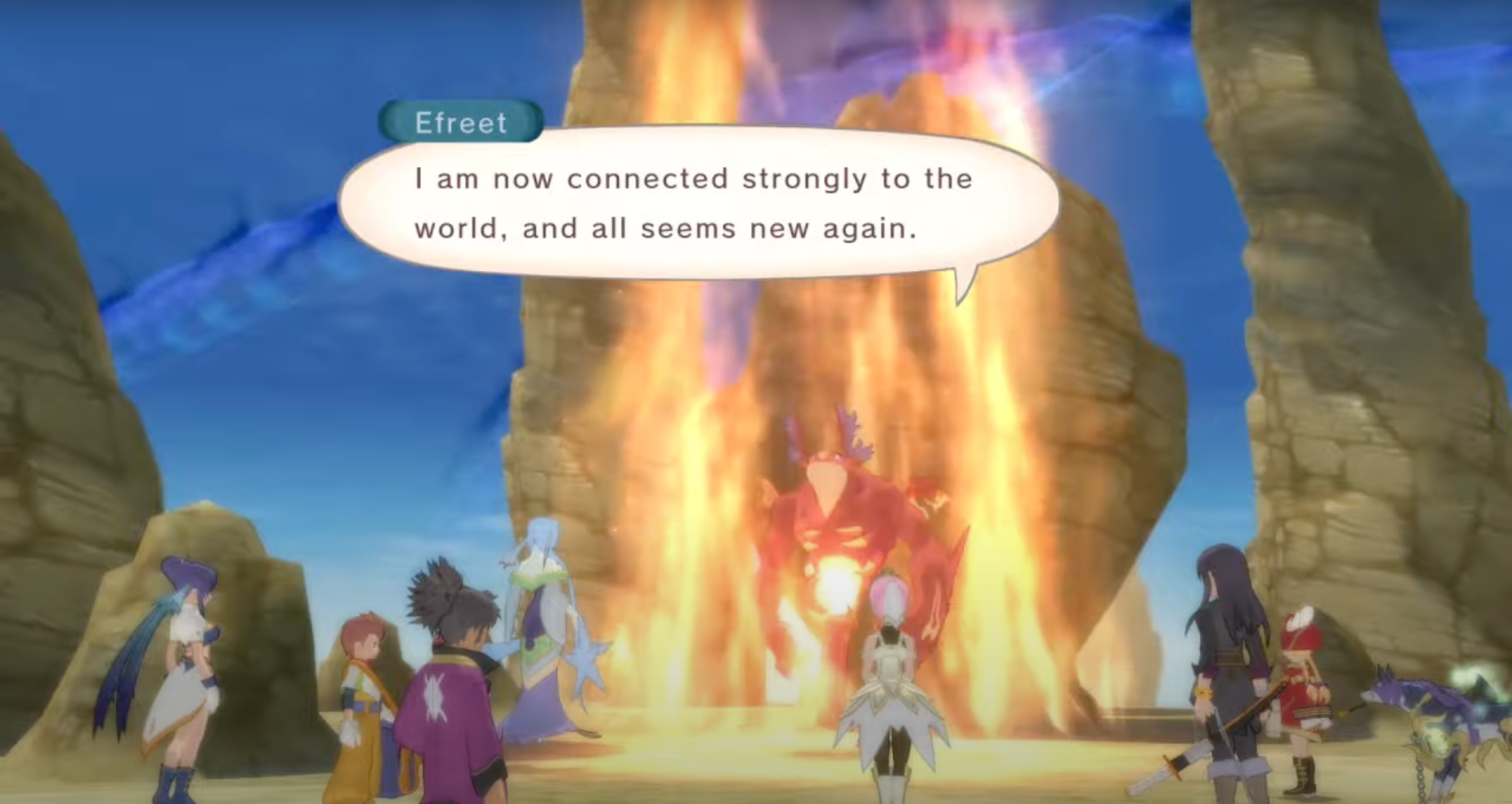
Phaeroh, reborn and renamed as Efreet through spirit conversion, celebrates the new form of life which he now inhabits thanks to Brave Vesperia’s efforts.
When the death of Belius exposed the chaos of conflicting desires and unstable group identities to the party in Act 2, we identified her apatheia as a symbol of (1) the failures to marshal the world’s chaos and (2) the misunderstanding of those who try to use those failures as conduits for their own agency, only further exacerbating Terca Lumireis’ entropy in the process. This symbolism is borne out in the apatheia and spirit conversion of Phaeroh, Gusios, and Khroma as well: Phaeroh tried to mitigate the excess aer that was a byproduct of Alexei’s idealistic ambitions, drawing attention from the group to give them a chance to stop the Commandant; Gusios risked becoming a part of the Adephagos from aer over-absorption when trying to quiet the Erealumen Crystallands’ aer krene and deter the vindictive rage of the Hunting Blades; Khroma—the daughter of Elucifur, Duke’s closest friend and fallen ally—struggles to make sense of the chaos of her contradictory feelings of human family and love uncommon to Entelexeia, following and obeying Duke’s orders even while quietly wishing that the party can find a way to save him from himself.
Once the full picture of the world’s innate lifecycle is revealed—its surface overshadowed not by a totalitarian regime from the past (the Aethersphere), but rather by the organic byproduct of disorganized attempts at societal advancement (the Adephagos)—it becomes evident to Rita that the answer she has been seeking to both her principled, scientific exploits and her interpersonal efforts to help Estelle doesn’t lie in an ideology that depends on the current state of the world—like Alexei’s elaborate system of apatheia, a puppetted and disenfranchised Estelle as its centerpiece—but rather in an ideology that allows the constituents of the current world order to chart their own future, making a new world rather than governing the existing one. As Rita says following Phaeroh’s reincarnation into Efreet, “[i]magine if a fish became a bird”: the Entelexeia moves on from being (in Yuri’s words) “some sage, always worrying about the world” to (in Efreet’s words) becoming “connected strongly to the world,” so vividly and directly that “all seems new again.” Those who were previously limited to acting as the guardians of a world in which ecological outcomes and their personal transfigurations (into apatheia; into Adephagos) were beyond their control now have the standing to directly channel that world’s energy rather than merely absorbing its excess; what was reactive and misapprehended by humans as monstrous is now active, a kind of volitional monad whose self-directed activities make the individual freedom of all intelligent life metaphysically possible.
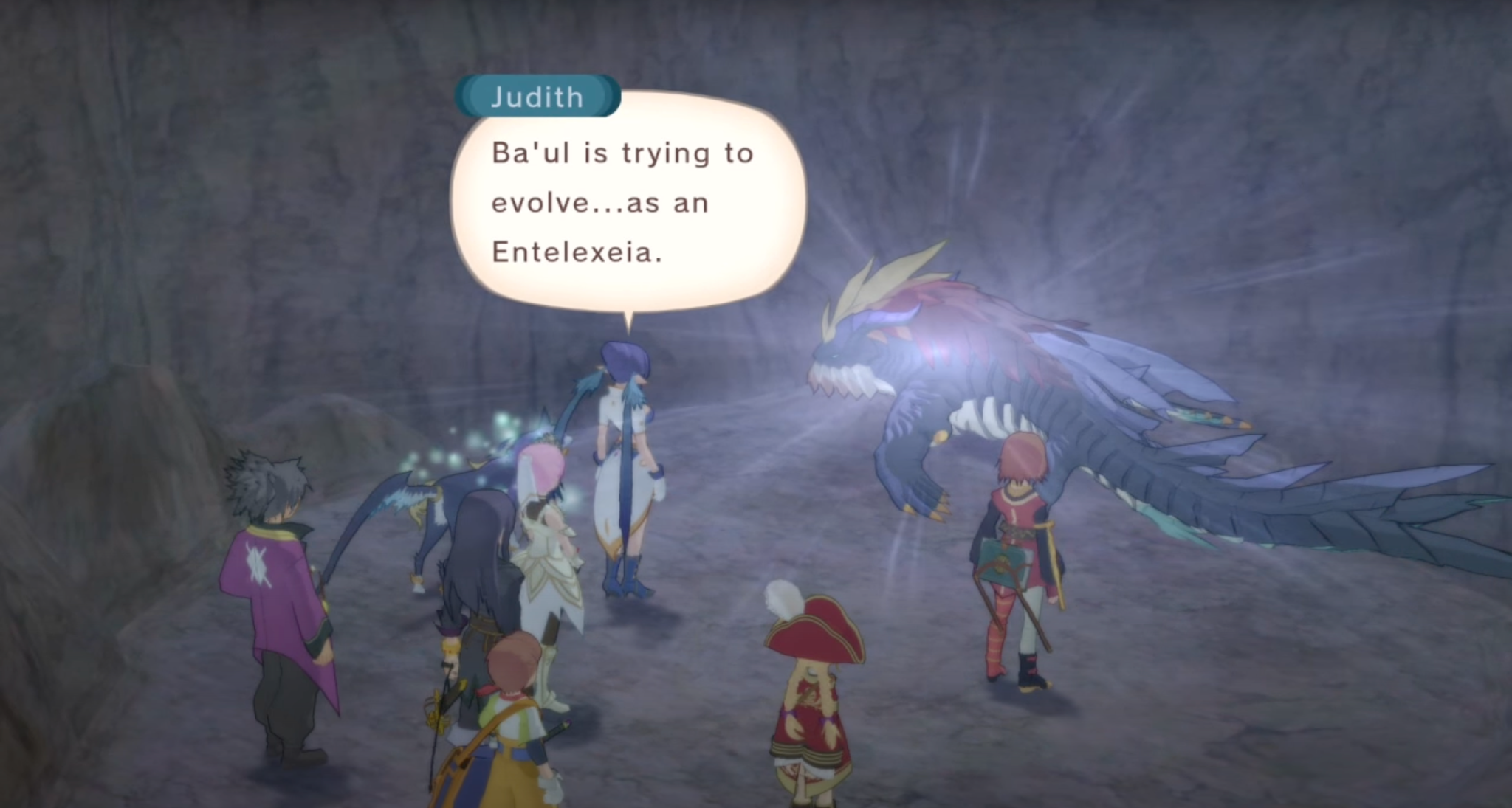
After saving Judith and Ba’ul from the Hunting Blades on Mount Temza in Act 2 of Tales of Vesperia, the party joins Judith in holding vigil while Ba’ul evolves “as an Entelexeia.”
The one constant for Entelexeia across the course of Tales of Vesperia and Terca Lumireis’ history is change: they embody the spirit of their namesake, the Greek term entelecheia, introduced by Aristotle in distinguishing between the material substance from the principle according to which it individually actualizes its potential—the soul that governs a living being’s development. Key for our purposes is the fact that this developmental trajectory changes based on the relation in which Entelexeia stand to those around them. Ignored in the uncoordinated advancement of human desires, they find themselves reshaped by excess aer into Adephagos, a mindless directive to consume all sources of aer imbalance gluttonously (‘adephagos’, or ‘ἀδηφάγος’, is Greek for ‘glutton’); supported by the humans with whom they have chosen to coexist, they evolve to better serve the ideals of those communities (as Ba’ul functionally evolves from a single-rider steed into a virtual airship with Brave Vesperia’s support—and, presumably, as Elucifur refined his own purpose in fighting alongside humans for the sake of his friend, Duke, and their shared cause); but by imbuing the evidence of an Entelexeia’s duty served, its apatheia, with the trust and directed life force of one who can freely manipulate aer and her friends, humans can reincarnate these guardians into spirits who have achieved the namesake state of apatheia, the Stoic term for the clarity of self-governed, dispassionate action toward the ethical ends of a being, its entelechy.
If an Entelexeia’s role in the world’s existing order was embedded in the chaotic impulse and effects of aer, then the final insight of Rita’s journey is to free them from that context with a new kind of energy that bears a new symbolism: mana, which is “closer to matter [and therefore more stable] than aer”—like ice, the lesson of Karol’s act of bravery during their first visit to Zopheir—but still “less stable than actual matter”; it is a kind of energetic potential with the order which aer lacks. That it is less stable than matter entails that it needs a core through which to channel itself, a condition which the party satisfies by using their own life energy, along with Estelle, to channel mana into the apatheia of Belius, transforming a symbol of failed attempts at controlling chaos and being controlled by other individuals into a symbol of making someone’s unique will possible by investing the collective attention and energy of a group in that individual. This act of effortfully, selflessly channelling the more substantive and directed mana into Belius’ apatheia (an act which requires Estelle to “understand the flow of the aer” in order to recompose it into mana, a mitigation of chaos which the life energy of her consenting friends makes possible) is precisely, on the level of both plot and symbology, what allows the apatheia, in Rita’s words, to “gain a will of its own.” This act depends on “the will of Belius trapped in the apatheia”—the recognition that there was an individual there who had yet to be fully recognized and empowered as such—yet it is a generative and creative act, “grant[ing] life,” in the yet-unnamed spirit’s words, to someone who is “no longer Belius the Entelexeia.” As Yuri says, Undine is “a being that controls the essence of a material”: an individual that can actively channel energy in the world rather than reacting to uncoordinated energy in its midst, according to the will of its own, which other individuals made personal sacrifices to conceive of, attend to, and actualize from within the latent and lost Belius.
The story of spirit conversion, then, is a microcosm of and cipher to the final stage of developing Dein Nomos as a principle of volition: reversing the dynamic according to which an individual (the Entelexeia) feels obligated to filter through the chaos of everyone around it, instead uniting everyone else around the common goal of empowering the individual’s innate perspective on, and contribution to, their world (spirit conversion).
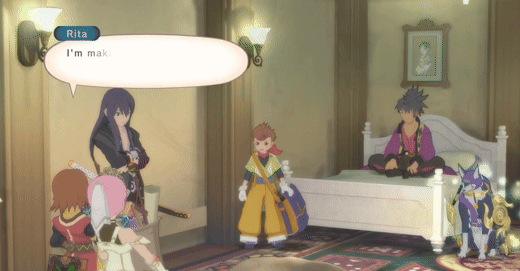
Rita develops the party’s first home-grown Dein Nomos in Capua Nor, channeling spirit energy rather than manipulating aer.
What might initially seem like a “summon spirit ex machina” to Tales veterans is the natural conclusion to the story of heroes who began by running away from things they didn’t want, found stability by holding each other publicly accountable to principles and narratives of their place in the world, and now, finally, have the awareness of self and community to turn that praxis of narrative accountability outward to other individuals, empowering them to tell their own stories rather than fleeing from the wrong stories or confining themselves to externally dictated group dynamics. Moving from the insulated libraries of Zaphias Castle to the practical storytelling of a world traveler, Estelle gives the four spirits new names inspired by the “ancient word[s]” ascribed to rulers of their respective elements, but she only does this because they ask for new names. This is the precise representation of the consensual individual empowerment that was missing from the ideologies of Alexei, Duke, and even Brave Vesperia in Act 2: giving individuals the canvas and language with which to write their own stories when they are ready, willing, and able to do so. Duke’s insistence that he “[has] aligned [him]self with the Entelexeia” and feels “the true weight of the burden borne by the Entelexeia” through Dein Nomos rapidly becomes a hollow claim as the Entelexeia evolve, showing the difference between the party’s “Dein Nomos,” “Brave Vesperias No. 1 and No. 2,” and his own: where Duke is clinging to the ideology of a community that no longer exists, Brave Vesperia has synthesized a new sword, a new principle of action, out of the powers of individuals who have been authentically actualized on their own terms.
The latter of these, a “Dein Nomos” synthesized through empowerment of individuals without ideological agenda, is another contagious force of will, like the masters and Swordians’ resolve to process their communities’ pasts. It’s no coincidence that the first of Rita’s spirit-powered Dein Nomos tools, Brave Vesperia No. 1 (which, in light of what we’ve said, probably could have been named “Rita Dein Nomos” without much risk of inaccuracy), disperses the massive, irrational heard of monsters incited from the absence of Entelexeia Astal’s governing influence, paving the way for a unique community where guilds, Knights, merchants, the empire, and countless individuals come together to support each other in an irreducibly diverse network: “The Land of Hope, Aurnion.”
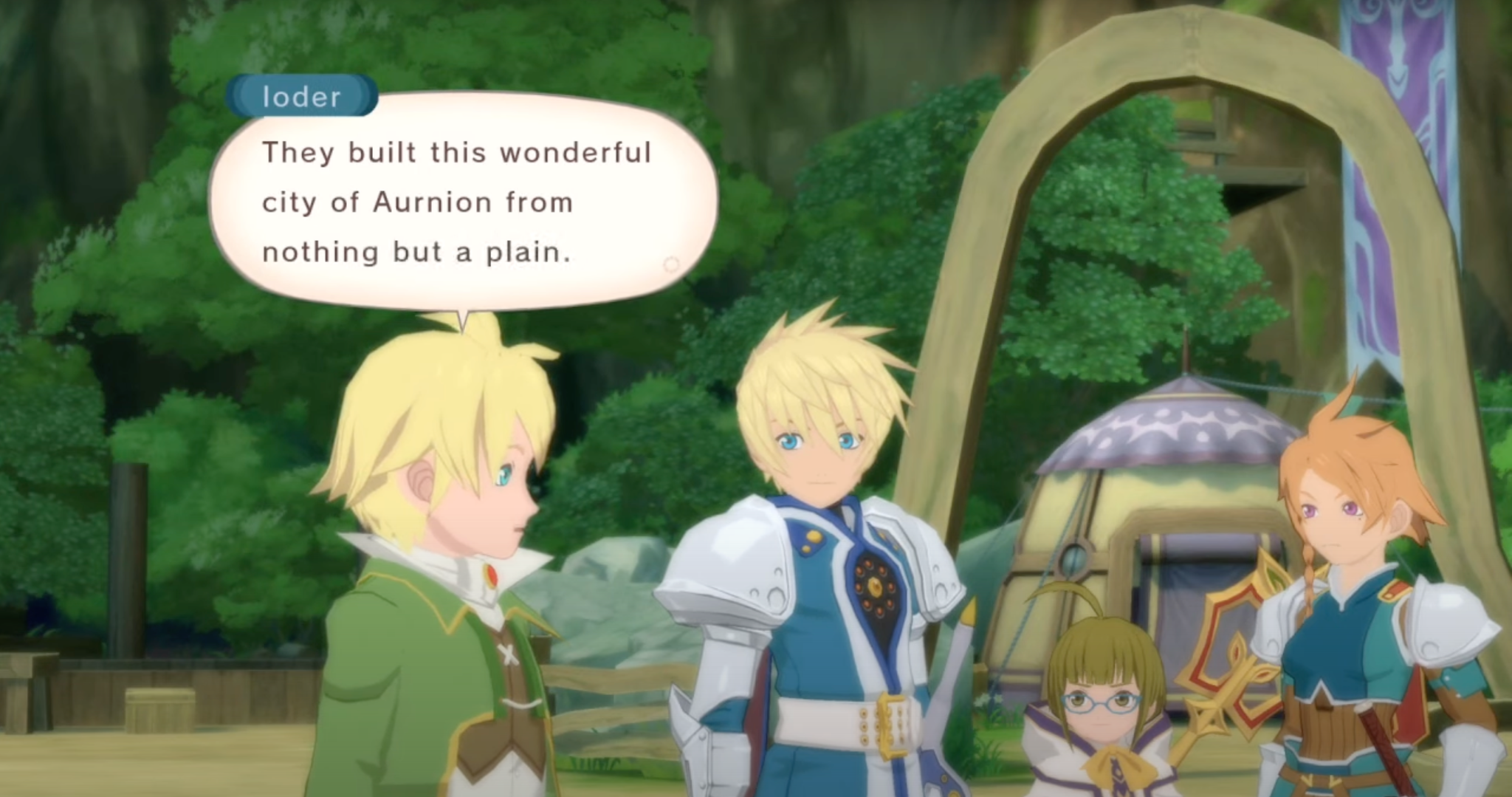
Imperial Prince Ioder expresses confidence that the diverse community that came together to found Aurnion will also be among the first to accept life without blastia.
The new town of refugees and members of guilds and the empire alike is a global nexus for the bottom-up community made possible by Brave Vesperia’s Dein Nomos, bearing witness to the stories and interests of particular characters to arrive at a sustainable course of action for the future. Rather than traveling to specific villages and convincing them to surrender their technology based on their present-day needs, as the masters and Swordians do in Tales of Destiny‘s third act, Brave Vesperia ferries representatives of the Union, Nordopolica, and the empire to the neutral territory of a town younger than, and ungoverned by the influence of, all of them, facilitating a summit in which they all can jointly develop and agree upon a plan to offer their blastia up to the spirit conversion process for the sake a new world order without the Adephagos. This new community is the ideal context for all groups across Terca Lumireis to commit to networking their blastia together, on the back of Alexei’s own research, for the sake of spirit conversion: where Alexei would have imposed his world order by force through blastia and only exacerbated the Adephagos, Brave Vesperia shows diverse groups worldwide how to willingly offer their energy to Brave Vesperia’s Dein Nomos, coordinating the world’s future through a network that allows them to convert the chaos of the Adephagos itself into countless points of individually actualized will—the spirits that will redefine the foundational energies of existence.
Aurnion, this new bastion made possible by the party’s growth, is the setting for their final reflections before facing Duke to pit the collective principle of Brave Vesperia No. 2—identical with the principle of Aurnion—against the solitary will of Dein Nomos. Aurnion’s inn, Canopus, is the setting for a pensive, optional conversation between Undine, Efreet, Gnome, and Sylph, mirroring in form and content the conversation between the Swordians on the eve of their final assault on the Aeropolis.
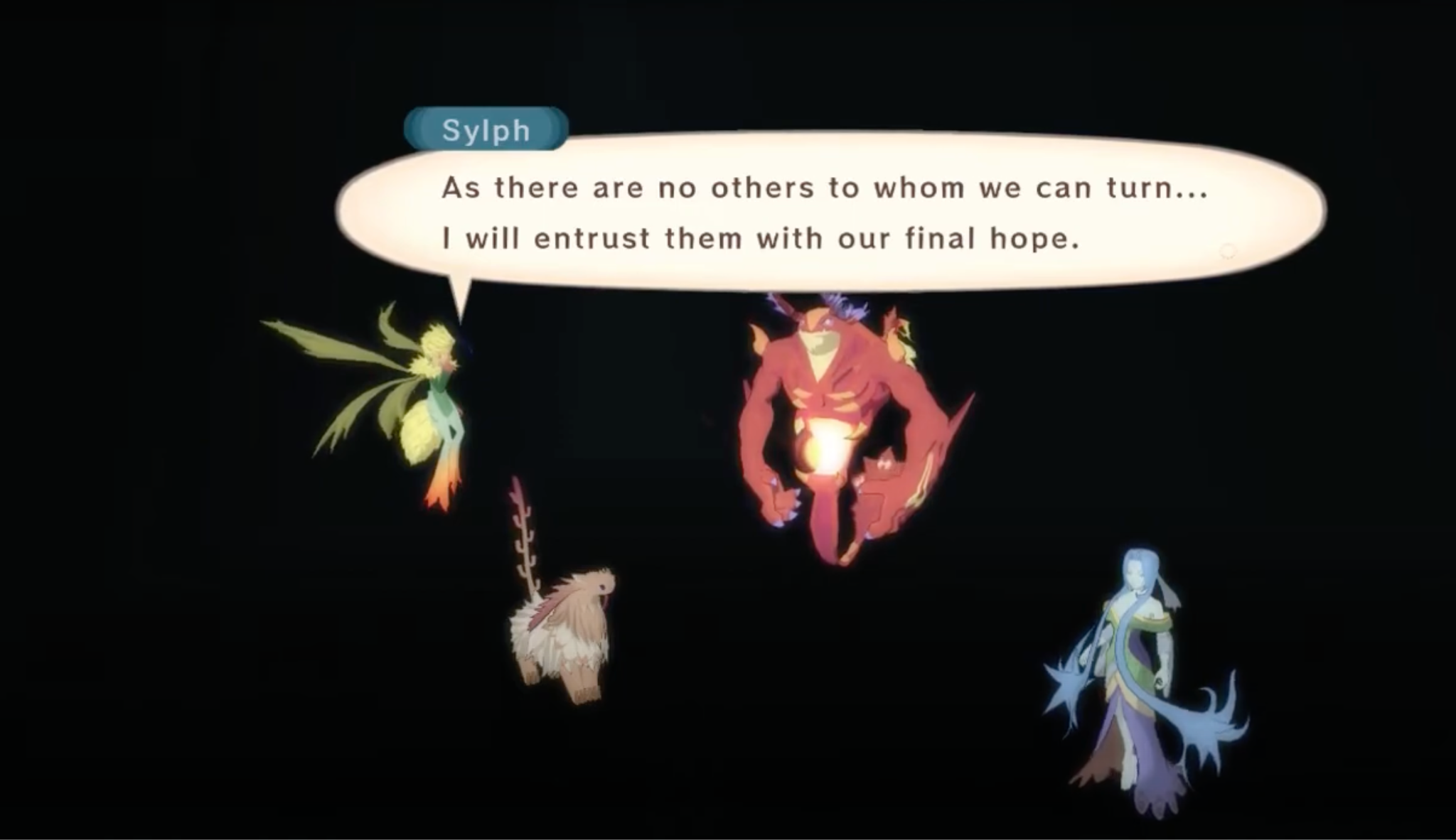
The four spirits reflect on themselves, the fragility and tenacity of humans, and their own motivation to struggle for a new future while the party sleeps in Aurnion’s inn.
Like the final reflections of the Swordians, this final conversation represents a group of entities who must trust in the humans (and dog) of the party to see through their own principles of action which they wish to impose upon the world. Unlike the mandatory final reflections of the Swordians, this final conversation must be optional: the climax of Tales of Destiny foregrounds its historical heroes for the sake of exorcizing the past’s influence, whereas the climax of Tales of Vesperia looks to the possibility of a new future by supporting all particulars of the universe in finding their own path and forging their own communities. The sharply differentiated personalities of the spirits (the distrustful Sylph, the haughty Efreet, the beneficent Undine, the meditative Gnome) don’t reduce to a homogeneous group identity, and while their group is necessary to Brave Vesperia’s success, it is only properly supportive to them by being differentiated from them: the spirits’ conversation is nothing for the humans to see, nor even something which we players are owed in the story of our playthrough.
Aurnion shines as a crossroads for these optional enrichments of character stories for spirits and party members alike. In the safety of its new context, our once-wayward heroes find the right perspective from which to reclaim and redefine aspects of their identity from which they previously fled:
- Here, Raven receives acknowledgement as “Sir Raven” for the accomplishments of Captain Schwann, respected and supported by his brigade and Ioder as Knight irrespective of his former role as Alexei’s puppet, which he had previously rejected by saying that Schwann had died in the events of Baction.
- Here, Estelle diligently supports the town doctor in treating the sick and wounded, gaining mentorship and acknowledgement from him which help her to embrace the value of her healing artes despite her initially fraught relationship with them and her ultimate desire to pursue writing rather than medicine.
- Here, after a first act built upon her destruction of her father’s work without explanation, Judith finally admits to Rita that Hermes was her father and bequeaths to her his memento, a blastia for measuring temperature. With her friend in the best position to understand the mind of her father and the reasons behind her rampage against his blastia, Judith relates to him and the body of his work more holistically and positively than she ever achieved before—and Rita, once clinging to blastia as her only trustworthy friends, is able to remain in touch with that aspect of herself by naming and attributing a personality to the thermo blastia in one night with Judith, while reaching beyond this act and using Hermes’ notes to excitedly begin considering new kinds of aer-independent blastia the very next night.
- Here, Repede—the dog who doesn’t think of himself as a dog—realizes the climax of his most animalistic quest, confronting Little Wolf, a rival “dog” from his days in the capital, in a global territory dispute—ostensibly killing him off-screen and bringing back a trophy in both a purely canine show of dominance and an act of defending the human settlement from a monster.
In their optional conversation at the inn, the spirits reflect before anything else on the proclivity of humans for betrayal, tempered by their will to live and a persistent impulse to continue trusting. We saw that betrayal was a key step in publicly articulating the relationship between individual desires and group ideals in Act 2; now, in the context of community cultivation out of individual narratives, “betrayal” is reconceptualized: as our heroes discover in the above optional scenes, one individual might have multiple personal stories which can be fully supported and articulated in different group contexts. The resolution between Yuri and Sodia foregrounds this insight before Aurnion is ever founded: after Sodia tries to kill Yuri for the impact of his ideals on Flynn at Zaude, she is the one who calls for him and Brave Vesperia to help Flynn with the monsters in Hypionia, setting in motions the events that will create Aurnion. When Sodia is in the depths of despair—unable to bring herself to help Flynn alone, and unable to fully come to terms with the fact that she tried to kill Yuri yet needs his help to save the one for whose sake she tried to kill him—Yuri tells her that he agrees with her on what kind of person Flynn is: “Flynn is the perfect Knight. A perfect leader. He doesn’t need a criminal by his side. […] I’m just standing in until the right person comes along.” This acknowledgement gives Sodia the perspective she needs to tell Flynn to go with Brave Vesperia to face Duke while the other Knights convince the people of the world to give up their blastia, following the founding of Aurnion. Through the advent of Aurnion and communicating with each other within that context, Brave Vesperia and Knights have been able to recognize Flynn as belonging to two groups—contributing to two different representations of Dein Nomos.
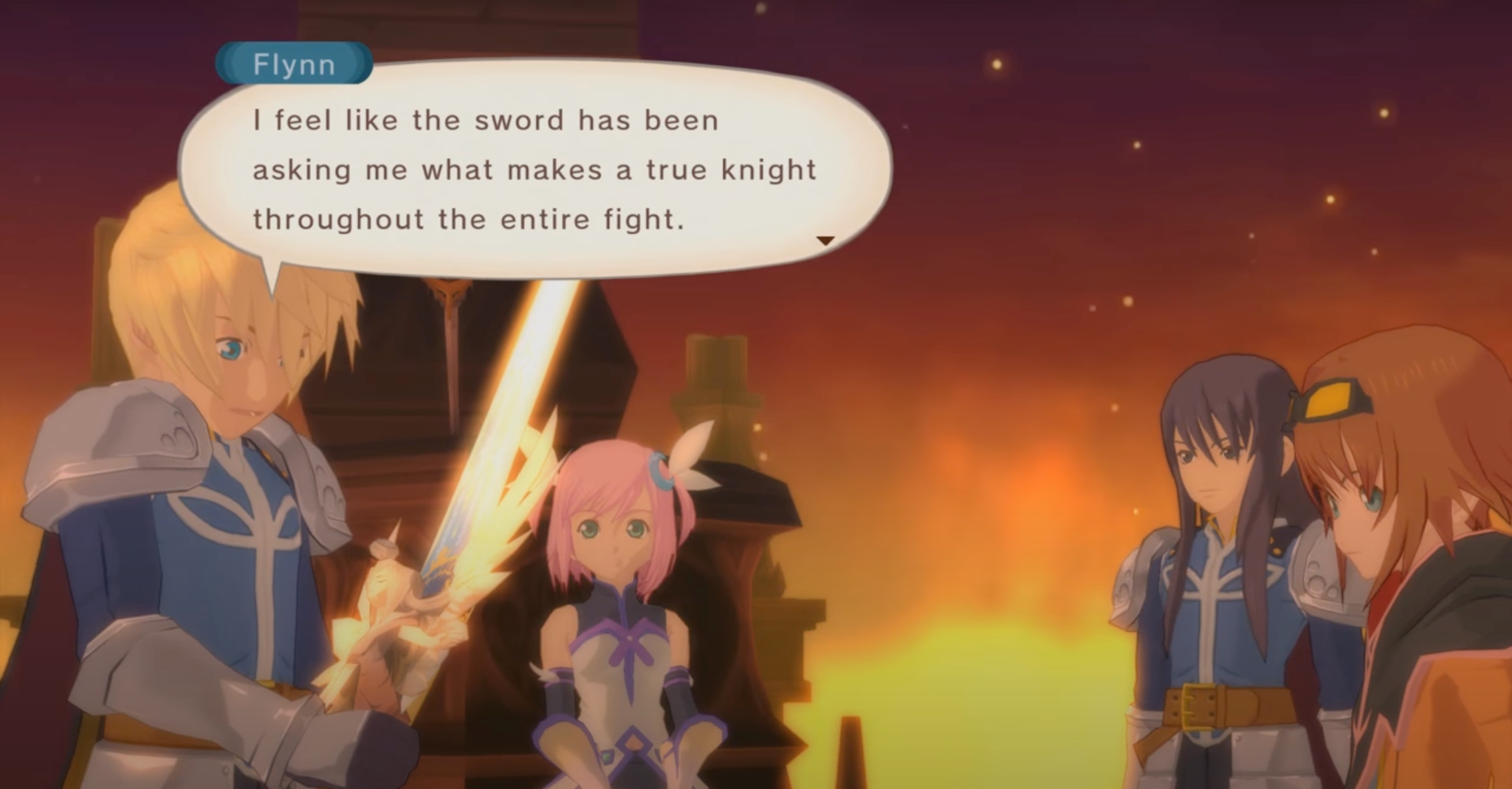
Flynn reflects on the meaning he has found in the act of reclaiming the Imperial Knights’ Sword of Prayer, Rag Querion, from the clutches of the Sword Dancer.
With the support of Brave Vesperia, Flynn can undertake his own optional journey to reclaim Rag Querion, the sword that proves a “true Knight,” from the clutches of what may or may not have been another of Alexei’s schemes to parasitically synthesize his own Dein Nomos. This intersection of Flynn the Knight and Flynn the Brave Vesperia Supporter shows two narrative threads of Flynn’s individual tapestry: his commitment to enacting the collective honor and stewardship of Imperial Knights, and his commitment to enacting the collective will to group-agnostic individual empowerment intrinsic to Brave Vesperia. This is the key to forging and using a sword of group principles without subsuming and limiting individuals according to those principles, as we witnessed in the previous act: when the inquiry of deciding on principles of group action proceeds by helping individuals to tell their own stories, individuals have the latitude to translate different parts of themselves into different, equally sound principles and incommensurable commitments—and with enough individuals acting in this way, the communities of the world can network their principles of action together according to the individuals they share, ordering the trajectory of global society without erasing those groups in favor of a single, hegemonic society. As Flynn bears the commitments of Brave Vesperia and the Knights with Brave Vesperia No. 2 and Rag Querion, so Yuri bears the commitments of Brave Vesperia and his family, the lower quarter of Zaphias, with Brave Vesperia No. 2 and Claiomh Solais.
Once Tales of Vesperia shows us this full range of personal mobility and interrelationship, from the ontology of the world all the way up to literal swords and their wielders, we arrive at a simple, robustly justified call to action: every individual in whom we intrinsically invest can exponentially improve the order and collective intention of the world, and every individual we invite into our communities can expand their impact on the world by enriching their own personal story. This call to action conducts the symphony of Tales of Vesperia‘s final motion: investing in individual characters to give them the self-concept and standing to call Duke back from his solipsism, welcoming him into their group and praxis.
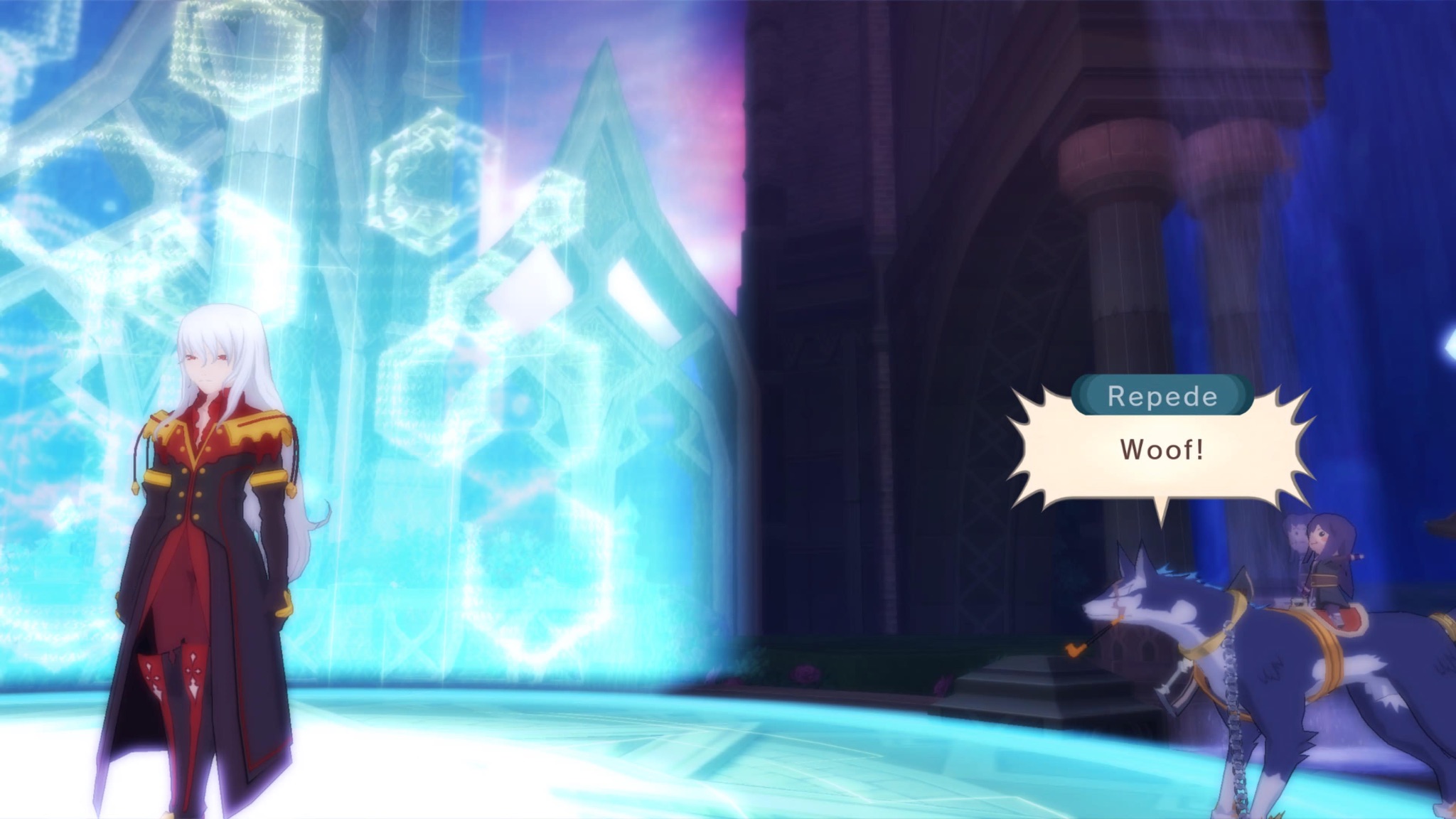
A dog who does not think of himself as a dog confronts a human who does not think of himself as a human atop Tarqaron.
In my own most recent playthrough of Tales of Vesperia, I found myself investing in Repede, the dog who partners with Yuri, acts as “an honorary member” of Brave Vesperia, and embodies the principle of supporting and coexisting with these bearing different perspectives and speaking different languages than your own. From the first moment of the game, I decided to treat Repede as the “focal character” of this particular journey: leading the battle party with him and using him as the party’s avatar, its representative in travels through towns, dungeons, and the world at large. While my main motivation for this was to better share the experience with my own “Repede” who shared the couch with me during my adventure, this dog also offered me unexpected insight into the story’s cultivation of volition, the process of helping each agent find and exercise its own entelechy.
Focalizing Tales of Vesperia through Repede compels the player to engage with the story’s symbolism of Dein Nomos even in those moments of the game without overt conversation. Take up Repede as your avatar in battle, and you immediately encounter an intentional gap that you can’t bridge or negotiate as you would with a human character. Yuri’s very first battle with Adecor and Boccos is choreographed around conversation between the Knights trying to arrest their former comrade and the vigilante pursuing the lower quarter’s blastia; much later in the story, in a skit, an argument between their arte philosophies explicitly distinguishes Yuri’s ad hoc, opportunistic approach to swordplay from Flynn’s knightly style (in Raven’s words, “Flynn, champion of tradition! Yuri, pioneer of a new style!”). Especially in Tales games featuring plenty of conversation and reflection, players can typically count on understanding why human characters are behaving as they are, even when their intentions diverge from the player’s (think of Karol’s tense mix of paralyzing fear and fierce desire to be brave in his duel with the aer krene predator in the Blade Drifts of Zopheir). Meanwhile, Repede’s animal gait reacts to player inputs differently than human ranges of motion, making the mere act of manipulating him in battle feel, especially initially, like an unnatural act of translation.[11] Even as we directly guide Repede, we’re left to infer his intentions through our own interpretive lenses along with the rest of the characters, turning foreign gestures like his Mystic Arte—an assertive bark, followed by a decisive slash of his knife—into a technique with a name, “Slash!!”, based on how the other party members feel it ought to be described.
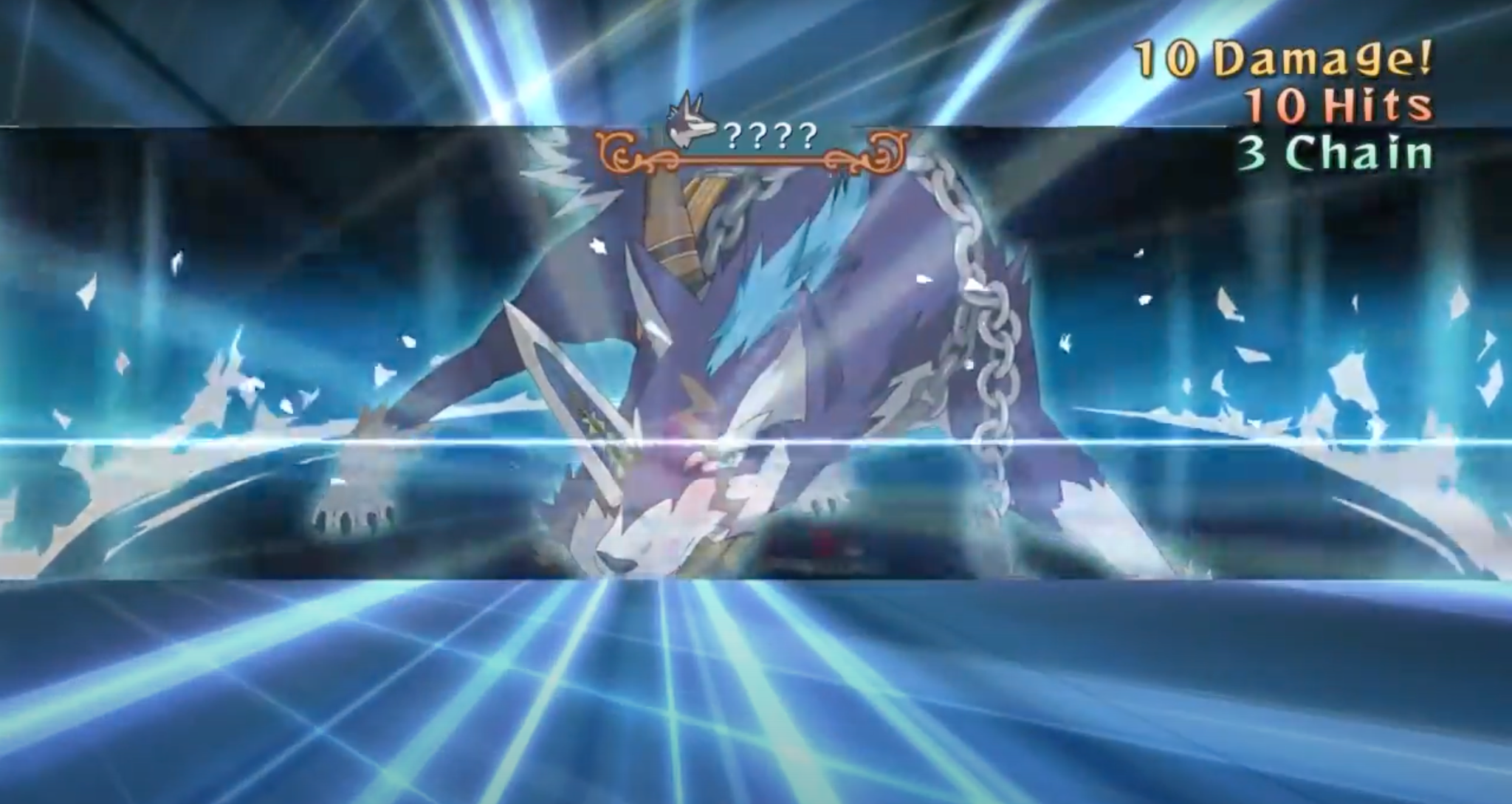
Repede unleashes his Mystic Arte for the first time, its description inscrutable until the human party members convene and decide what they ought to call it.
Yet Repede does have intentions of his own, intentions that relate to humans without reducing to them: his Mystic Arte, remember, is a monster technique he only learns after saving the young boy Pauly from a kidnapping bandit in Heliord—a rescue mission he undertakes on his own, leaving the party to catch up and support him after the fact. While humans may seem better equipped to understand and support one another, the distinct phenomenology of Repede highlights the same struggle which they all must undertake: not to treat each other like wild, hostile animals, nor to treat each other like pets, but rather to respect the spirits of others for the sake of coexistence—knowing that we can never fully understand another agent’s inner life and intentions, but that we can give him the space and encouragement to fulfill those in conjunction with our own. It’s no coincidence, on this reading, that Rita, the scientific and thematic progenitor of spirit conversion, is the party member who finds the language to name Repede’s Mystic Arte simply in reference to what it is (“It was a cut, right, so just call it “Slash!”) rather than in reference to someone else’s perspective on the world and Repede’s role in it (e.g., Karol suggesting “Whooooosh Attack,” Raven suggesting “Mercurial Laceration”).
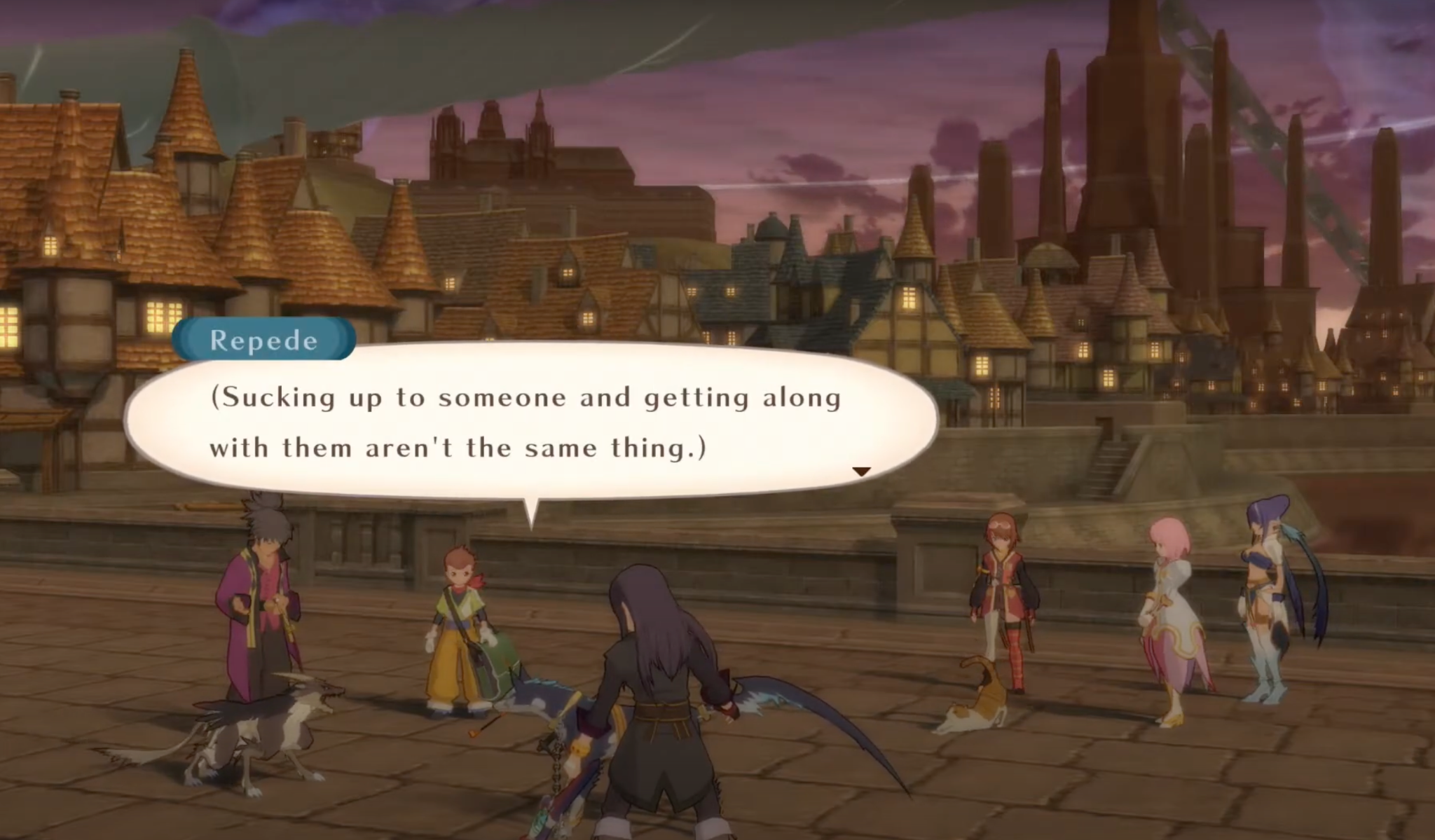
With the support of his humans, Repede stands up to his rival in defense of interspecies coexistence during the Dog Map quest in Dahngrest.
Repede begins the journey as one half of a pair of lone wolves: he and Yuri support each other in their solitude yet don’t interfere which each other’s instinctual, almost inexpressible desires, exemplified when they quietly recognize and acknowledge each other following Yuri’s execution of Ragou, earning the dual, animalistic titles of “Sinful Sidekick” and “Vigilante”—this is the Act 1 conception of Dein Nomos. Yet as the group begins to publicly articulate and hold each other accountable to shared ideals, Yuri’s private “language” of speaking with Repede and inferring Repede’s own sentiments becomes a group activity of interpreting and supporting Repede’s intentions in relation to their own. His rivalry with “Little Wolf,” another not-quite-canine alpha from Zaphias, is acted out with Yuri, Raven, and Rita serving as “translators” for Repede, Little Wolf, and a feline damsel in distress, situating a territory dispute within the framework of Brave Vesperia’s creed. This assignment of the group’s principles of justice and coexistence to a literal marking competition between dogs doesn’t conceive of the animal in purely individualistic terms, but it establishes a relational bridge from which the humans in the group can understand and support Repede’s protective gestures toward them and other animals as embodiments of the more purely instinctual aspect of the guild’s ethos—this is the Act 2 refinement of Dein Nomos. That relational bridge gives the rest of the party, along with the human player, the standing to eventually see and empower Repede on his own terms, allowing him to see through his personal missions by affording him a literal and metaphorical mobility which he could never achieve on his own. His domination of Little Wolf is only possible with the help of a group of human, Entelexeia, and a player willing to doggedly take Repede to literally every land-based location in the world to mark his territory—a task so taxing to see through that players will likely only complete it if they really have intrinsically invested in Repede. The tokens of Repede’s past—an arte and medal that serve as mementos from the Imperial Knight dog we may choose to believe was Repede’s mother—can only find their way to Repede by the party’s commitment to hunt down every Giganto Monster across the world, fulfilling the wish of the late emperor’s brother, Regin, “that people could live in peace, without having to worry about being attacked by monsters”—a wish that echoes Repede’s own protectiveness and inadvertently brings the group together with the innkeeper couple whose fathers were part of Regin’s expeditionary force and knew the master of Repede’s mother, helping Repede to rediscover his place and identity in a group, a family, beyond Brave Vesperia. These two pillars—helping Repede to walk on his own four feet, and showing him who he is in networks beyond our own—is the Act 3 actualization of Dein Nomos, the key to the group-facilitated autonomy that gives Repede the presence of self, his unique self, to rebuke Duke and welcome him back into community from solipsism.
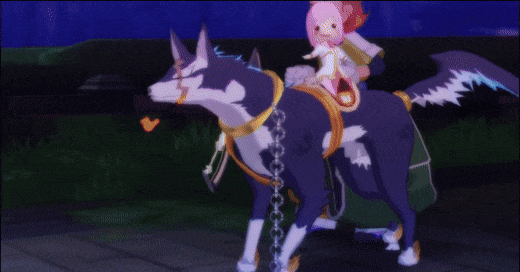
Repede, as party leader, approaches Duke at the top of Tarqaron.
What might in another context feel like a joke—a conversation between a JRPG’s final boss and an animal who only speaks to him in woofs and barks—marks a maturity in Repede that reconfigures the most influential relationship in Duke’s life, his raison d’être. Remember that not too long ago, Repede extolled to Little Wolf the virtues of coexistence between humans and non-humans in translation by his human companions; now, fully individuated with the support of the party, he speaks to Duke on his own terms, showing in his actions and commitment to Brave Vesperia the potential for nonreductive group harmony among those with different forms of self-expression. Yuri will not translate for Repede because Repede has become a complete expression and single face of the values which the guild has synthesized from its members: reminding Duke of his bond with Elucifur, an Entelexeia whom he tragically, ironically objectified as a tool for mass genocide rather than the ecological diversity two of them championed together in life.
Despite the background I’d learned about Duke from Sylph and about Repede from Yuri, Flynn, and the innkeepers of the King of Adventure, there was a moment when Repede solemnly approached Duke (pictured above) that I truly felt Repede had found and was confronting his former master. I don’t think this experience is an errant coincidence: as Brave Vesperia’s empowerment of networked individuals propagates outward, that same impulse to “agency over folklore” which we studied in Act 2 gives individuals the ability to network into each other by relating to each other based on similarly in their roughly articulated, chaotic backgrounds, rather than trying to find common ground purely on the basis of joint participation in clearly catalogued causal histories. Duke’s exact family lineage, motives for fighting in the Great War 10 years prior to the events of the story, and history with Elucifur aren’t robustly chronicled within the story, nor do we discover clear, unambiguous explanations of Repede’s previous owner, nor the truth of whether his mother was the dog whom Regin’s expeditionary force knew.[12] Yet in the absence of historical records and origin stories, we see in starker relief the thematic similarities between the two: where Duke was friends with a misunderstood member of a nonhuman species, so Repede is a member of a misunderstood nonhuman species who has befriended a diverse group of humans (and one Krityan). Absent the game’s story emphasizing or even articulating the causal links between past events—in fact largely precluding such an account on the basis of the chaotic relationships between energy sources, individuals, and groups—these points of thematic similarity feel less like symbolic, figurative connection and more like a direct and literal relationship: without more explicit background grounding the literal relationships of Duke and Repede’s past, what is the difference between their seeing something of themselves in the other and their “actually being” erstwhile human and non-human companions, reunited after a long absence from each other? The praxis of Brave Vesperia’s Dein Nomos is that this extension of thematic content from one’s personal narrative to that of another is all that relationship consists in, which gives Duke the opportunity to finally process the loss of his past relationship by recognizing Elucifur in the present-day individuals who come before him atop Tarqaron, rather than clinging to his memory of Elucifur as the basis for his self-justifying, solitary principle of will.
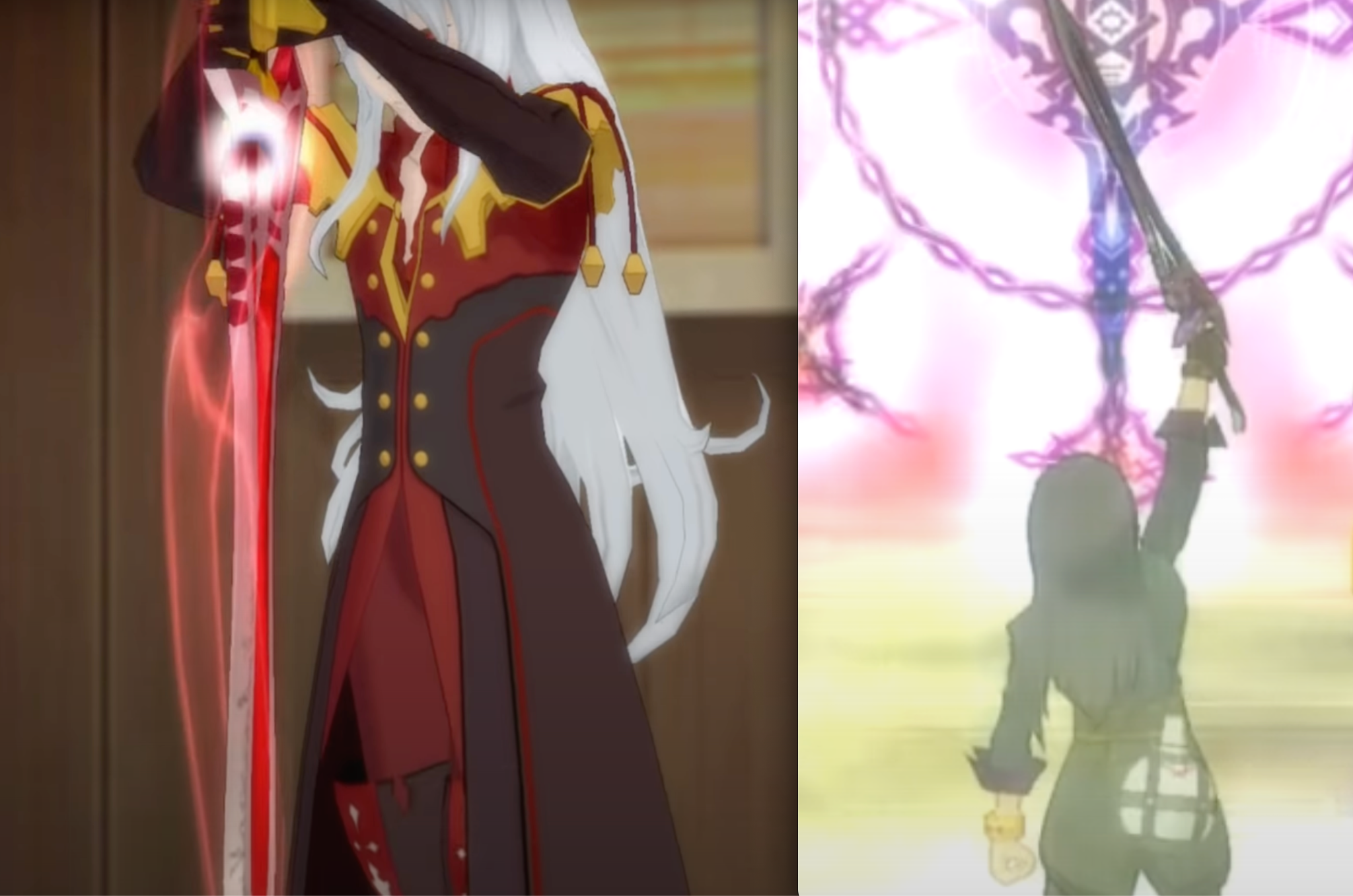
Left: Duke invokes Dein Nomos to destroy the Clear Ciel Crystal in Phaeroh’s projection of Yormgen. Right: After Duke lends Yuri Dein Nomos in Baction, Yuri invokes it to disarm the seal blocking the party’s progress to the inner chamber where Astal, Alexei, Estelle, and Schwann wait. Notice the glowing light surrounding the small gem at the bottom of the sword’s shaft when Duke wields it, and the lack of this glowing light when Yuri wields it.
Tales of Vesperia offers chaotic data for stories rather than meticulously explicated lore; here’s one story we can tell from the data it presents us. We know that Duke, hero of the Great War, fought alongside his friend, the Entelexeia Elucifur, who defended coexistence between humans and Entelexeia, only to be betrayed and killed by the empire who “feared his power.” We can discover in optional conversations that a being mistaken for a “monster” who was a friend of Duke’s, affiliated with no man-made institutions, has its “remains” interred on Ehmead Hill. We’re told that apatheia are the remains of an Entelexeia, that blastia derive from “crushing apatheia,” and that Duke claimed Dein Nomos at some point during the Great War 10 years before the story. And, if we look closely (as in the above image), we might notice that a small gem at the bottom of Dein Nomos’ shaft glows when Duke wields it, and not when someone else (such as Yuri Lowell) wields it.
As with imagining Duke as Repede’s former master, we don’t need to look for a textually complete explanation to imagine that a crestfallen and betrayed Duke might have seized the symbol of the empire that double-crossed and killed his friend, laid most of Elucifur’s remains to rest, and adorned Dein Nomos with a small, crushed portion of those remains, a gesture reappropriating the hegemony of the largest of humankind’s largest “man-made trivialities” for the poetically ironic purpose of undoing humanity’s influence on Terca Lumireis, channeling the energy of Elucifur himself to “return it to its natural state.”
This imagining can help us to understand the mechanics of what happens in that otherwise disorienting moment of the final battle when Duke calls on the spirit of Elucifur to “give [him his] strength”: invoking the power of the Elucifur-derived blastia, augmented with the life energy fed through Tarqaron, to transmute his own being for the sake of carrying out his plan. It illustrates the sad failure of Duke’s principle of will: while he doesn’t manipulate and autocratically organize people to synthesize and enact his own Dein Nomos, the principle which Duke takes to predicate, and therefore take priority over, all others—the principle that the world ought to remain in its original, natural state—was not synthesized through the collected consent and interest of all Terca Lumireis’ guardians, but was taken up solely by Duke as a hypostatized weapon of his grief, turning his sense of past-tense betrayal into a present-tense justification for robbing the world of its choices, of its capacity to act and change.
Duke took his own moment of betrayal and turned inward rather than outward, retracting into himself rather than publicly settled accounts and revising group principles as Brave Vesperia did. In that flight from community, he inadvertently rendered himself inert, fixated on ideals and a narrative directed toward a past in a world that only cares about validating and coordinating the wills of the present for the sake of the future. It’s only natural, then, that Duke would call on his “friend”—the energy of Elucifur—exactly at the moment when he can no longer bear to face the individual arguments and perspectives of the player’s chosen party leader, retreating from that individual’s relationship with community to his own, tragically corrupted object of “community.”
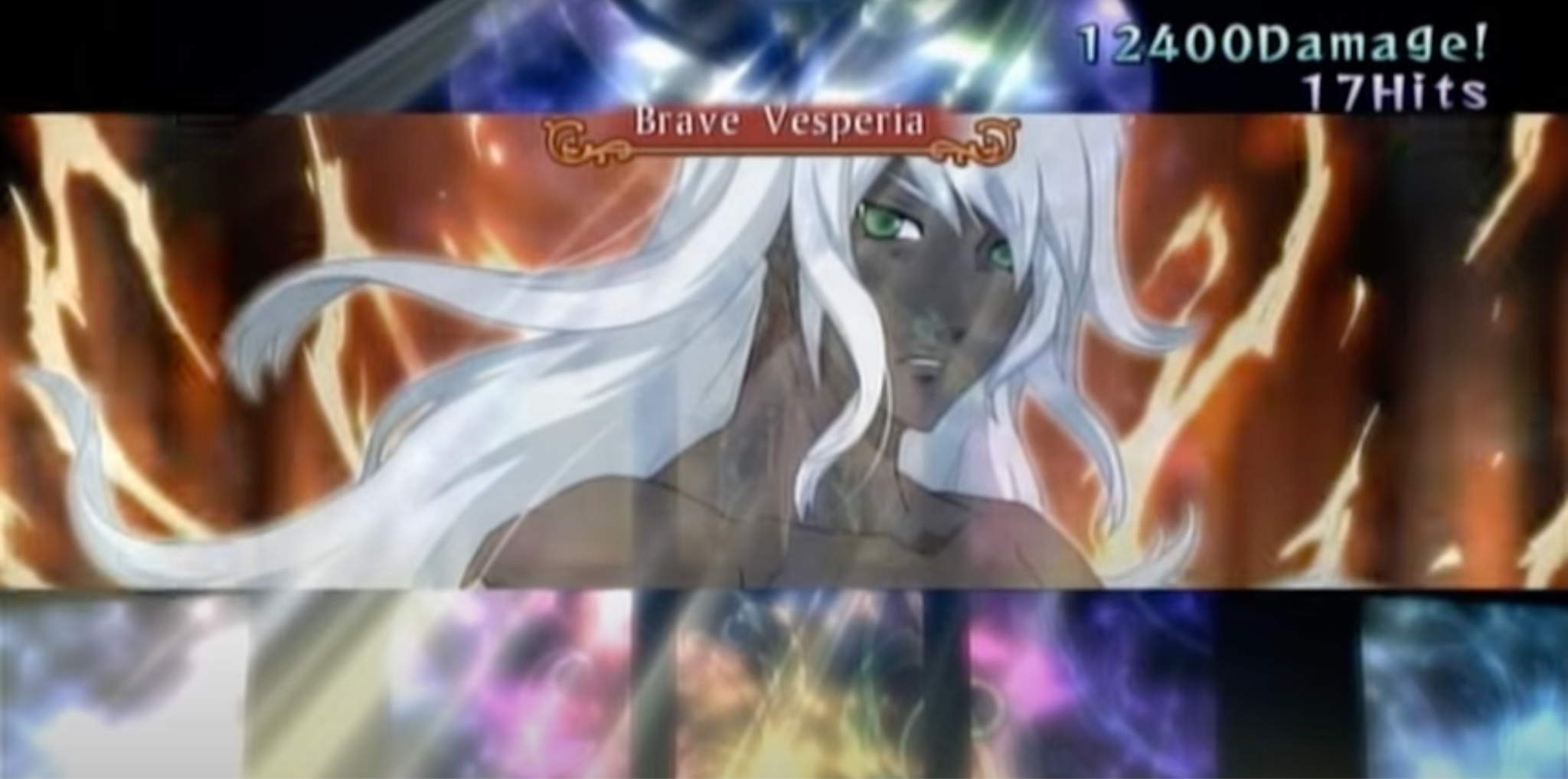
The Radiant Winged One—Duke, after invoking Elucifur and absorbing the power of the restored fell arms—unleashes his Mystic Arte, “Brave Vesperia,” using the techniques of the group against them.
Kronos absorbs the life energy of the present to reassert the past that’s always loomed latent in their actions; Duke absorbs the life energy of the present to assert an order he believes individual actors are incapable of replicating. He betrays the misunderstanding upon which his own volition is founded in his third form, the “Radiant Winged One”: if the party makes the effort to collect the fell arms—the weapons which those Children of the Full Moon who opposed the Entelexeia forged out of the apatheia from aspects of the Spiral Draco, the Entelexeia’s king, in order to slaughter them—a Duke who already invoked and absorbed the power of his own Entelexeia friend through an apatheia-enhanced Dein Nomos and the life force channeled through Tarqaron finds Dein Nomos and Tarqaron resonating with those fell arms and enshrining their power within him, a power which Duke identifies as the Spiral Draco’s and takes as evidence that his principle of will is “the will of the very planet. The will of Terca Lumireis itself!” The fell arms, like the formula Duke enacts through Tarqaron, are designed to absorb the “very pure mana” of life energy in order to enact the will of the individual wielder, turning the lives of those slain with the blade into more power for that blade, with no reference to any community beyond the user. As Duke absorbs the raw potential of every human on Terca Lumireis—as, in his “radiance,” he executes a Mystic Arte named after the heroes’ guild, which synthesizes aspects of all their individual Mystic Artes into a single attack—he expresses the dogma that the human nature which the spirits described as “fragile” and susceptible to betrayal justifies the the disregard of all other individual wills in favor of a single principle that sustains the world regardless of other individual principles. Where Alexei tried to build a single, oppressive community that organized everyone within it according to Alexei’s principles, erasing individuality in the process, Duke vividly acknowledges the diversity of individuals and doubts that any kind of coordination is possible in the chaos of so many unique intentions interfering with and betraying each other—whence his desire to erase them all, to contain all actions of the party within a single attack, coding his disillusionment behind a commitment to the world’s natural state. When we see Duke undertake this erasure in full awareness of that which he intends to negate, he reveals his solipsism as one much more recalcitrant, more soberly and ruefully adopted, than the naive solipsism which the members of Brave Vesperia overcame in a much healthier way one act earlier.
But because Duke is an actor who has entrenched himself within his principle of volition with no community attachment, he is just as corrigible as the traitors who defected from Brave Vesperia only to be welcomed back into the party through a public settling of accounts. And Duke’s source of pathos is also what opens the door to hope for his redemption: as resolved as he is in his solitary beliefs, a part of him—perhaps that part which absorbed some aspect of Elucifur’s soul, or that part which had kept Elucifur’s daughter by his side as his solitary, conflicted advocate—still seems to seek the affirmation of his methods, a group who would assure him that his was the only possible method to secure the world’s future, especially in the wake of the Entelexeia abandoning him for spirit conversion. Not only does Duke take the time to engage with any member of the party who might approach him on their own terms and genuinely try to justify himself to them, but his other Mystic Arte which he uses from his channeling of Elucifur onward, “Big Bang,” proposes to reset the world’s nature—to “toll the beginning of time”—yet, unless the player deliberately makes the game’s combat harder than normal, the attack “resets” the party, reducing those in combat to potentially as low as a single hit point, without ever killing them. It is as if a part of him recognizes that his logic of individual volition must leave conceptual space for the value of other agents, fragile though they may be, and so quietly desires the consent which he would deny others.
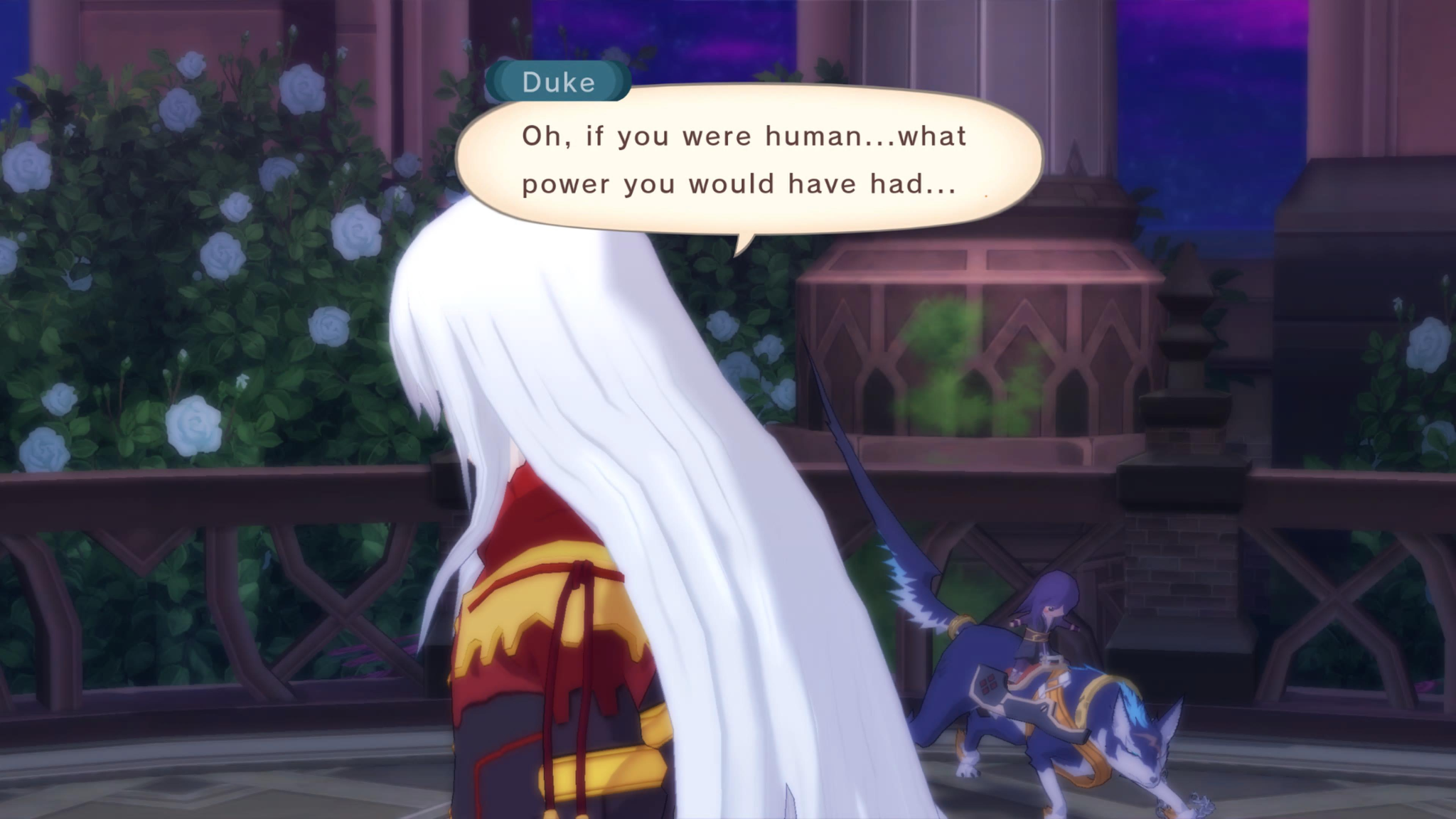
Duke admires the will of Repede after the party defeats him for the first of three times, before he goes on to invoke Elucifur.
The party’s principle of individual empowerment renders them the ideal group to show Duke the error of his ways. Where Duke champions a view that accounts for all of their potential actions in a single principle of will, a single “Brave Vesperia” Mystic Arte, the fully actualized story of any single character in the party suffices to show him a way in which to connect him to their community—any single, individual connection joining two nodes in a network, but not, as we would see in a different JRPG, the entire party debating Duke as one, cohesive unit. The latter approach would only reinforce Duke’s preemptive distrust of chaotic, betrayal-apt communities; the former approach shows Duke how investment in specific agents other than ourselves can forge trust, understanding, and a unity of purpose that coordinates otherwise chaotic communities. Ultra Kronos reverts to Kronos when the Swordians and masters reject his hegemonic hold on the world’s history; the Radiant Winged One reverts to Duke when Brave Vesperia shows him how to tell a story reconnecting himself with a community, rather than a story that hypostatizes his personal loss as epistemic and metaphysical self-imprisonment.
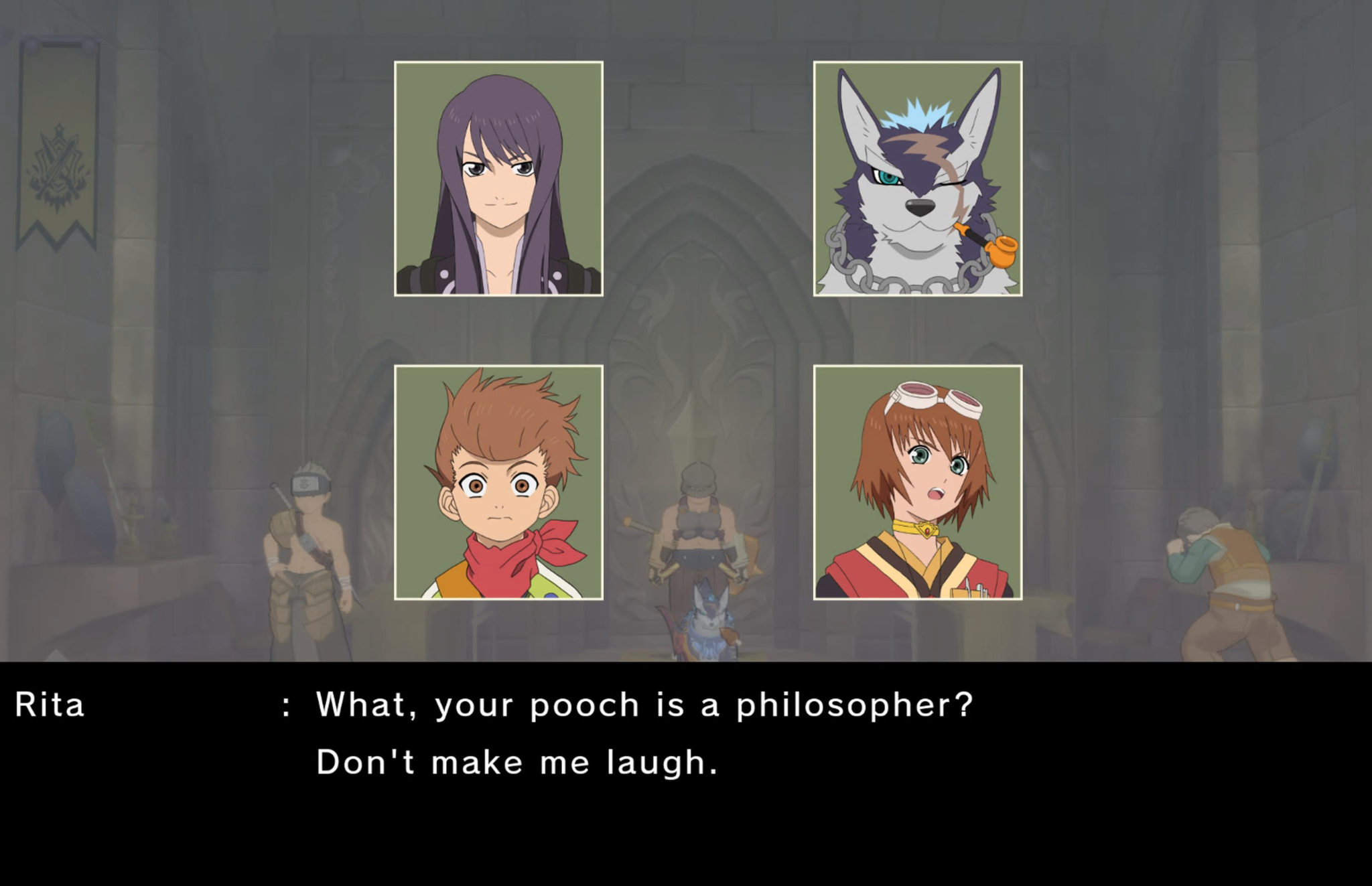
“Well…”
I found Duke’s redemption in Repede showing him a different model for how non-humans can help human friends to shape an organized future founded in all of their individual narratives, where Duke had fallen into the fallacy of weaponizing the loss of his friend and thereby erasing his fallen friend’s autonomy. I found this path because I was personally invested in unraveling and empowering Repede’s story from the start, which left me in a position to genuinely feel and endorse his principle of action by the time he stood up to Duke. The magic of this full enactment of Dein Nomos is that we can follow and invest in whichever characters we choose and experience their specific contribution to the redemption of Duke.
- If we gravitate toward Rita’s scientific unraveling of the world and invention of spirit conversion, we can uncover her foundational contributions to a new magic based on spirits rather than aer, her intentions to follow in Hermes’ footsteps in the wake of a fully processed relationship with Judith, and an appreciation for the underlying mysteries that remain in the world no matter how much scientific investigation one might undertake. We witness Rita confronting Duke and experience a climax focused on the value of seeing change in one’s identity as evolution, rather than a betrayal of one’s former self.
- If we find ourselves taken with Estelle’s tensions between a “destined” role in the world, a sheltered existence, and an unwritten path, we stumble upon her finding her voice as a writer rather than a princess or healer by hearing the horror story of a murdered emperor’s bride staining the Great Tree of Halure’s petals red, and giving birth to a new elemental spirit by telling a different, “more holy” story explaining the red blossoms according to a royal romance fairy tale of her own making. With Patty’s help, we watch her uncover the literal and figurative depths of the Children of the Full Moon in Zaude, discovering that what was passed down in history as a unanimous decision to sacrifice themselves to power Zaude and suppress the Adephagos was actually the imprisonment of one faction by another, one of which supported Zaude within a subterranean mausoleum and the other of which sowed the seeds of the modern empire. Estelle synthesizes these in her confrontation with Duke, telling what might be interpreted as a story of betrayal as a lesson that hope for the world should not come at the cost of anyone, rejecting that it is noble for some individual wills—even those of embittered, imprisoned rulers like Ohma—to die for the sake of a principle that sustains the world.
And so on for all six of the other party members: as you can fill in the details of their optional adventures for yourself, so can you apply your own frameworks of interest in those characters to arrive at the meaning of Duke’s redemption as it is specified in your playthrough, and only your playthrough. The value of our investment is most glaring when we find ourselves encountering an ending without that investment in place: if you elected to set a certain party member as the leader to confront Duke simply to “see that ending” without actively choosing to engage with their side content for its own sake, I’d imagine your experience was comparatively anemic: they still have standing to assert themselves as one contributor to Brave Vesperia’s principles, but that individual investment is how we forge that particular character’s principle of volition, that character’s Dein Nomos. The corollary is that, the more you kind bring yourself as a player to find a reason to personally invest in every character, the more holistically you can see and effect the diversity of motives and actions that defines their praxis, the praxis that conquers Duke’s. The more portraits you study of characters appreciating their place in the world in full awareness of the chaos surrounding them in the form of unsolvable mysteries—Rita’s love of magic’s mysteries, the mystery of whether Alexei was really involved in the golem experimentation around Rag Querion, even the mystery of what voice channeled Kratos Aurion into Terca Lumireis for what purpose, through what kind of interdimensional space—the better we understand how deftly large networks of people can coordinate themselves within unpredictable systems or actors, without the need to give up on that system as Duke would.
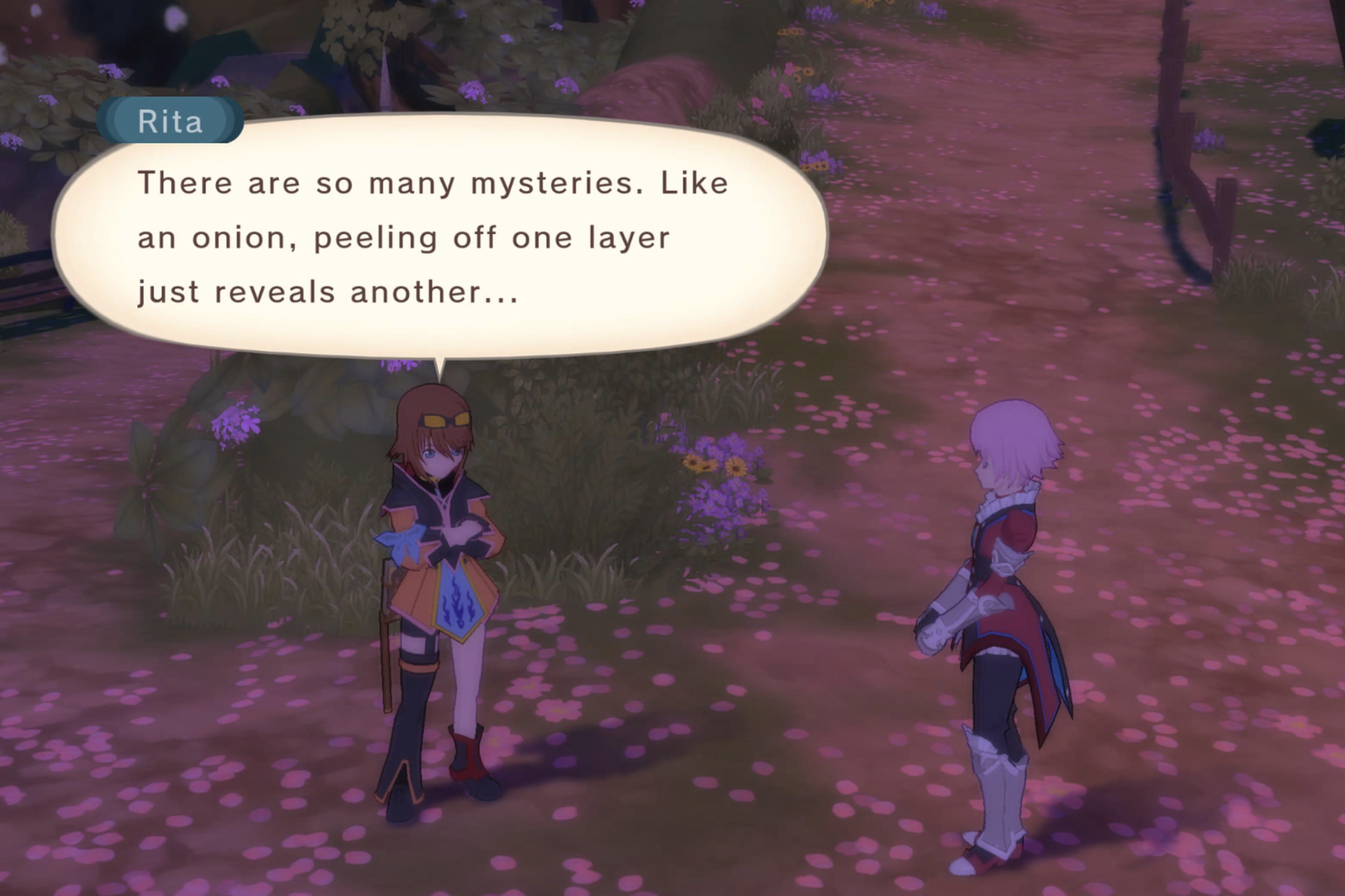
Rita revels in the persistent mystery of magic and the world’s nature after finally being recognized among her fellow Aspio mages as an influential, elite mage.
In another JRPG, a journey like the Necropolis of Nostalgia—where we witness firsthand the 1000-year history of the world through the imprisoned Children of the Full Moon and the former King of the Entelexeia—would be a key sequence of revelations in the game’s main story, or else a whole secondary plotline through which to explore the history of the world. In Tales of Vesperia, the journey’s contribution is in its name: Estelle sees another partial, muddled vision of a way in which things might have previously been—citizens who have lost their sense of self, a leader so warped by 1000 years of aer-fueled self-preservation that he’s lost his body and mind, and an Entelexeia who is unable or unwilling to express himself—and learns a lesson for her own principle will in the present, one which recognizes the impetus to reach into the past to try to rectify history as a necropolis, a prison that buries agents by isolating their entire system of decision-making from the current communities, individuals, friends with whom they could organize a new future.
The gift of Dein Nomos, what Tales of Vesperia contributes to our dual cultivation of individual principles of volition, is a language: the speech pattern through which we can free ourselves by seeing others. Duke was saved the moment Brave Vesperia approached him atop Tarqaron because they had already forged the right kind of multidimensional group whose members have all learned to build new groups by helping others tell their own stories, here and now. As much as Duke insists upon his ideology throughout the final battles, those battles—from his isolation, to his invocation and instrumentalization of Elucifur, to his involvement of all individual agents—are the expression and clarification of his own story, a microcosm of the character studies we conducted across the story to individually discover and actualize those party members in whom we were most interested. The result of the battle, then, is already written according to Brave Vesperia’s Dein Nomos, the true symbolic Dein Nomos: with Duke’s story and principle articulated and understood in the present, no longer bound up in the miasma of his past, he can literally and figuratively join the party: linking his principle of will, his Dein Nomos, with theirs to chart a coordinated, new future of individuals, one in which the threat of runaway entropy itself, the Adephagos, is reconfigured into countless individual intellects: spirits with whom to chart a future that honors each action on its own terms, yet never in isolation.
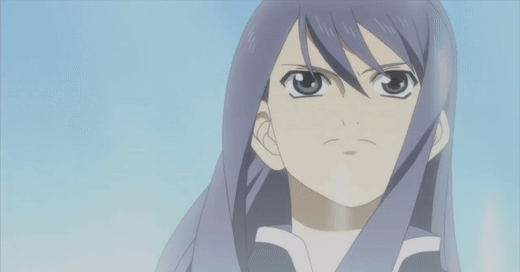
Yuri and Duke acknowledge each other as Duke lends his own individual will to Brave Vesperia’s Dein Nomos, charting the course for a new world order.
With one hand, Stahn learns to put down his sword; with the other, Yuri learns to raise Brave Vesperia’s heavensward. To me, these protagonists are two of the most quietly admirable in JRPGs because they breathe life into worlds and countless stories other than their own. With his simple capacity to truly understand others and believe in their capacity to improve the world, Stahn can draw personal strength from the lessons of history—his Swordian, his mentor—without clinging egotistically to that history, rectifying society’s harmony by returning his friend to the context of the Aeth’er Wars when no one else was able or willing to do so. From his beginnings as a vigilante only concerned with his personal sense of justice, Yuri discovers, attends to, and empowers his friends with their own individual principles, extending his philosophy of self-governance outward to create a community of those who voice their own stories for each other’s sakes, forging a sword that orders humanity without imposing limitations upon it.
Yuri and Stahn needed antagonistic portraits of inverted sword/user relationships in order to reach their own principles of volition, but they remain two sides of the same coin, their own inversions. Dymlos is a sword without his own agency, and therefore needs the will of its wielder in order to be enshrined in his proper historical home. Dein Nomos, inversely, is a sword whose wielder’s agency is insufficient to wield it; this sword must be defined and supported by everyone else in the party, lest Yuri meet the same solipsistic fate as Duke. Together, Dymlos and Dein Nomos show our heroes that their own, radical freedom is essential to the progress of the world, and that they can only seize this freedom through the delicate balance of respecting history and culture without becoming reactionary to it. Whether evaluating our place in time or our place in space, the song remains the same: to let go of that reactionary grasping once and for all, invest in authentically seeing, hearing, and helping everyone besides yourself in their proper context. If that context is beyond your own, the proper expression of support consists in parting ways; if the context overlaps with yours, this support consists in defining your own community by coming to understand those who would shape and enact it alongside you.
And, if that context consists in the act of playing a JRPG, the best way to learn this lesson is to take the advice of Tales of Destiny and Tales of Destiny by directly applying this praxis to your playthroughs—only to discover the way to extend it to your life beyond the games.
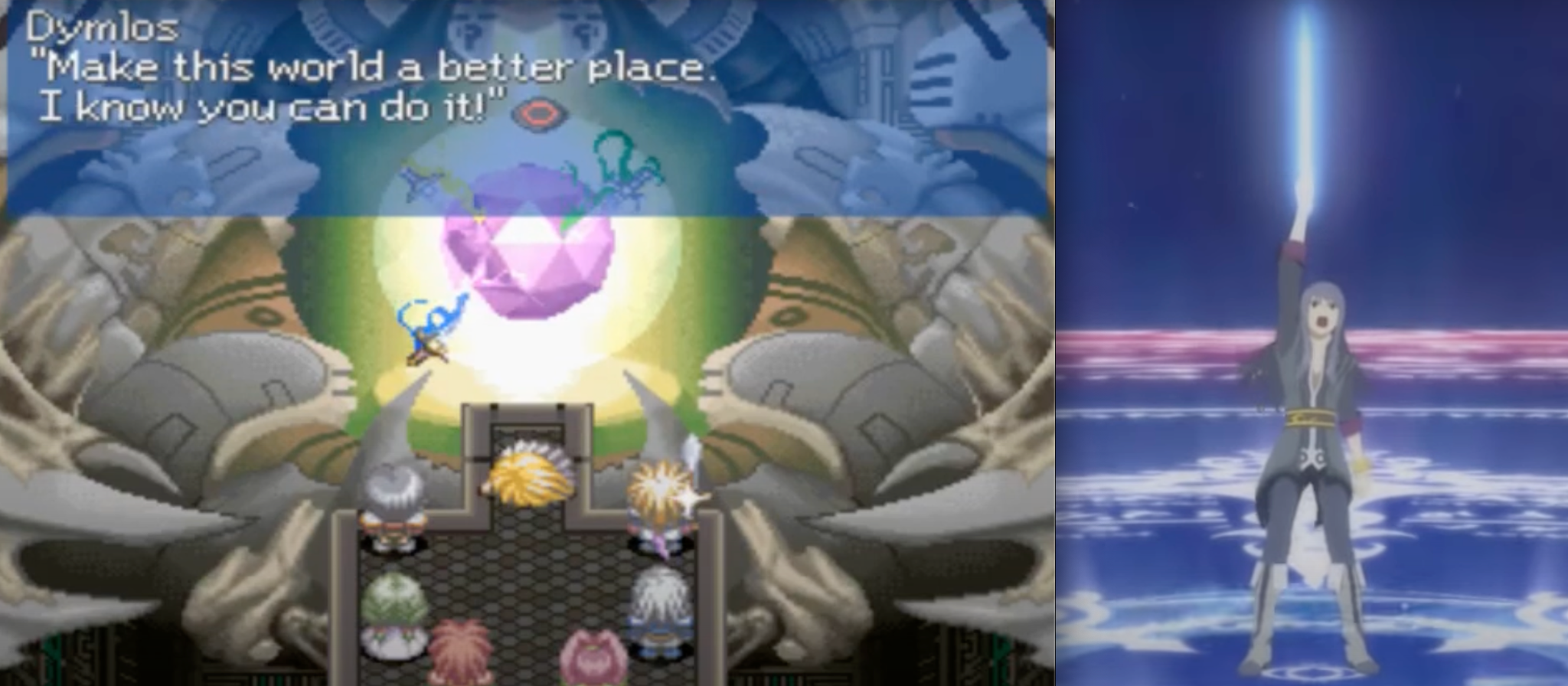
Left: Dymlos entrusts the future to Stahn and the other masters. Right: Yuri raises Brave Vesperia No. 2 against the Adephagos, atop Tarqaron, with all of his friends.
The Player’s Duties in Tales of Destiny, Tales of Vesperia, and Beyond: “Leave Them Be, and Let Them Be”
The Tales that stay with us are the Tales that call us to action, and the magic of Tales of Destiny and Tales of Vesperia turns the controller in your hand into a sword with which to answer that call beyond the limits of your playthrough.

Left: Karyl cheers Stahn and his party on as they leave Karyl’s home, Aquaveil, in pursuit of Lydon. Right: Raven reflects on the complexity of his relationship with Yeager and the past after Gauche and Droite bequeath Casey’s bow, Divine Cannon, to him.
Without explicitly indicating available sidequests to players or applying an explicit morally “good” or “bad” valence to their choices, these games invite their human audience into a network of choices that empower them to find and wield their own Dymlos and Dein Nomos in their playthroughs.
For all of our focus on the Swordians and their masters in Tales of Destiny, there’s a range of optional party members the player may elect to bring along on the adventure to overcome Kronos. These optional characters aren’t like those of many other JRPGs: challenging to discover in the first place, and interwoven with the rest of the cast from that moment of discovery onward. Instead, the characters that neither hear nor wield the Swordians cross paths with the party and even join them for mandatory parts of the main story during contexts in which their motivations sensibly intersect with the party’s: Mary lets her friendship with Rutee take the lead as she struggles to recover her lost memories; Karyl guides them through Aquaveil to save his best friend, Fayte, and get revenge on Tiberius, Lydon’s pawn who forced Karyl’s father off the throne and was responsible for the death of Eleanor, a childhood friend of Fayte and his. Once Mary saves Dalis and recovers her memory, she stays in Phandaria to rebuild her life with him rather than continuing with the party; once Karyl saves his friend and deposes his kingdom’s usurper, he stays in Aquaveil to help rebuild the kingdom. They only become optional characters thereafter: once they part ways with the party, they are gone, returned to their separate context, unless you make the effort to find them at home after the rise of the Aethersphere and “recruit” them back into the party.
The lesson of the Swordians, I think, tells us that we ought to be ready, as a default, to leave these characters be. The symbolism of these swords isn’t limited to the context of 1000-year-old global wars: on a more intimate level, the same principle of action tells us that we ought to allow those in our own lives to depart from our journeys once our context no longer overlaps with theirs. We may wish to cling to characters we’ve come to know even beyond the point of that contextual intersection, despite the fact that their interests are elsewhere and they literally cannot communicate with those Swordians whose context drives the main plot of the story—but if we do make the effort to call Mary back into service from the nascent life she’s rebuilding with Dalis, Karyl back from the reconstruction of his homeland, then we must recognize that we aren’t recruiting them so much as we are drafting them back into service, none too different from Kronos drafting Lydon, Hugo, and Leon into service for his ancient war.
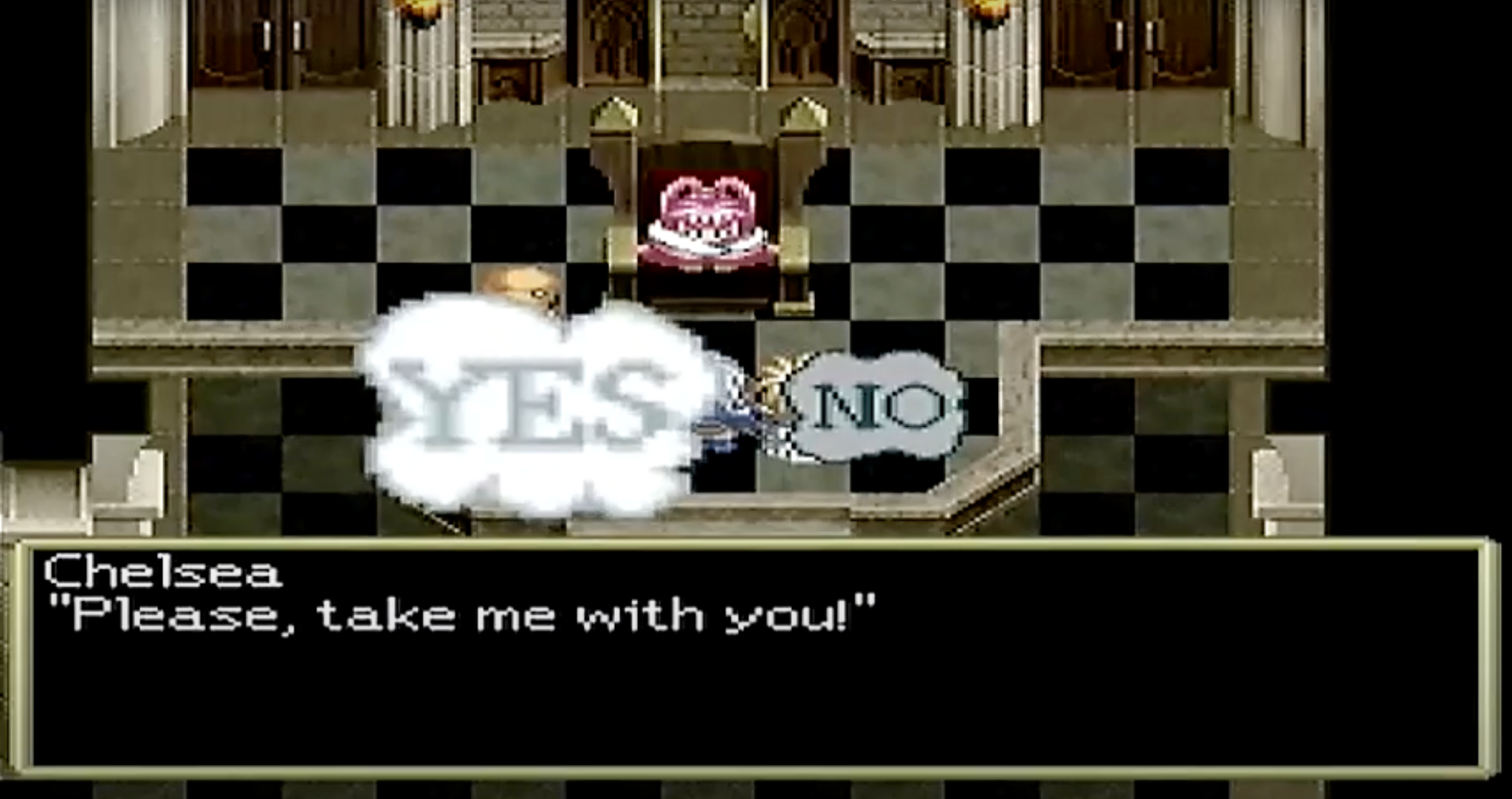
Will you draft Chelsea back into the masters’ present struggle, or leave the role she played in their travels in Stahn’s past?
Perhaps you find exceptions to this principle of will in your own playthrough: maybe you failed to save Dalis and want to take Mary on a journey away from her grief; maybe you appreciate Neuestadt Coliseum champion Khang’s desire to follow Stahn around after losing to him, should you take the time to optionally undertake the full gauntlet of battles there; maybe you believe that Chelsea, Garr’s surrogate younger sister, really is ready to join a group of heroes trying to save the world, despite Garr’s protestations that she isn’t—in which case, you might discover the opportunity to learn about Chelsea’s tragic history as a young orphan from her surrogate grandfather, Alba. Discovering and electing to recruit optional party members for such reasons is your prerogative as the player and makes for the special meaning of your playthrough, but that meaning is made possible, and mediated, by the symbology of the Swordians: if you play the game with a mind to making choices that don’t make you the same monster as Kronos, then, at every turn, you must justify why an optional character’s context, desires, and ideals continue to overlap with the party’s, rather than taking those characters onboard merely because they once contributed to the party’s journey, or because you can take them onboard, or even because they ask for you to take them onboard.
Tales of Vesperia: Definitive Edition, on the other hand, functions as a sort of “optional content” en toto, adding further characters and questlines beyond the story as it was originally told on the Xbox 360, and letting the potential player opt to play the definitive edition rather than the original edition. Within that optional ecosystem, though, the characters are not optional: Flynn joins the party with greater frequency and finality than he did originally, and Patty—the entirely new pirate, turned from a bold guild leader into a young girl in the aftermath (potentially) of Alexei’s further machinations—introduces further seafaring sequences directly into the mandatory motions of the main story. This tension between the optional and the mandatory, in my view, points to a structurally analogous duty which the symbolism of Dein Nomos imposes on us: we ought to make the effort to get to know, appreciate, and support as many individuals, on their own terms, as possible—to let them be everything they want to be.
Dein Nomos’ lesson is that the chaos of entire worlds can be called to order, a principled path to the future, through the contagious impact of individuals helping others to tell their own stories and connect those stories into robust, overlapping networks of intentional individuals. The more people with whom we can do that, the greater extent to which the world can be coordinated without sacrificing freedom in the process. I think that this is why, of all the games for which Bandai Namco could have released a new version adding additional party members to the main story, Tales of Vesperia is uniquely suited to provide a thematic justification for these additions. An unexpected consequence of this logic, notice, is that Bandai Namco could release a new version of Tales of Vesperia with even more party members added to the main story—Nan? Harry? A young Entelexeia? All of these, and more?—and that would become the new “Definitive Edition” of Tales of Vesperia, providing the player with a broader foundation from which to empower Brave Vesperia No. 2 and to craft the meaning of her own playthrough.
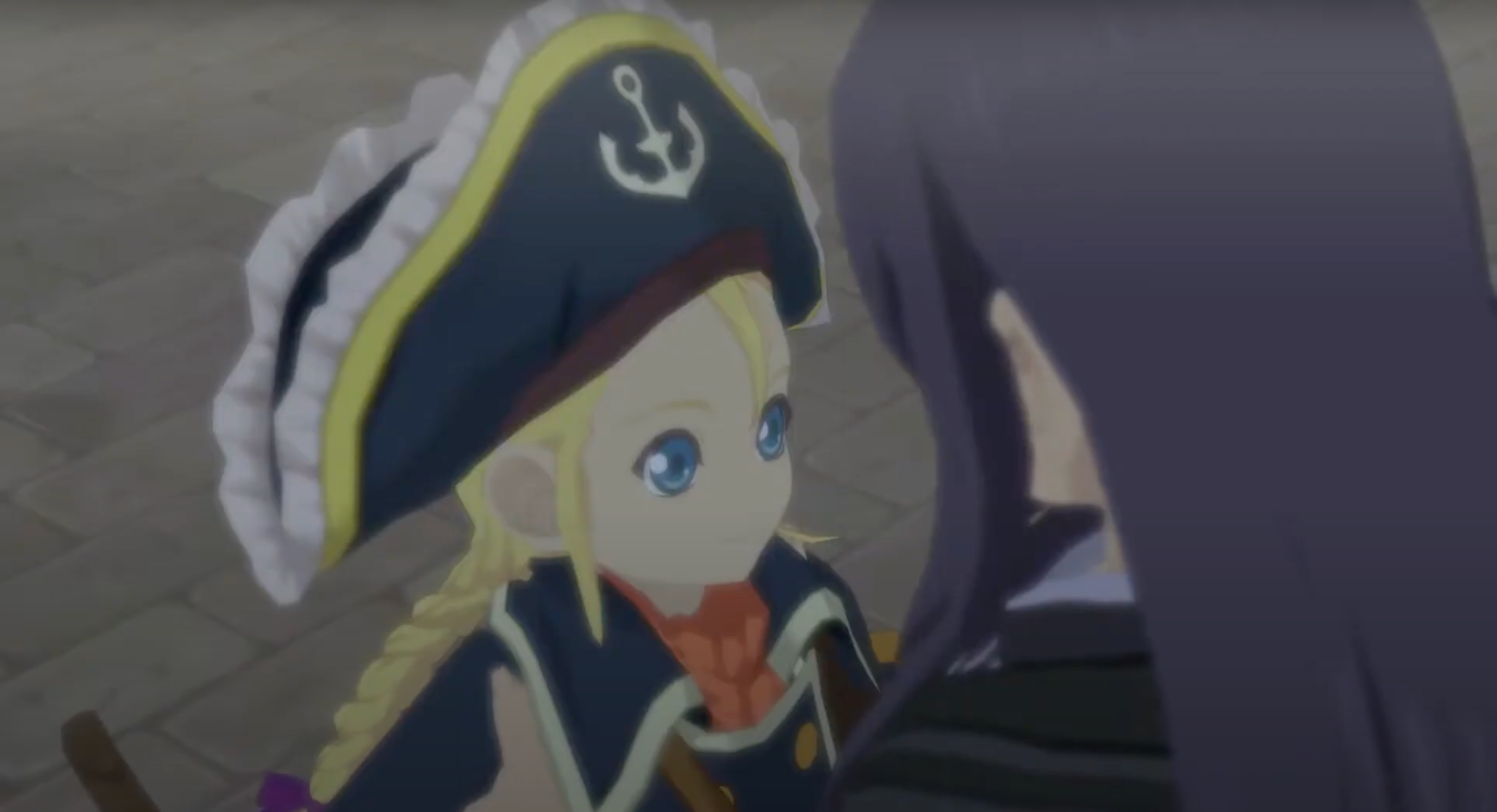
Patty drops into Yuri’s arms—and into the main plot of Tales of Vesperia—unexpectedly during the events with Ragou in Capua Nor.
Of course, Dein Nomos teaches us that attending to a range of individuals is only the first step: to contribute to their principles and add their networks to the world, we have to invest in them based on our genuine interest, as sidequests like Raven’s past with Casey, Repede’s Dog Map, and the Necropolis of Nostalgia make possible—sidequests in which you will only invest, especially in a playthrough that is already running longer than you expected, if you’ve found some reason to really care about the character in question. As the player, it’s your prerogative to withhold your effort from the development of a character if you don’t care about them: that’s what shapes your network, your personal narrative as represented in your specific playthrough of the game, which is what the formation and use of a true Dein Nomos consists in. But as the mandatory structure of Tales of Vesperia forces your attention to these characters, so the diverse range of optional content challenges you to seriously consider how hard you’ve really tried to relate to each character. Maybe Patty’s insertion of ghost ships and romantic insistence on Yuri found you reviling or ignoring her in the main plot, but did you consider her relationship with Seifer, the closest friend who took up a curse and buried her memories to save her life? Have you compared her physical and mental distortions with those of Ohma, cursed to rule the imprisoned Children of the Full Moon and sustained by the same Amrita that transformed Patty? What about her interest in cooking? Her aptitude for salvaging? In the universe of Tales of Vesperia‘s optional content, you can explore elaborate sidequests that afford you the opportunity to consider her in all these lights. As the threat of Kronos hangs over your playthrough in Tales of Destiny, so the threat of Duke looms here: if you consciously choose to avoid all opportunities to get to know and support a character, then you must be prepared to account for why their agency, autonomy, and multitudinous lives are categorically irrelevant, as Duke implies when he exchanges all of human life for his own principle of will at Tarqaron. But don’t forget: like Duke, you may just turn out to be corrigible, if only you give each character a chance to talk to you one-on-one and tell you the stories of who she is.
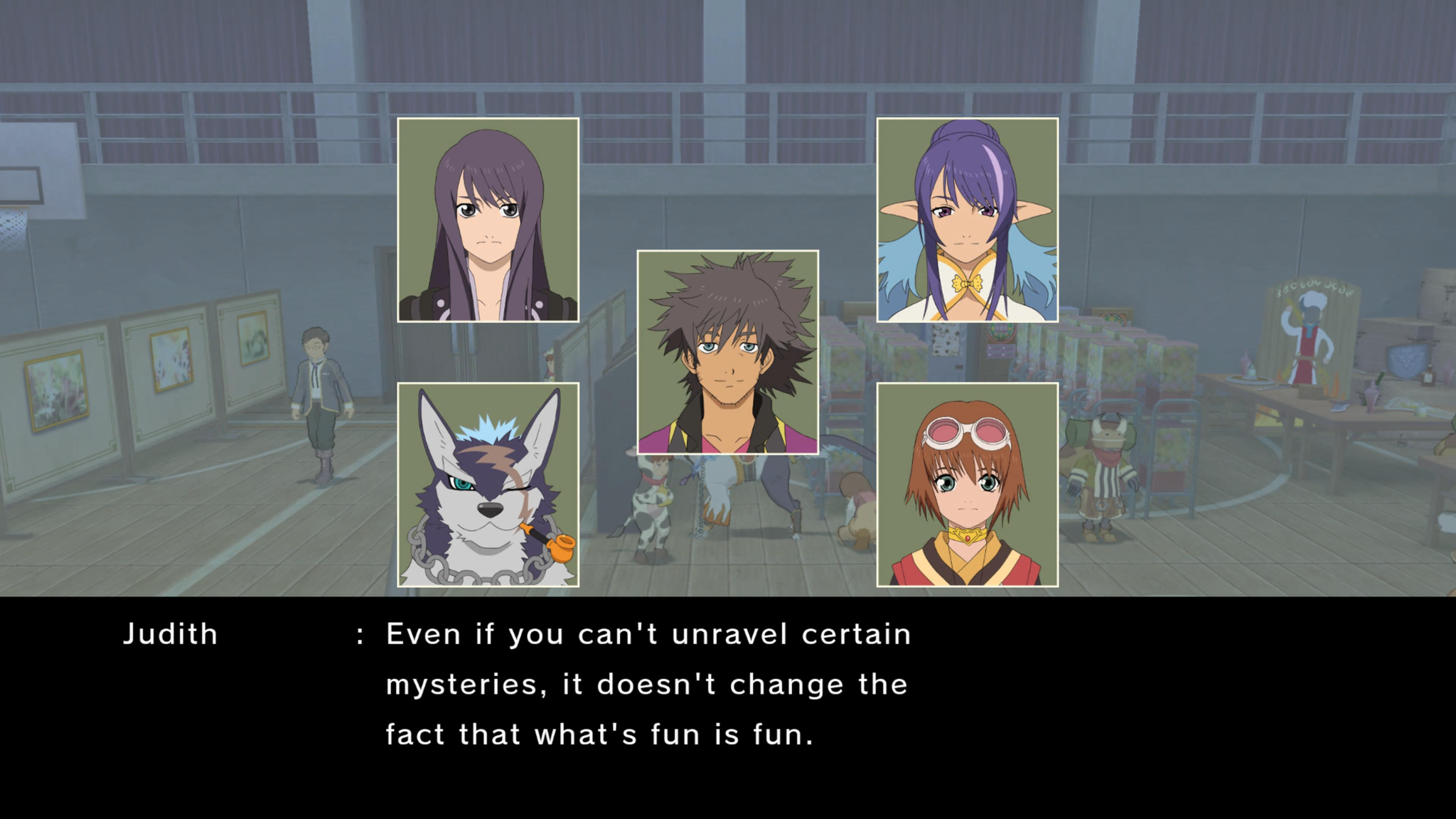
At Nam Cobanda Isle—the most self-consciously video-game location on Terca Lumireis—Judith celebrates the consistent theme that the world’s foundational mysteries form a basis for relating ourselves to others—in life, and in our playthroughs—through the identification and pursuit of our desires.
As games with multiple thematically relevant dimensions of choice, Tales of Destiny and Tales of Vesperia both invite you to play them again and again: internalizing the characters’ development, learning to shape your own story with the games in the same way that the heroes learn to shape their worlds: free, unencumbered, discovering not only your available choices but also what it takes to make them of your own principle of will, rather than basing them on the weight of your past, the game’s past, or the sheer volume of content overwhelming your sense of place within the tale. And then, eventually, you’ll put down the controller, turn off the consoles, and discover what you can’t turn off: the ethos, logos, and praxis which the games have uploaded to the model in your mind of how you stand in your own world.
The delicate harmony of Dymlos and Dein Nomos bears no essential reference to fantasy worlds, nor fictional worlds, nor video games. Look at the individuals in your life, at the individuals who could be in your life, and ask yourself how you can help them tell their stories; ask yourself which of their stories might help you to tell which of your own. Look at those in your past and ask yourself how you can express gratitude, not regret, at those who do not contribute to your present; ask yourself which elements of your past might be the tools, the methods, to help you understand where you wish to go next, without thereby thrusting yourself backward into your own history.
Play Tales of Destiny and Tales of Vesperia to tell your story through Stahn and Yuri. Then, take up Dymlos and Dein Nomos, and become Stahn and Yuri: carve out your place in the world by telling every story but your own.

- Special thanks to the “real-life JRPG party” of With a Terrible Fate’s Twitch followers, particularly users Grailzy5 and potterybreaking, for discussion of elements of Tales of Destiny, Tales of Vesperia, and the Tales series as a whole which significantly contributed to the development of this study. Thanks also to Eevee Suduiko, who largely inspired the character study of Repede. ↑
- There are both pragmatic and substantive reasons for my focus on these specific versions of Tales of Destiny and Tales of Vesperia. Pragmatically, these are the versions of each game which I ended up playing this year specifically for my Tales of Praxis program (re)playing and analyzing all of the Tales games; I’m also interested in making these analyses as accessible as possible by focusing on the most readily available official releases of each game in the English-speaking world. Substantively, as I hope is evident throughout this study, the complementary approaches to self-determination which I see manifesting in each game are all the more interestingly contrastive when looking at the relatively rudimentary representation of the un-voiced, 16-bit Tales of Destiny against the 100+-hour revised edition of a more “modern” Tales of Vesperia over 20 years later. Further, as I discuss below, the “Definitive Edition” of Tales of Vesperia stands in a theoretically and practically interesting complementary relationship with the original version of Tales of Destiny specifically through its additional content, “optional” relative to the original Xbox 360 version of Tales of Vesperia. ↑
- The Key of Lorelei in Tales of the Abyss, the Eternal Sword in Tales of Symphonia, and the Blazing Sword in Tales of Arise, to name a few others. It would be an interesting exercise to explore whether and how this study of the Swordians and Dein Nomos extends to the thematic content of these other swords. ↑
- Thanks to potterybreaking for pointing this out in conversation during the Tales of Praxis stream. ↑
- Emphasis added. ↑
- Different characters witness each other’s “home lives” depending on the order in which the player chooses to collect the Swordian masters: after Philia collects Stahn, the player can either have them collect Rutee followed by Garr, or vice versa. In the main text, I represent the order according to my own playthrough of Tales of Destiny. The main text also follows the outcome of my playthrough, in which Mary and the rest of the party save Dalis from Lydon; it’s possible, depending on the path the player takes through Phandaria, that Dalis might die rather than having the opportunity to rediscover his life with Mary. ↑
- Following the Don’s death and Raven’s betrayal, Raven does acknowledge that he thinks the Don was aware that Raven was working for the empire and that he took him into Altosk regardless. It’s possible, then, that the Don may have been similarly aware that Yeager was a pawn of some kind, even if he didn’t know all of the specifics; in either case, I think, the point—and the lesson for Brave Vesperia—is that Whitehorse took responsibility for his particular community within the world, rather than allowing himself (and, consequently, his community) to succumb to paralysis by remaining embroiled in a secret network of ulterior motives. ↑
- I discuss the relationship between Yeager and Regaey more directly below, but I represent them as distinct entities here because (1) they are perceived as such in terms of the public understanding of guilds and guild relations, and (2) as I read it, the game explicitly leaves the matter of whether the two are truly identical as an open question. ↑
- “The Truth of Ruins’ Gate.” When the party discovers Ruins’ Gate excavators at the Shaikos Ruins, they speak to this unresolved confusion: Estelle: “Hearing about Ruins’ Gate again makes me think of Regaey…” Rita: “Don’t forget that the Regaey we saw was an imposter.” Yuri: “Regaey was Yeager.” Karol: “Wait, I thought that Yeager was just disguising himself as the real Regaey.” Even when the party later discovers a Leviathan’s Claw merchant selling a hoplon blastia which those Ruins’ Gate excavators marked with their signature, Raven only muses that the Don, too, nursed the “hunch” that “Yeager and Regaey are one and the same person,” with no definitive proof that this hunch captured the truth of the matter. ↑
- Thanks to potterybreaking for pointing this out on the Tales of Praxis stream. ↑
- Thanks to Grailzy5 for pointing this out on the Tales of Praxis Twitch stream. ↑
- I recognize that the supplemental work Tales of Vesperia: The First Strike provides more background context here, but our goal in this study is to read the game according only to its own context. I would contend further, as I discuss below, that the lack of background history for Repede within the game thematically aligns with the way in which other threads of history are treated throughout the narrative, further warranting this form of interpretation. ↑



